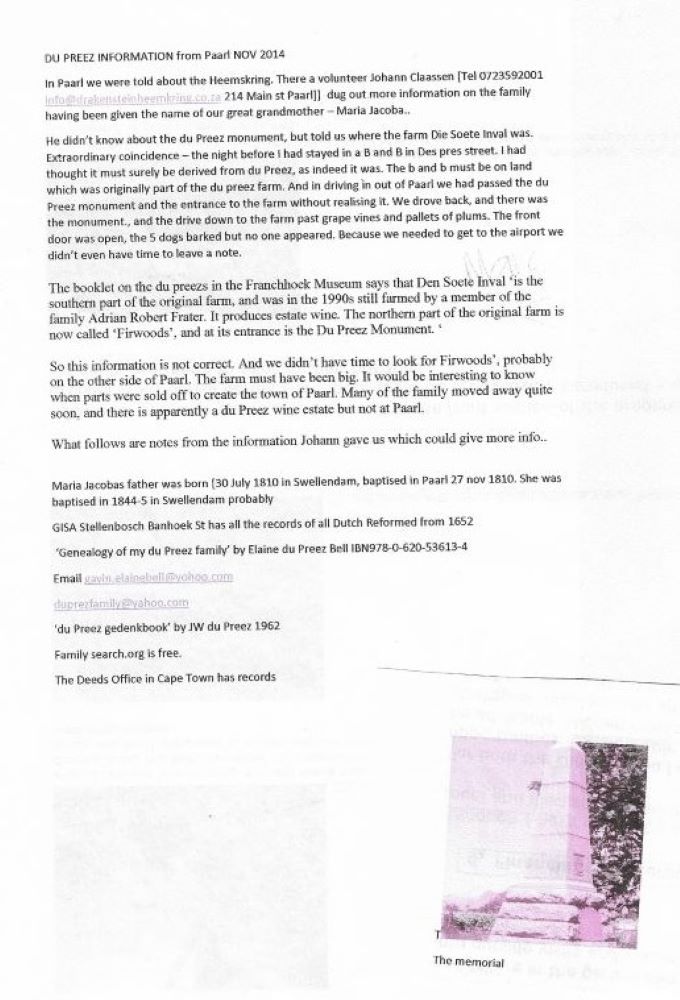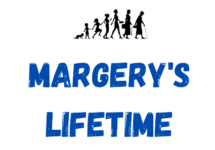CHAPTER 1: THE FAMILIES BEFORE AROUND 1840
1.2.1 A brief history of St Helena, and of the Knipes there
1.4 The Mortimers in England [not done]
CHAPTER 2: EDMEADES FAMILY IN SOUTH AFRICA
2.1 The First Generation [1840-c1890]
2.1.1 The early years 1840-1860
2.1.2 Mary Ann Margaret Edmeades [nee Knipe] in South Africa
2.1.3 George Mason Edmeades and the development of the family businesses
2.1.4 George Mason Edmeades – the person and the family
2.2 The Second Generation FROM RICHES TO RAGS [c1870-1920]
2.2.1 Elizabeth Catherine Edmeades [Lizzie] 1866-19171
2.2.2 Lizzie’s siblings – ‘THE AUNTS’
2.2.3 The house in Rudds Lane, Oudtshoorn
2.2.4 Lizzie’s married sisters
2.3 The third generation CHILDHOOD AND YOUTH [1900-c1925]
2.3.3 Growing up in Oudtshoorn, Knysna, Lydenberg
2.4 Allon and Muriel Povall [1921-1936]
2.4.1 Murie and Allon and the farm 1921-1928
2.4.2 Our visit to Lydenberg 2010
2.4.3. LIFE AFTER THE FARM for the Povall family [1928-1936]
CHAPTER 3: MORTIMERS IN SOUTH AFRICA[ not written]
3.1 The first generation 1855 –
4 The family of John Bazette and Martha Knipe
5 Other Edmeades data – William Penville Edmeades
6 George Mason Edmeades chronology
7 Other facts about GM Edmeades
9 Other data on members of the 1st family
10 William Knipe and Maria Jacoba’s children
What follows is the beginning of what I hope may become an intriguing and entertaining story of the lives of part of one family, those Edmeades and their descendants who form a direct line down to me. I hope others will add to it, and this of course will inevitably widen its scope. So it may turn out with a very different shape from the way it started. But for the moment I am writing personally because that is all I can do. I have tried to write an interesting story from those sources I have to date i.e. the end of 2011. I started my story telling because I realised that I was forgetting many of the tales my mother, Murie told me of her life 100 years ago. So much had changed in the century which seemed worthwhile trying to capture. I was also intrigued to know more of the two quarters of my family history whose names disappeared i.e. the Edmeades and the Kidsons. I come from a family of strong women, but my grandmothers’ family histories seemed to get lost if only the Mortimers and Povalls were investigated.
Then the project widened, as my niece Lynette assiduously provided the beginning of family trees. And then through the internet I made contact with Bazett Meyer, the holder of an amazing Edmeades family tree and other information. Then a tape of my aunt Marjory was found which I transcribed, as also the transcription of an interview with my mother Murie, done by my sister Peggy. Having written as much as I could from these, another source came, my cousin Patricia’s daughter Jane in Australia who had unbeknown to us also been beavering away. And later, letters from Ian Edmeades to Lynette Bredahl, followed by feedback from my cousin David Metelerkamp, and from Jane Scott. These all provided a mass of information, some confusing, some conflicting, and much of it raising many questions about the context in which our predecessors lived.
This is of course the nature of biography, or any research. It tends to raise more questions than it answers. I wonder, for instance, what different versions of family history my various cousins have. Perhaps one day someone can put them all together, and sort out the resulting jumble. I have concentrated at this stage on trying to tie reminiscences and other information to known dates and places in order to provide the possibility of someone someday being able to place these people in the wider economic, political and social context in which they lived. I realise how little history I know as I write. I feel I have started developing a relationship and some understanding of some of those involved but am frustrated by my lack of historical and local knowledge to put their lives into context.
Edmond de Waal in ‘The hare with the amber eyes’ talks of some of the issues for biographers. How much does on elaborate from sources, or quote directly giving the provenance of the quote. The latter breaks up the story but give authenticity, whilst the former potentially distorts or misrepresents. I have decided to risk breaking up the story by giving direct quotes when I have them. He also talks of living on the edge of peoples’ lives by writing about them. Should one leave them be. I have indulged myself on the period up until around 1936, and then decided to stop in order not to ‘live on the edge of anyone livings lives.’ I hope I have succeeded.
The structure to date is chronological, but with periods overlapping. The key dates for the South African families are those of the first arrivals, 1688[du Preez], 1839 or40 [Edmeades], and 1865 [Mortimer]. To date I have done little on the Mortimer story although there is plenty of material available. I have divided the Edmeades part of the story [i.e. the du Preez, Knipe and Edmeades] into five sometimes overlapping approximate periods:
The sources to date are:
Edmeades family tree from Bazett Meyer [Baz], started by others, updated by information from Lynette Bredahl:
Tape recordings from Marjory Metelerkamp Milly Yates and Muriel Povall
Hand written notes from Murie
Reports of conversations of Gwenda Franz
Internet material on St Helena, and the Huguenots, and other history
Letters from Ian Edmeades to Bazett and to Lynette
Glynis Snell’s book on the Knipes of St Helena
Material collected by Jane Scott
Material I collected from two days spent in the archives of Oudtshoorn museum March 2004 e.g. from newspapers, and from their other archives such as material on dates from Rev Beddy
Additional information and feedback from David Metelerkamp, and Jane Scott and others
My personal memories
The story shifts constantly as new pieces of data come my way. Just as I have built up what seems to me to be a coherent story, something turns up which makes me rethink and rewrite, or to question my original story.
What is lacking from all this are letters from earlier generations, so often rich sources of material for biographers. With the families moving round so much all these possible sources were presumably destroyed long ago.
Margery Povall – 2002 [with later additions March 2012]
[Version as at March 2012]
It was exciting to find through Bazette Meyer that my family’s roots in South Africa go all the way back to 1688. This is because our great-grandmother was Maria Jacoba du Preez whose forebears came to South Africa as part of the French protestant diaspora. Maria Jacoba married William Knipe Edmeades, and was remembered by her older grandchildren [my mother and her siblings]. She, like so many women in the family was left a widow with young children. More about that part of the story later.
This discovery of centuries old family connections with South Africa provided the opportunity to speculate once again on my childhood memory of what was to me the somewhat strange physical appearance of my mother’s Aunts from Oudtshoorn. It was inevitable that over the years in South Africa there had been mixing across the colour lines, whether through ‘legal’ marriages, or other liaisons. I remembered that some of The Aunts from Oudtshoorn on their occasional visits to Johannesburg had distinctly sallow almost yellowy skins and flattish faces. Was this simply the result of sunshine and dusty environments? Later I wondered whether perhaps part of our heritage is Koi, or San? When I wrote this in an earlier version of this history, Bazette Meyer suggested that ‘a marriage to a Malayan or Indian slave was more likely.’ So we have two possible sources of the Edmeades appearance – the Knipes in St Helena, and the du Preezs. Will the day come in South Africa where people will proudly research their hidden family history across colour lines?
There are various [sometimes conflicting] versions of the du Preez history, but what follows is based mainly on a publication by the Huguenot Memorial Museum Franschhoek in 2000. It is by RH du Pre and was originally published as an article in Historia Vol 41 No1 May 1996. It is titled ‘Hercules des Prez and Cecilia D’Athis: founders of the du preez family in South Africa’, and seems the most indepth study of the family to date.
THE FIRST GENERATION
Context
The Edict of Nantes in 1685 resulted in an exodus from France of protestants denied the freedom to worship as they chose. South Africa was one of the countries these people went to, mainly in 1688 and 1689. The term Huguenot was not used to describe these people until much much later. They were known as French Refugees [Fransche Vluchtelinger], Fransche Reformeerde Vluchtelinger, Free French Settlers, emigrated French refugees or the French Colonists.
Having fled from France [usually from the north] to Netherlands most sailed to their new countries from there. In total 299 French Refugees arrived at the Cape, a few before 1688/9 and a few after. But in 1688/9 181 left Holland for the Cape on eight ships. This French influx made a huge difference to the white population of the Cape, constituting by 1730 one fifth of the population of the Dutch East India Company settlements.
When they arrived they joined a settlement of only 1000 people including children according to the census of 1687. One third of these were slaves, and 39 ‘knechts’ [white indentured laborers?] Simon van der Stel the Commander welcomed the refugees and promised to help them, which he did.
The refugees were housed and fed in Cape Town for some months because although the majority had arrived by August of 1688, they only left Cape Town in October, once the Cape winter was over. Simon van der Stel himself accompanied the main party and allocated land as they went.
He hoped the French would spur the Dutch on to greater effort! But he was also determined that the Cape should remain Dutch not become French, so tried to scatter the French amongst the Dutch settlers when allocating lands to them. This created friction with some of the French who wanted freedom to live in French communities, and to have their own congregation and church council. There was disillusionment too on Simon van der Stel’s part. The Commander became disappointed with his new residents. He wanted them to learn the Dutch language [teachers had to be bilingual in French and Dutch], and to learn Dutch values. Three years after their arrival, three years during which they had needed to have support, he said ‘We find that they still have the fickle nature and that they are very much like the Israelites, who in spite of God feeding them in the desert, still longed for the onion-pots of Egypt.’ By then he did not want any more French refugees, but wanted ‘hard-working and devout farmers and labourers such as the Dutch and High Germans’
The support during this period for the French refugees came from various sources. In 1690 they [including the des Prez] received money from the Charity Board in Batavia, and other supplies from the East India Company. Without the means of transport, getting supplies to them from Cape Town and selling their produce back to Cape Town was very very difficult involving journeys of well over 12 hours. Horses were only for the more affluent.
Cecilia and Hercules [1] – the first generation
Both Hercules [from here on referred to as Hercules 1 because many other Hercules followed] and his wife Cecilia were born in France, he around 1645 and she on the 5th November 1650. Hercules was born in Kortryk [or Courtrais, now just over the border in Belgium], and Cecilia in Artois [[was Kortryk in Artois?]. When they arrived in South Africa in 1688 with their family they were in their late thirties or early forties.
They and their six children [aged around 17 to 7] sailed from Vlissingen in ‘De Schelde’ on 19th February 1688, part of a party of 23 French refugees. The journey sounds quite terrible. The ship was 140 feet long and 35 feet wide. They are not allowed on deck at all during the voyage as 150 sailors had to move around in order to work the sails. They had been allowed to bring only money [of which they probably had little] and minimal personal possessions such as tools of their trade, and of course a bible or book of psalms. Passage and provisions were free, but the latter consisted only of salted meat boiled in sea-water, pickled fish, hard biscuit, rancid butter, dried beans and peas and small amounts of water, plus two glasses of beer or wine daily. They had a brief stop at Cape Verde to get fresh water but had to leave before being allowed on shore because of fears of pirates. After storms at sea, they endured another storm in Table Bay for eight days after anchoring, finally being allowed ashore only on 5th June. After nearly four months at sea surprisingly no one died or was even seriously ill.

This is said, in a du Preez family document, to be the signature of Hercules!
I can’t see it.
In Cape Town they were housed and fed by a Dutch burgher until they left for the interior in mid October. They along with all the others were given basic supplies for their new life. The Charity Board of the Dutch Reformed Church gave money for bread, ship’s biscuits, dried peas and salt meat. The Company provided planks for building shacks and also money. They also got other household necessities to last for six months [supposedly until their first harvest]. This included wheat for sowing, seeds and seedlings, and agricultural implements, and clothing. The money was an interest-free loan to be repaid with wheat. Some burghers also gave them money and goods, and promised sheep.
So off they went on 15 October with twelve wagons which were driven by soldiers. After overnight stops the Des Preez arrived 9 days later in the valley south of Drakenstein where they were allocated land.
So there the family settled – Hercules1 a linen worker by trade, his wife and five children, their eldest Elizabeth having married very soon after arrival in the Cape – veld covered in fynbos, minimal tools, displaced Khoikhoi and San around, and no means of transport. They named this inhospitable land Den Zoeten Inval. But life was hard. Their wheat harvest of 1688 was so poor they didn’t even bother to harvest it. They and the other French continued to receive support in the form of money and other supplies in 1689 and 1690. In 1690 the family had received 510 guilders from the Charity Board in Batavia, as also other financial support. Hercules1 got supplies from the Company on credit to the value of 583 guilders, and his son Hercules 2 also got financial support. The credit supplies the settlers received from the company once again included food, building materials, building tools, kitchen utensils and equipment, agricultural implements and supplies, hunting materials, livestock [oxen, sheep, poultry].
But after that, on the part of the ground suitable for the production of wheat and wine they had good harvests within 3 or 4 years. From then on the family seems to have managed better than many of their disillusioned fellow countrymen. So much so that there are still [or were recently] du Preez descendants on the farm.
In 1692, four years after landing in South Africa Hercules1 owned 23 cattle, had planted 6,000 vines, had harvested 25 bags of wheat, 25 bags of rye and 3 bags of barley, making the family one of the most productive and successful of the French settlers. Along with other more successful French they probably hired help from Dutch neighbours. They were forbidden to barter with the Khoikhoi but did get livestock from them in this way.
In 1719 thirty years after their arrival a commission was appointed to investigate the indebtedness of the French Refugees. None of the Des Prez were on that list of indebted people.
A farm De Zoete Inval still exists. It is the southern part of the original farm, and was in the 1990s still farmed by a member of the family Adrian Robert Frater. It produces estate wine. The northern part of the original farm is now called ‘Firwoods’, and at its entrance is the Du Preez Monument.
Hercules1 lived for only 7 years after his arrival, dying in 1695 in a good state financially, with his assets larger than his liabilities. By then they had 414 sheep, 35 cattle and even the luxury of a horse. They also had a knecht or white servant. So life must have been much easier, and almost comfortable.
Cecilia lived for a further 25 years, remarrying in 1700. She moved from Den Zoete Inval to the home of her new husband Pierre du Mont, Zoeten Dal in the Lemiet Valleij. She left behind her only unmarried child Francois-Jean to run the farm. After Pierre’s death in 1716 Cecilia probably moved back to Den Zoeten Inval. She secured, in 1718 the sought-after Drakenstein wine-and-brandy monopoly or lease, comparable to a wholesale liquor licence for which she bid a great deal at the auction of such monopolies at the Castle.
Cecilia died at her farm on 15 November 1720, aged 70, and was buried in the church in Suider Paarl, the church having been dedicated just five months before. She outlived 2 husbands, a daughter, at least 3 grandchildren, and one great-grandchild. She left Den Zoeten Inval to her youngest child, Philippe, with the other children also benefiting. The inventory of her belongings suggested some affluence including an ox-wagon, 133 head of cattle and 272 sheep. She also had two male slaves, and a female slave.
She also left a unique document. It is the Du Preez family certificate of church membership from the French Walloon church, dated 11th February 1688. This is unique, the only one preserved, and is in the Cape State Archives. Several attempts to access this site have failed. It seems to have been withdrawn.
There are reminders of Cecilia and of Hercules1 in Paarl today. There is a Cecilia Street. This, east of Paarl station, runs south across the N1 to the farm. Cecilia’s Drift on the Berg River ‘has existed from the time Den Zoeten Inval was established. There are two bridges at the drift, one on the old road and the other on the N1. The latter carries the new route through the Huguenot Tunnel in Du Toit’s Kloof to the interior’. There is also a suburb De Zoete Inval, and Des Pres, Datis, Hercules, Cortryk, and Schelde Streets. Courtrai which lies on the mountain side of the main road in Suid Paarl was also part of the original Des Preez farm.
THE SECOND GENERATION
Our line comes through their eldest son Hercules2, so we will concentrate on him. He sounds an interesting character. Born in 1672 in France and arriving in 1688 with his parents, at 24 [in 1696?] he married a much older Frenchwoman Marie le Fevre [Febure?] [born 1651, so aged 45 at the time], who came from Calais[Marck, Picardie?]. They had one son [Hercules 3] and one daughter. After Marie’s death in 1701 he married again [in 1702 or 3]?, this time a much younger woman, Cornelia Viljoen [Villion]. He acquired other farms, and became a member of ‘hof van landdrost en heemraad van Stellenbosch, captain of the ‘Burgher Kavallerie’.
But Hercules2 pitched into local politics and activism and got into trouble for this. In 1707 he was sentenced to a five year exile in Mauritius and a fine of £41.13s.4d, and certified incapable ever to hold a public or military position. He had refused to appear in court for his opposition to Governor Willem Adriaan van der Stel. Just before departure he, along with Adam Tas and other burghers, was released. He is described as stubborn and fiery-tempered. ‘The Du Prez’s were not easy people to get on with. They were easily irritated and were often at variance with some of their neighbours, yet they were never in trouble with the law’ [except hercules2!]
But he and subsequent Du Preez were becoming ‘Dutchified’ with the spelling of their name changing to reflect this. Their first names was also changing e.g. from Pierre to Pieter.
SUBSEQUENT GENERATIONS
Hercules 3, our next ancestor, was born in 1697 when his mother Marie was 46. He married Elisabeth Theron [possibly a cousin] [again in Paarl] when he was 26 and she 18. This was in 1723. They had at least four children. Apart from our ancestor Hercules Christiaan [Hercules 4] there were Jacobus Petrus, Johannes and Cornelia.
Their son Hercules [4] Christiaan was born three years later in 1726 [also in Paarl], and when he was 44 or 45 in 1771 married Regina Catharina Vogel. Apart from Hercules Johannes [Hercules 5] our ancestor, they had at least two other children, Cornelia Cecilia, and Johannes Christiaan
Hercules [5] Johannes was born two years after his parent’s marriage [in 1773] in Stellenbosch. He was described as a farmer and lived to the great old age of 76 or 77. When he was 27 or 28 he married Catharina Magdalen van Zyl in Cape Town, and they had 14 children of which our forefather Johannes Daniel was number 7 [at last an ancestor who wasn’t a Hercules].
[The other 13 were Elisabeth Maria, Regina Cornelia, Sophia Magdalena, Herculana Johannes, Jacobus Hercules [or Hercules Jacobus], Gideon Petrus, Cornelia Cecilia, Jacobus Petrus, Christoffel Philippus, Daniel Abraham, Maria Martha Anne, Johanna Philippina Jacoba and Catharina Magdalena]. They managed to find 30 names for their children, with only 3 duplications.
From this time on we know a little more about the wives of all these Hercules. Catharina [Hercules 5’s wife] was born in 1780 at Oudtshoorn Bossieveld, Robertson. She was the daughter of Gideon van Zyl and his wife Elisabeth Beukman. Hercules 5 died in 1850 [aged 77] at Goudini district Worcester [which is where Murie said her grandmother Maria Jacoba came from]. So the family had gradually spread out, acquiring land in places other than Paarl. His wife Catharina also lived to a great age, dying aged 80 or 81 in Stellenbosch. These were our great grandmother Maria Jacoba’s grandparents.
We move away [with some relief] from Hercules’s when we get on the information about Maria Jacoba’s parents, We are also moving further and further East as the family spread out away from Paarl. Her father Johannes Daniel was born in 1810 in the Swellendam district. He was a farmer at Andrieskraal in the Swellendam District. And when he was 23, in 1834 he married Elizabeth Catharina [or Katrina] Jacoba [Hendrika] Lourens.. She had been born in 1816 at Gouritsrivier district Mossel Bay. Her parents were Johannes Christoffel Lourens and Elisabeth Margaretha van Zyl.
[Elisabeth van Zyl was only six years younger than Catharina van Zyl, Johannes’mother, leading to the speculation that these two women were possibly related. Did Johannes marry his aunt [his mother’s younger sister], or some other relation of his mother’s?]
Johannes Daniel and Elizabeth Catharina had eight children, of which Maria Jacoba, our great grandmother, was the fifth, born in 1844. Her siblings were Elizabetha Margrieta, Hercules Jacobus, Catarina Magdalina, Johan Christoffel, Regina Cornelia, John Daniel and William Louwrens.
Maria Jacoba’s life
After all these names and dates about her family, what do we know about Maria Jacoba as a person? Very little unfortunately.
We know that when she was 20 she married William Knipe Edmeades in June 1864 at Humansdorp. But we don’t know how or where they met. And whether there was any reaction from either family to the fact that he was English speaking, and she Dutch or Afrikaans. We also don’t know when or why her family had moved to Humansdorp. It is a long long way from Paarl, and even a considerable distance from Oudtshoorn.
We know that she and William Knipe[WK] lived in the Humansdorp area for some years. He was in Oudtshoorn in 1863 but it was perhaps after that that he moved to pastures new near Humansdorp where he met and married Maria Jacoba. Already in 1864 he was declared insolvent in Humansdorp. He didn’t however appear to give up and return to Oudtshoorn because in 1872 he was described as a farmer on Langehoogte in the District of Humansdorp. So it seems that their first five children including our grandmother Lizzie were born there in Humansdorp.
WK seems to have returned to Oudtshoorn [perhaps on and off?], and certainly in 1877. But perhaps Maria Jacoba stayed in or near her family in Humansdorp?
Ian Edmeades gave some clues [in a handwritten note] as to where the du Preez family were and therefore where WK and MJ may have been. He says that his mother’s family, the Gerbers came from Germany and ‘settled in the Longkloof. My mother’s parents owned a very large farm across the Kouga River and mountains. The Provincial road went as far as the Kouga river and my grandfather had to build the road across the river and over the Kouga mountain to an extensive valley between mountains where he had his farmhouse with lands and grazing extending as far as the eye could see. The Gamtoos river has its origins where the Kouga and the Grootrivier converge. This is where the du Preez farmed. My parents bought adjoining farms about 10ks upstream from the du Preez and within 1k of the Grootrivier. My father bought his farm under the post world war I resettlement scheme and my mother bought the adjoining farm. The properties were about 3ks from Cambria. It was possible to walk from there across mountains to my grandfather’s farm. When I took Maisie[Ian’s wife] to see the farm some years ago we drove from Port Elizabeth through Humansdorp, then towards the Longkloof; ultimately we parked on the banks of the Kouga river and then went by four wheel drive across the river and mountain to the farmhouse in the valley beyond.’
Knowing so very little about Maria Jacoba our great grandmother, what follows are snippets from various people. In 1919 William Penvil [Secundus] our grandmother’s eldest brother was on his way to visit his newly married brother Laurie. He stopped off at his du Preez cousins at Andries Kraal, went down with flu and died there, Laurie having rushed over to see him. Presumably these cousins were Maria Jacoba’s brothers’ children. [Hercules, Johan, John or William]. The name Andries Kraal is interesting, because this had also been a name from the Western Cape history.
Murie remembered her grandmother as being ‘very small and very Afrikaans’, and coming from Goudini in Stellenbosch, a long way from Humansdorp. This is interesting because the connection with Goudini went a long way back to Maria Jacoba’s grandparents, but perhaps she [MJ] felt that this was where her roots were.
Gardie remembered her grandmother living with her daughters in a house up St Saviour Street in Oudtshoorn. ‘Granny was a very tiny little person and she had something radically the matter with her, and had to have the doctor come and tap something out of her [if you blow up and have a bad heart?] She was very delicate and the doctor perpetually calling.’ This must have been a few years before her death in 1911 at the age of 67. Having learned a few years ago that our grandmother, Maria Jacoba’s daughter died of asthma, I wonder if this too was Maria Jacoba’ problem. There was, and perhaps still is a lot of asthma in the Edmeades/du Preez family. I have asthma, as also did Bazette. So did his mother and her sister. And Ian said Lawrie did, and as a child Ian himself.
The only hints of Maria Jacoba’s Afrikaans or French or Dutch background in her children’s names were that one son was called John du Preez, and a daughter Anna Maria who died aged nine months, and another daughter named Catherine Sophia. All the others had very English sounding names.
So many questions which contact with the du Preez’ might answer. And a detailed map of the area or a visit would also help.
In November 2009 I wrote to all the five du Preez that I found in the Humansdorp area in the telephone directory. Three were eventually returned either ‘Unknown’ or ‘no such number’. Several addresses looked like names of farms. I did not try and phone, assuming they were probably Afrikaans speaking, and feeling unsure about my ability to communicate in a friendly and unthreatening kind of way. Thys du Preez, the holder of most information on the [male] du Preez history suggested that those that did receive the letter might have been old, and not felt obliged or able to reply. But he said there were two Jan Daniel du Preezs in Humansdorp, one born in 1960, the other in 1994. ‘Some Jan Daniels also had the nickname ‘Jan Jocka’ and I see the couple above christened their youngest son Jan-Jocka.’. He suggested other possible first names e.g. William Melville, Pierre Reniers, Philip Christophers and Renier van Rooyen.
The first Edmeades’ to settle in South Africa did so from St Helena around 1840. Mary Anne Margaret Knipe, wife of William Penville Edmeades came from an old St Helena family. Her family had been on St Helena from the mid 17th century. We know quite a lot about them because of the painstaking research conducted by Glynis Snell. So although Mary Anne Margaret and her husband William Penville Edmeades left the island for South Africa around 1840, we can trace our Knipe family background much further back.
Britain had taken possession of the island in 1659 from the Dutch, and settled colonists there soon after. The island flourished under the East India Company as an alternative harbour for the sailing ships to that in Cape Town, and as a trading and refreshment, and whaling station, and then as the place of Napoleon’s exile, from 1815-21.
But early in the 19th century the economy declined, in part because slaves were set free, their freedom being purchased by the East India Company apparently for £62/17/0 in total. Before this, in the 1814 census the Island had only 694 civilian whites and 933 civil and military staff, but 1200 blacks [presumably slaves as there were also 420 ‘free blacks’], and 247 Chinese.
It became a Crown Colony when the British government took over the administration of the island in 1834 after the East India Company failed. They fired all employees of the company, and in 1838 removed the subsidy to the island, which had previously been paid by the EIC. In 1836 Darwin found the island poor, with, he estimated, about 5,000 inhabitants. The economic conditions were therefore very hard from the 1830s on, and from 1838 there was a mass exodus of 2000 young people. Families and more than a hundred young men emigrated to South Africa. This included our ancestors, Mary Anne Margaret [nee Knipe] and her husband William Penville Edmeades.
Mary Anne Margarets’ family had been on St Helena for more than 150 years when she was born in 1821, the first Knipe, John [born around 1660] being there by 1682 and marrying Ann Seale there in 1689. He [and probably she] had been born in England..
A contributor to the St Helena forum on the Internet said the Knipes seemed to have married into almost every other family, perhaps not surprising, as the non-slave population was quite small. Family names from the Knipes which were in great-grandfather’s brothers’ names and those of subsequent generations were Mason, Bazett, Leach and Orlando. My great-uncle Leach Edmeades, for example, was christened Leach Mason Knipe, and his son was Mason.
There is an interesting tale in Glynis Snell’s book involving a dispute between John and a woman who claimed he had promised to marry him [when he was about to marry Mary].
We have his will dated 1695 in Appendix 1, leaving money and cattle to his mother if she came to the island, and his estate to his wife and two children, [his third child being born after he died]. No signs of affluence.
Our line down to Mary Anne Margaret Knipe who with her husband William Penvil [or Penville] Edmeades came to South Africa, continues through four generations. These are
– John and his wife Ruth Quinney
– Isaac [and his wife Flora Mason and their two sons Samuel and Richard
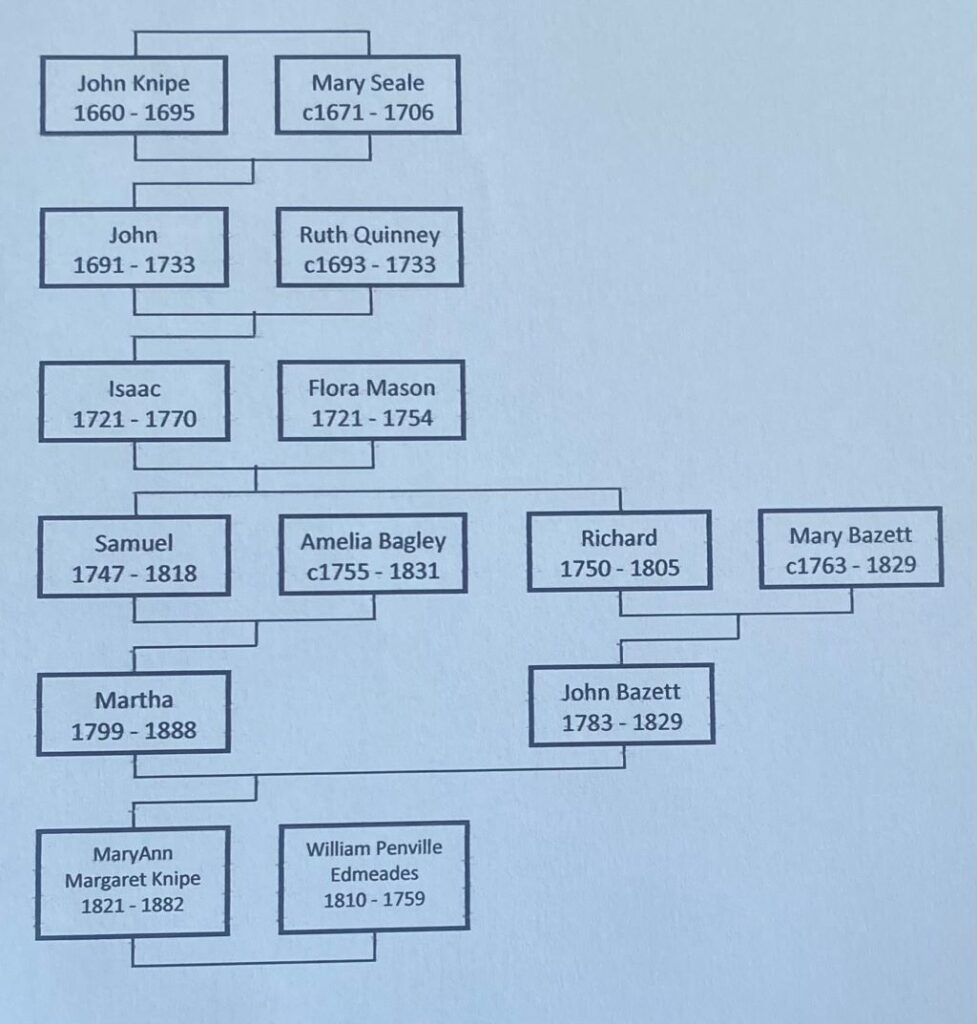
– Samuel and his wife Amelia Bagley, and [somewhat confusingly in terms of straightforward family trees], also Samuel’s brother Richard because their children married each other.
– Richard and his wife Mary Bazett, parents of John Bazette Knipe
– Martha [b 1799] and her husband John Bazette Knipe [b1783]
– Mary Ann Margaret [MAM] [b 1821]
So Mary Ann Margaret’s parents were cousins.
We have quite a lot of information on her grandparents, some of it confusing, but giving a picture of life in St Helena at the beginning of the nineteenth century
RICHARD AND SAMUEL KNIPE, MAM’S GRANDFATHERS
Her two Knipe grandfathers were sons of Isaac and Flora, Samuel three years older than his brother Richard.
Samuel seems to have flourished on the island. In 1810 he owned nearly 200 acres, half freehold half leasehold. He owned 10 able bodied slaves, and 2 infirm.
But his brother Richard reportedly died bankrupt in 1805. They had both owned many different plots of land, but between 1776 and 1800 Richard was leasing out many pieces of land to others.
Richard had become an East India Company Cadet in 1774 aged 24, was promoted to Lieutenant in 1775 and was’ for many years a member of St Helena military establishment’. In his will of 1805 he is described as ‘an Invalid Officer in the Honourable Companys’ Service’. He lists 3 female and 4 male slaves [leaving each of his children one slave], plus two male servants. And he still had some land but seemingly also debts, so his widow and children would not have been left with much. His son John was left property, which we know was successfully retained, as in 1863 some members of the family were still living there at Half Moon,[and six of his children were born there? – my copy lacks some info] .
Richard had married Mary Bazette in 1778 and there seems to be some mystery about her origins. For all the careful record keeping [births usually recorded when the child was baptised], Mary’s baptism certificate lists her mother as Elizabeth, not her mother Marys name. And her grandmother doesn’t mention Mary in her will. So was her parentage in doubt? A possible slave link?
Back to Samuel and his will of 1817. [see Appendix 2] which provides a fascinating insight into the life and family relationships of Samuel and his surroundings. And, in addition provides yet another source of unanswered questions about our family.
The context of the March 1817 will is that Samuel’s two youngest children, twins Martha [ MAMs mother], and Charlotte were 17. Neither were married but later that year Martha [our ancestor] was pregnant, and still not married.
In Samuel’s extensive March 1817 will are many references to named slaves [at least 20] who are bequeathed to his wife and children and it ends ‘My servants not given away in my will I request each to be allowed the choice of his or her master or mistress.’.
This will of March 3rd explicitly excludes two of his daughters Elisabeth and Martha from the bulk of his estate, each being left only £100, but significantly does not exclude Charlotte, Martha’s twin. All the other children including Charlotte were left houses, land, money and slaves and equal shares [always deducting the sums he had already given them]. The reason for Elisabeth only being given £100 and ‘she is not to share in any part of my estate with my other Children’ was because she ‘married against my consent’ one John Lam. Her daughter was however left £100.
So Elisabeth was being punished for going against her father’s wishes. But Martha? Why was she singled out? She was given the hope of coming into more of the estate, because in the event of her ‘marrying with my consent she is to share with my other children’. So it seems that at 17 Martha was known or suspected to be in a relationship with an ‘unsuitable’ man. Samuel had a fear obviously of his estate falling into the hands of ‘unsuitable’ men. Presumably at the time any assets of a wife were regarded as being the property of her husband.
Charlotte Martha’s twin was to share in the estate, with no mention of her losing any of it if she married ‘inappropriately’, and she was given two slaves. So she was not seen in March 1817 to be a problem, [nor had she already been given property or money earlier, which excluded some other members of the family from being fully acknowledged financially]
Samuel was however capable of softening his stand, because on the 18th April 1818 a year later, he added a codicil. One wonders what exactly had gone on in that year. By 18th April 1818 Martha had married her cousin John, presumably a man of whom her father Samuel approved, and so she was given a further £400 and 3 named slaves. So Martha was not after all likely to be too badly off when her father died.
Also in the codicil Elisabeth, the wife of the disapproved of Captain Lamb was now given a further £300.
When Martha and her cousin John were married on 4th March 1818 she was very pregnant, her first child Robert being born on 5th June 1818. It seems unlikely that John was Robert’s father, but intriguing speculations arise as to who was. And also what happened to Robert because records show only his birth, nothing subsequently.
When I visited the Oudtshoorn museum, Hilda Boshoff told me that there had been talk that the Edmeades’ were related to Napoleon. Glynis Snell’s research throws some light on where this story came from. There were several references to ‘the beautiful Miss Knipe’ [le Bouton de rose, or rosebud] on St Helena, and speculation that this was Charlotte. In 1816 there were references to Miss Knipe visiting Napoleon [why only one, if there were twins?].
Glynis Snell says ‘It has been claimed that the supposed liaison between ‘the Rosebud’ and Bonaparte resulted in an illegitimate child.’ There only seem to be three Knipe young women to whom this could have referred, the two most likely [because of their age] being Martha and Charlotte.
The truth will never be known but we can produce various scenarios.
If a Miss Knipe was visiting Napoleon in 1816 it seems more likely to have been Martha who was disapproved of by her father, than Charlotte[ unless her father knew nothing of her visits]. Feelings against the French ran high, and in 1817 Charlotte was in her father’s good books whereas Martha was not. Martha certainly seems to have been ‘visiting’ someone because later in 1817 she was pregnant. So who was Robert’s father? Napoleon?
Samuel, MAM’s father died in 1818 and in July 1819 his widow Amelia/Emilia had a trip to England. Did Charlotte her one unmarried daughter accompany her, before returning to the island for her marriage in June 1820?. It has been suggested that Charlotte [le bouton rose?] perhaps had a child [Napoleon’s] whilst away from the island? Or did Amelia, Martha’s mother take Martha’s son Robert with her to leave him somewhere in Europe? Apart from being born there are no further records of him. Who was Robert’s father? It seems unlikely that it was John, Martha’s husband.
It would please all the Edmeades in the family who hope for prestigious connections to think that our ancestor Mary Ann Margaret had a half brother who was the child of Napoleon Bonaparte.
Another intriguing issue from the Snell research is that of Charlotte’s husband’s parentage. Her husband Daniel Hamilton was born before his father married Charlotte Bagley in 1799, one of three such children. ‘Daniel, son to Sergeant D Hamilton and Ann [free] born ca 1796, baptised 20 Nov 1796’. This suggests that his mother was of black, or Asian slave descent. [not Chinese as they arrived later]. Baz had denied that there were relationships across colour lines which seems an unlikely assumption. But this shows that such relationships were officially recognised.
John Bazette and Martha had 11 children including Robert. [SEE APPENDIX 4] of which our ancestor Mary Ann Margaret {MAM] was their third, born in 1821 [in time for her to be fathered also by Napoleon?].
Mary Ann Margaret {MAM} married William Penville Edmeades from England in 1836, aged only 14. And they left St Helena. Some time between 1838 and 1841 the couple with their first son George Mason, left St Helena for South Africa. [It seems likely that it would have been 1838 or soon after because this was when it was said so many young people did leave.]
MP March 2012
Every family history gets interesting when a black sheep is discovered. Our Edmeades family delvings have not yet uncovered one. But they have uncovered mysteries and raised unanswered questions, questions to which it seems unlikely to get answers. What is surprising is how much the various family members have managed to unearth – about the Knipes in St Helena, going back to 1660 or 70, the du Preezs going back as far as 1688 to Europe, and the Mortimers and Haigs in Yorkshire going back to before 1865.
It is interesting that on the whole we know more about members of the family who didn’t start life in the UK than about William Penville Edmeades, who did start life in the UK, where there are many sources of quite reliable information on ancestors.
William Penville [or Penvil] the first English born Edmeades to settle in South Africa, remains something of a mystery in spite of various members of the family researching his possible origins. We could call this ‘The hunt for William Penville Edmeades, the Edmeades pimpernel’ – not scarlet or as colourful, but still very elusive. The results of the researches of family members are reproduced in full in Appendix 5 in order that others following do not simply reinvent the wheel.
Perhaps the one indisputable fact in all this is that the Edmeades family were a well known firm of papermakers in Maidstone called Edmeades and Pine. And there are still Edmeades descendents living in Kent at Nurstead Manor in Meopham now a conference centre.
Beyond that is supposition about William Penvil because although we have a birthdate and place for him one possibility is that he simply made them up when he was marrying Mary Ann Margaret [MAM] Knipe in St Helen in 1836.
The facts as presented by William Penvil [or Penville] Edmeades when he married, were that he was born in England, at Maidstone on 10th April 1810.
And we know from St Helena records that in 1836 William Penville was in St Helena, marrying MAM Knipe, aged 14 or 15. He was reportedly 26 years old. And we know that by 1841 [ aged 31?] he was in South Africa with her and their first child.
We have various possible versions of ‘the Edmeades pimpernel’s’ early years in England.
1] According to one family tradition, William Penville ran off to sea rather than following the vocation chosen by his family. A version of this, from Ian Edmeades’ father some seventy years ago, was that William’s father wanted him to be ‘a man of the cloth’ and to escape this he left home. The Edmeades being involved in East Indian trade, St Helena figured in this story.
2] Jane had another source of possible information on our elusive ancestor. There was a mention of a William Edmeades as a child on the Pauper’s List from Maidstone. Could this have been the same William who had been in trouble ‘for being a kind of early 1800s street child’? Was he perhaps the son of an unmarried Edmeades woman thrown out for her indiscretion?
3] Jane has now provided another possible scenario which is that William was not an Edmeades at all, but simply adopted the name of a well known Kent family when he got to St Helena. This one, if true, has particular irony. Many of us are interested in and researching ‘the Edmeades’ family. Is it possible that none of us are actually descended from the Edmeades’s? What are we?
Whatever the truth of William Penville’s origins in England we don’t know when, how or why he went to St Helena. All we know is that he was there in 1836.
Perhaps we might find out more about his origins if it were discovered that the Edmeades family in Kent was baptised privately not in public. This is because for information before reliable census records in 1841 public baptismal records were the best source of information on people’s births.
But meanwhile there have been various suppositions. Research has shown that he was not a cadet in the East India Company or in the armed forces which could have taken him to St Helena.
One suggestion was that he was a sailor, and jumped ship at St Helena. This could fit with the idea that he was a child pauper who might have stowed away or joined a ship. [But I think someone researched the crew lists of ships and did not find him?].
Another suggestion was that William possibly went to St Helena because there was already a relative there. It has been suggested that a William Edmeades [born 1803] was recorded as living on the island [baz], and family legend says that there was an Edmeades, Captain William in the force that was guarding Napoleon on the island in 1806[Mur]. If these are true, perhaps ‘our pimpernel’ heard of and was influenced by this.
So the family may after all have a black sheep but one who slipped through official records, so we will never know. We have to be content with a mystery.
MP Mar 2012
The Edmeades I grew up knowing about were The Aunts, my maternal grandmother’s sisters, a legendary group of Edmeades women who lived in Oudtshoorn. Their brother Leach and his family were the other Edmeades we knew. What we were told was that part of the Edmeades family had been very wealthy, and one of the heritage houses in Oudtshoorn was an Edmeades one, but not alas our branch. The ostrich feather trade had provided great prosperity during its boom periods. But in my lifetime the Edmeades Aunts were reduced to genteel poverty. They were the survivors of the seven girls of their generation, my grandmother, their eldest sister Elisabeth Catherine having died long before. So it was the four of these younger ones – Mary, Ethel, Rene and Edie who were ‘The Aunts’ to all of us.
But they were the second generation of Edmeades in South Africa, [and descendents also of much earlier arrivals, the du Preez].
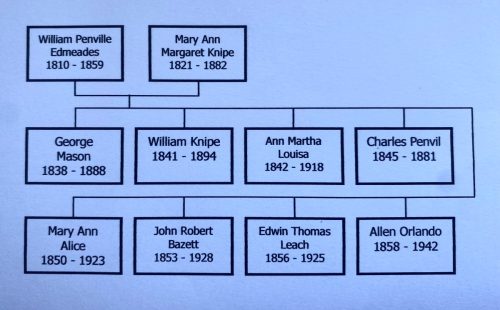
The Edmeades story in South Africa starts some time between 1838 and 1841 when Mary Anne Margaret [MAM] [nee Knipe] and William Penville Edmeades arrived from St Helena in South Africa with their first child, George Mason. We know little of those early years. But because economic conditions in St Helena at the time were deteriorating it seems likely that the young couple had little money, that they arrived, in current parlance as ‘economic migrants’.
It is also likely that they went to South Africa because the British government was offering incentives to people to emigrate in order to reduce the population of St Helena, and increase that of whites in South Africa.
We know that MAM was not the only Knipe to end up in South Africa. Her older sister Amelia married James Anderson in Cape Town on 10th December 1839.[Jane]. And her cousin Douglas Mortimer Hamilton [son of her mother’s twin Charlotte] was also in South Africa, dying there in 1900.
The family possibly landed in Mossel Bay as that is where they lived for some years. There William Penville worked as a painter before settling on the farm Zuurflakte.
However Jane discovered an application from W Edmeades in 1842 for ‘permission to retail liquor’. So he must have been running a store of some kind by this time, perhaps in parallel.
However by 1853 the family had moved to Oudtshoorn, onto the farm Zeekoegat. [This was said by Hilda of Oudtshoorn Museum to be a large farm half way to Calitzdorp on the banks of the Oliphants river.]
There in 1859 William Penville died aged 49 leaving a widow and eight children. The most we know about him at this stage is that his widow MAM and children later paid for a window in the new St Judes church in Oudtshoorn to commemorate him.
This window was given in a period when Oudtshoorn was developing fast. From the leaflet in the church we know that the original Oudtshoorn was 3km south, founded only in 1847, becoming a municipality 40 years later, just as the family fortunes disappeared. In this small settlement there was talk in the 1850s of building churches for the NG and RC congregation, and by 1859 for the Anglicans [of whom there were at that stage only 17 men, with only two owning property]. It was in this year 1859 that many of the Edmeades were baptised, presumably by a visiting clergyman.
Bishop Gray had consecrated four churches in the region in 1855, including that at Knysna [our Mortimer great great grandfather’s church?]. Ground for the Anglican church in Oudtshoorn was registered in 1860, but there were difficulties raising the money locally, and it was finally consecrated only on 26 September 1863. It was enlarged over time and it must have been one of these periods when the family paid, in 1880 for the window dedicated to William Penville.
By 1870 Oudtshoorn must have been transformed by the ostrich feather boom.
So William Penville died in 1859 apparently having no part in the Edmeades 25 year expansion in and around Oudtshoorn, as Oudtshoorn itself grew from a small settlement to an important commercial centre. From then on until 1886 when bankruptcy ended it all, the Edmeades’ were an important, indeed a key part of Oudtshoorn’s growth. And this success [and finally failure] were driven by MAM and William Penvilles first child, George Mason, born in St Helena and brought to South Africa as a very young child.
So where did William Penville’s death in 1859 left MAM , aged 37 a widow with eight children, the youngest Allen only a baby?. Only George Mason and William Knipe [the latter aged 18] could have been said to be adults. Ann, the next was 17, Charles Penville 14, Mary Ann 8 or 9, John 5 or 6 and Edwin only 3.
MAM seems to have been a remarkable woman, although we know little of her as a person, or of her life. She had probably grown up in reasonably comfortable circumstances in St Helena, come to South Africa before she was 20, already married with a child and probably in poverty. Then after perhaps establishing a relatively comfortable life on the farm she was left to cope on her own with young children. So once again she managed with presumably few resources. No wonder she has come down in history as a woman to be proud of, as witness the following tribute in a preamble to the Edmeades family tree [author uncertain].:
‘When taken into account that she was only 37 when her husband died, stranded in a new country with 8 children, the eldest not yet 21 years and the youngest not yet 9 months, then her descendants can be proud to have her as an ancestor .Comparing the names of the first generation to the surnames of the Civil Servants of St Helena, in 1785 it is clear that she came from a well-educated family. When the history of her children is researched, it is also clear that her upbringing was passed on to her children. It is with pride that the author of this web page claims to be a descendant of such a remarkable woman.’
I have long been aware of being part of a family of strong women, who have survived many hardships, often being the sole or main breadwinner. Since learning of MAM, it seems these strengths and values can be traced back many generations.
But there are others, her two eldest sons, and perhaps her daughter Ann, who must have played an important part in keeping the family going during the difficult years after their father’s death when the other children were young. At least two of these youngsters John, and particularly Edwin had the upbringing, self confidence and education to enable them later to become successful business men.
But there are many questions about how the family survived both before and after the death of WP. For instance, education. Did the children go to school, and if so where and when? Perhaps MAM educated the children herself? In which case what education had she had in St Helena? The most likely answer would be home education with a governess. But we don’t know. There seems to have been a strong emphasis in the family on education, even for girls, which seems most likely to have come from MAM. In South Africa there were few formal English language education opportunities available for girls in Oudtshoorn even when Gwenda was at school in the 20th century. [She had to be sent to school in George]. On 30th July 1879 the Courant tells us that a school for girls opened ‘Jonge-Jufvrouwen’ at the cost of £48 pa. Was this the first school for girls in the town?
There was obviously an English language school for boys by 1886 because AB Mortimer got a school prize there in December 1886.
How long MAM stayed on the farm Zeekoegat is not known. Her eldest son George Mason was making a living in Oudtshoorn even before his father’s death. William Knipe her second was also working in Oudtshoorn, and then moved away to his wife’s family in Humansdorp. Ann, the third married. Charles probably soon got absorbed into the family businesses. So either MAM ran the farm, or it was sold and she moved, presumably into town.
Mary Ann Margaret Edmeades died aged 59 in 1882 in Oudtshoorn, living at the time with her second son William Knipe and his wife Maria Jacoba [our great grandparents], not as one might have expected with her successful eldest son GM or her married daughter Ann. She left an estate of nearly £500, having been reportedly living on the interest. [baz] [This sounds like a not inconsiderable amount] Did this money come from property on St Helena, or from the Edmeades family business, or from selling the farm?
The Oudtshoorn Courant’s [5/9/1882] notice of her death gave her age as 59 years, 11 months and 25 days. She could not therefore be described as being 60! Four sons, George, William, John, Edwin, and grandsons followed the hearse [where was Allan?], followed by daughters, daughters in law and grand daughter in vehicles, and about 500 members of the general public. Nothing more about her or her life [she was after all only a woman!]. She was taken to the English Church, then to the English Church Cemetery.
This lack of more information about MAM [who was described by her descendents as a remarkable woman] highlights one of the issues about biographies of people long dead. Men may appear in public documents as landowners, owners of businesses or employees, members of clubs or committees, law suits, and so on – the public world. The official and business world, which was what was reported on was a man’s world. Women did not have official positions and the local newspaper did not report on women’s activities [until later Great Aunts Mary and Rene had items about them in the paper].
Women are known about through the stories of home life, or from official recordings when they are born, get married, give birth, and die. In the case of the Edmeades we don’t have letters or diaries, so often a rich source of information for biographers. We don’t for instance know what MAM’s daughter Ann’s role was in keeping the farm and family going after her father’s death. Ann married George Kent, [described in parish? records as a saddlemaker in 1864 when they married]. Perhaps they were not affluent enough to help support the rest of the family?.
What we do know is that George Mason [GM], MAM’s eldest son, whilst described as living at Zeekoeigat was also described as a kleinhandelaar, so at the age of 17 he had already started a retail business of some sort. And by 1858 GM was in Oudtshoorn, described as a painter [verf en plak] like his father before him. So it seems that from even before his father’s death the teenage George Mason was earning money, and soon started building up the family’s businesses and therefore presumably the wherewithal for his mother and the younger ones to live.
MP Mar 2012
As we move on to the period after 1860 the ‘Golden Age’ of the Edmeades’ in Oudtshoorn, the person that takes centre stage is WP and MAMs eldest son George Mason [GM]. This is partly because the family businesses were in his name. But also because he seems in many ways to be such a dominant although not necessarily a likeable person.
When I started my research in the Oudtshoorn museum I was intent on finding out more about my great grandfather William Knipe, and my grandmother’s generation. But after my few days in the museum I became so intrigued by this man, whose existence before then I was not even aware of, that I sat and drafted a chronology of as much as I had found out about him, mainly from the local newspapers. [see Appendix 7]. This was partly of course because as the GM of GM Edmeades and Bros he was much more in the news than the others. But I learned how biographers can start building up a picture of their subject even if long dead just from a collection of documents and reminiscences – a picture possibly incorrect, but who can dispute the suppositions more than a hundred years later?
And as I built up a picture of George Mason, so I found it increasingly difficult to do so for his brother William Knipe, who I really wanted to learn more about. William Knipe, his slightly younger brother, my great grandfather remains, like his father William Penville a somewhat unknown figure, perhaps because of being in his brother’s shadow.
So the story of the growth of the Edmeades businesses in Oudtshoorn until 1886, and therefore the story of William Knipe will be centred mainly around that of his brother George Mason.
What follows are many details, gleaned mainly from the newspapers of the time. But it is through the detail that we can build up a vivid picture of how the Edmeades’ businesses in Oudtshoorn grew and grew, largely probably through George and his determination to succeed.
When William Penville [George’s father] died in 1859 WK our ancestor, the second eldest was reportedly running the farm where presumably the rest of the family lived, whilst 21 years old George’s occupation was said to be that of a painter [like his father] in Oudtshoorn. He had started his entrepreneurial activities before this because in 1855, then aged 17 he was described as being a kleinhandelaar, so had already started a retail business of some sort. And three years later in 1858 GM was described as a painter [verf en plak] the pastorie, van der Riet’s property on the corner of van der Riet and Baron van Reede Street.
To put the development of the Edmeades businesses into context one needs to know something of Oudtshoorn and how it was developing. It was in 1855 that the village/settlement had its first magistrate and the beginnings of a municipality. At that stage the records say there were only 30 houses, and 40 huts, and the population consisted of 200 whites and 300 coloureds. It was small!. But perhaps the 200 whites recorded were only the adult males living in the area. In 1858 a schoolroom was established. And in 1859 the town/village had both a drought and a ‘depressed economy’
So this is the background to the Edmeades businesses’ expansion, with George reported as beginning his own business on erf 175 in 1862. And he must have been very successful because in 1863 he gave the ground for a cricket club and became one of the first commissioners of the newly established Dorpsraad or municipality [which he remained until the 1880s], and of the Afdelings [Divisional] Raad. And at some stage he became a Justice of the Peace.
In 1864 he is described as a storekeeper, and by 1865 had a smidswinkel and wamakery.
This was a year when ‘serious poverty’ was reported in the newspaper. In 1866 there was reported to be a drought, followed in 1869 by floods. But the drought and floods do not seem to have affected GMs developing business. It grew so that on 28th October 1869 the George Advertiser had an advertisement for George Edmeades, General dealer, wagon and cart builder, tanner, butcher, and baker. And also Cart and horses to hire. And in 1871 he was advertising for sale a huge range of products –wagons, carts, fruit, corn, oats, barley etc in the Beaufort Courier. On 20th September1872 he claimed in an advertisement that George Edmeades of Oudtshoorn had ‘always on hand and which he offers for sale at low prices ready made ox-wagons and carts’ and also that he will take sheep in exchange.
We don’t know who was running the farm. Anne was married. Perhaps it was Charles, or perhaps MAM on her own, or perhaps they had sold it and left?
The heyday of the Oudtshoorn first ostrich boom was said to have been between 1875 and 1880. At one stage a pair of ostriches was reportedly sold for £1,000!!!
The photo of the Edmeades men around 1875 shows them in poses befitting members of a leading Oudtshoorn family, all looking very debonair, clutching cigars, [but with someone spotting that John appeared to have a hole in the sole of his shoe.!]
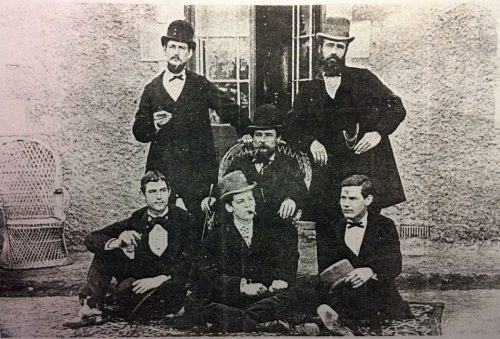
The Edmeades Brothers – c1875
George Mason sitting in the centre, Charles and William standing left and right. And in front from left to right Edwin Allen and Johnny.
This picture contrasts with my memories of pictures of Edmeades men in sporting teams in Oudtshoorn which I [and Penny later] saw when we, during our university vacations worked in the Johannesburg library in the 1950’s laboriously writing out by hand cards for each human in each photograph from thousands of different sources. This in order to create a photo library. [hopefully this still exists and should be researched]. Both our memories were that we had ancestors who looked extremely tough and somewhat gorilla like. But perhaps these were pictures of rugby teams????
The museum has copies of the Oudtshoorn Courant from 1879 [Vol 1 No 2]. This seemed to appear twice weekly and much of the time in parallel Dutch/Afrikaans and English identical items. In these there are prominent advertisements on page one for George’s businesses, which from some time after 1872 and until 1883 was described as George Edmeades and Brothers. We don’t know but it seems likely that the business included all of them once they were adult. [Charles was 15 in 1860, John 15 in 1868, and Edwin 15 in 1871].
The business seems to have expanded in all directions – with branches open in surrounding areas, and providing an ever widening range of services and products. There seems nothing that anyone in Oudtshoorn or surrounds might have required that the Edmeades businesses could not or did not supply.
There were branches in Wynands River, Hazenjagt, Styldrift, Schoemans dorp.
To the above businesses are added [in 1879] auctioneering, with Ford. This seems to be a venture of George alone although it is the GM and Brothers’ stores that in June are auctioning sheep, goats, cart and riding horses and mares, and plots in the village, and ‘whatever else will be offered for sale that day’ and for which ‘liberal credit will be given’.
On 12 May 1880, according to the museum’s Waenmakers document, a tender was granted ‘om die afdelingsraad van skotskarre teen ?35 te voorsien’ [whatever that may mean – a contract to provide the district authority with their carts or carriages?]
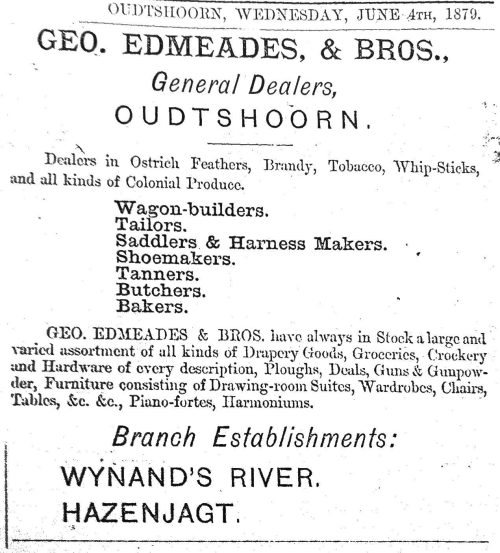
In March 1881 George applied for wine and spirit licenses to keep a hotel with ‘privileges’[sic] on erf no 114 Oudtshoorn. [successful?] And by 1883 they were agents for Donald-Currie Steamship Company. There seemed to be no end to George’s ambitions and business expansion.
But in 1883 things started to fall apart. By November the family partnership was dissolved. We don’t know who the partners would have been, but by then all the family were adults. It is possible that the death of their mother MAM in September 1882 had something to do with the decision to break up the business, as also the death of brother Charles of typhoid the previous year. Charles was described by Baz as having a gentle nature, and possibly being the peacemaker, [but who also was divorced in 1879 by his wife, probably a rare event].
Was the break up of the business a result of a change in the economy in Oudtshoorn? The first ostrich feather boom ended in the 1880s, [followed later in the 1900’s by another boom] .The website records that it was in 1885 that there was a sudden slump because of overproduction [of ostriches and feathers] and severe flooding. But the Edmeades problems had started before this.
What seems perhaps most likely is a combination of an economic downturn and some [perhaps all? i.e. including WK] of the family no longer wanting to work with or for GM. And with their mother and Charlie no longer around to keep the peace Baz says that the three youngest moved out of the firm – John aged 30, Edwin aged 27 and Allen aged 25.
[Was Allen in the business? He was not at his mother’s funeral in 1882, perhaps he was already in the Transvaal].
Ian in a letter to Lyn [15/7/02] says that his father Laurie’s version of the story was that at the time of one of Oudtshoorn’s depressions many farmers had to dispose of their properties and GM bought them. The bank manager required him to consult with the bank before buying more properties and his attitude was ‘who was the bank manager to dictate to him’ and he continued as before and the bank foreclosed. This resulted in a cash flow problem and the brothers lost their fortunes while the bank made a fortune.’ He said also that Edwin was not affected as he was not in the partnership.
Piecing all this together it seems likely that in 1883 WK was the only brother left in the business with GM. Why he did not leave with the others is not known. Was he afraid of yet again failing on his own [he had had one bankruptcy]? Were his affairs more tied up with GM than were those of the others? Did he, like GM perhaps think that the good times would last forever and with a large family to provide for he was better off sticking it out with GM? Or was it just that none of the others wanted to work with GM? Whatever, two at least of the younger three men [John and Edwin], made very successful business careers on their own. And poor old WK was involved in the final chapter of the end of the business and of his and GMs prosperity only a few years later.
The Courant records it all [apart from the personal relationships]. On 18th September 1883 it reported an auction ‘om van sy oortollige waens and karre ontslae te raak.’ George got £105 for a new wagon, £60 for a kaapse kar, £35 for a phaeton, and Scots cars raised £25 each.
And on the 5th November 1883 ‘All accounts owing to the firm in Oudtshoorn, as well as the branches viz Hazenjagt, Wynands River and Schoemansdorp must be settled as promptly as possible’, followed on the 13th by a big notice on the front page ‘George Edmeades and Brothers previous to a dissolution of partnership are now selling off in the different departments their general and varied stock at greatly reduced prices.’
George tried to continue in 1884 as George Edmeades and Company Auctioneers. But in March 1886 the first sales of lands of GMs large but insolvent estate were advertised.
This consisted of 10 properties and parts of another 5. The copy of the notice I have is unclear, but the numbers of morgen are clear [how big is a morgen?] They range from 2729 morgen [five being over 2000 morgen], to one of only 163 morgen.
And in July 1886 another huge front page advertisement of the public sale of moveables and livestock from his insolvent estate. These seem slightly sad considering the not so distant past. There are 7 items – 2 very good, large buckwagons; 1 wagon slightly used; 1 brand new spring wagon; 1 small mole wagon; 1 scotch cart [good]; 1 hand cart; 1 set donkey harness
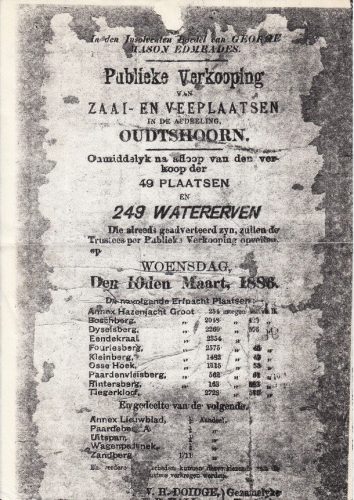
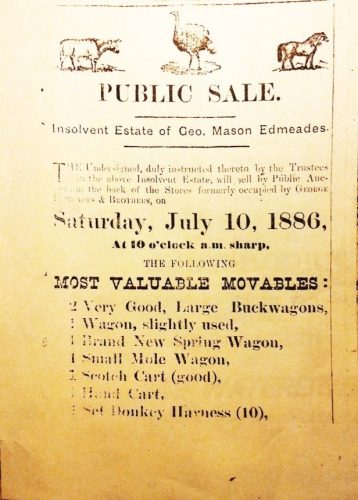
At the time of GMs bankruptcy he reputedly owned almost the whole of the west bank [or is the Wesbank, a bank?], and large parts of Oudtshoorn [Courant and Waenmakers 6/1/86]. His funeral write up in 1888 says that the Divisional Council valued his landed property at over £100 000, including many of the best farms in the division, more than one half of the erven in this town besides properties in other places …had he realised his properties some seven or eight years ago, he could have retired a wealthy man, but owing to the severe depression in trade that set in about that time, and has continued since, he sustained severe losses.’
There is a family story mentioning the sum of about £350,000, possibly to do with the banks’ assets that suggests that perhaps a quarter of the banks’ [or bank’s?] assets had been invested in him?
Coincidentally, on the web is the story of the developing prosperity of quite another family at this time. Wilf Sanders opened his first store in Oudtshoorn in 1885 at 33 St Johns Street on the corner of St Georges Street, doing well enough to buy the building in 1887 for £600, with a mortgage. And as the Jewish community in Oudtshoorn grew and flourished a decision was taken in 1886 to build a synagogue, with the Foundation Stone being laid in 1888.
So whilst one family’s prosperity grew the Edmeades tale of decline continued. In February 1887 there is a report that ‘the late residence of’ George Mason Edmeades, corner of Church and Queen Street is being improved.’ Another storey was being built and the current owners were planning a retail and wholesale store. What a downfall!
It seems not unexpected that George Mason died in 1888. He had had an amazing career during which his businesses reputedly owned most of Oudtshoorn, ending with all apparently lost, He was a quite extraordinary man, and died aged 49 on the 4th January 1888 in Oudtshoorn, after ‘lingering for the last 6 or 7 months, suffering at times most excruciating pains.’ The funeral took place in the English Church where at the end of the service ‘by special desire of the family’ there was a presentation in the Dutch language, as many mourners were not able to follow the English service. He was interred in the Dutch Church cemetery in the family vault.
His funeral notice is long, as befits one of Oudtshoorn’s leading business men. ‘…he wielded a personal influence in this district that will probably never again fall to the lot of anyone else’, said the minister at the funeral. ‘There is not a man, woman or child in the division of Oudtshoorn that has not heard the name of GME’… ‘having a natural bent for business and speculation… unbounded energy, dauntless will, and indefatigable industry… Although GM had his faults and some enemies… even those who were not in sympathy with him could not but express admiration for the gifts with which nature had endowed him, and this admiration found expression in the kindly feeling that prompted the unanimous act of esteem shown by all his fellow-townsmen in closing their respective stores and offices on the afternoon of the funeral.’ As the members of the Athletic Club were starting their cricket match and heard of his death ‘they unanimously agreed not to proceed with the game’. ‘He was a former President, and proprietor of the field which he provided free of charge’.
‘Many can testify to his assistance when in distress, and never was he known to refuse aid in a good cause. He subscribed £500 towards the first class undenominational school for boys… If he had chosen to stand for parliament he would have been placed at the head of the poll against all comers.’
Not the warmest description of a much loved man. The one positive thing of him as a person was a reference to the fact that in the drought of 1866 he had fed a large number of poor starving people
The Museum archivist has collected material on the Oudtshoorn wagon makers, and with reason. When one considers the importance of wagons and carts in the 19th century, one realises that these must have been the Henry Fords of their day. Think of the state of the roads or tracks. Think of the distances which people seemed to cover. Think of the damage that must have been done to any vehicle used in these conditions. And then think of the money to be made building and repairing these vehicles. No wonder GM and the family business became affluent. And add to this GMs entrepreneurial instincts and capacity. He spotted opportunities and grabbed them. But his business acumen stopped short of realising that the good times could not last forever. When there was a downturn and people were selling off farms and properties cheaply he assumed that the good times would return, and apparently took the opportunity to buy up properties. But in order to do so he had to borrow. And the bank or banks from whom he borrowed, perhaps having a sounder view of the financial future, became alarmed at the amount he owed them, and foreclosed. This was obviously, within the family anecdotes, translated into the banks behaving unfairly and unjustifiably, and making a lot of money as a result. One wonders whether had GM been an easier character, those he was borrowing from would have continued to lend. But whatever the banking system that day, to issue a final ultimatum to someone who owned reputedly much of the town must have been a decision not taken lightly. Before the end, in 1886 one can only imagine many meetings to try and reach a mutually satisfactory decision. And in the end, GM determinedly not giving in, the bank managers having to decide to take the final decision, and call in their debts, with all the consequences for the town that would follow.
And perhaps by then there were others ready to pounce? Others who had not overstretched their resources, and who therefore could benefit? One would need to know much more about what was happening in the economy locally and in Oudtshoorn particularly to know what happened in the town as a result of the banks’ foreclosure of GMs business. It seems significant for instance that the following year, 1887 GMs property in a prime position was being developed by whoever bought it.
So in the end was it GMs arrogance that finished him, he who had built up a vast business which had kept a whole family? And where was WK, his brother in all this? Did he believe in GM as the omnipotent provider and man of good judgement? Or were his assets so tied up that even if he saw catastrophe ahead he saw no way out? Because in 1887, the year after GMs bankruptcy WK was [perhaps desperately?] borrowing in order to keep properties, some of which he presumably had thought were his anyway?
One can create a convincing story of George Mason as a single minded arrogant man, coping with children who in no way seemed able to help him or continue his business, and who were a constant worry. And whose slightly younger brother was still part of the business, but had no great business sense, who stuck to him for whatever reason, and for whom he possibly had not much regard. And faced with his three younger siblings walking out on him and his [or their] business partnership three years before his bankruptcy, precipitating a crisis. He could well have seen himself as a man wronged. And there would be no one around now who could dispute this version! – such is biography.
So what sort of a man was GM, apart from being an entrepreneur who finally overstretched himself? And where were the rest of the family and what were their roles during this extraordinary quarter century saga? We get glimpses of them in the newspaper from time to time. And there are family stories which give some clues to relationships.
His own personal family history is not a happy one. There are no descendants of his nine children. What we know suggests a disturbed or dysfunctional sounding family.
George had married Aletta Loock in 1860 when he was 22 [the family tree has no more information about her, her birth or death date.] He had been baptised that year as were the rest of the family. George and Aletta had nine children, of whom at least 4 died in childhood. Of those that are known to have survived, Mary Ann Margaret [Marion] died in 1937 aged 75 unmarried [I have a photo of her grave]. Edith Amelia another surviving daughter also didn’t marry. Charles Penvil [Tossie] was married and divorced with no children, and died aged 71. The line died out with these people’s deaths
Mental illness was a taboo subject, as we know from the fact that Milly Yates’ problems were kept secret from most people. But there are reports of several of GMs children having mental health problems. And the fact that the family tree has so little information on facts of their lives, or those of their mother’s suggests that much about them was covered up in the hopes that people would never know of their perceived shame. We don’t even have all their dates in an otherwise remarkably comprehensive Edmeades family tree. How much the mental illness in his family affected George we will never know. Neither do we know whether his reaction to it may have made things worse for the sufferers, by for instance putting people in asylums who might have been able to function in the community, given support. What we do have, however, are the Edmeades’ myths/anecdotes that all of these mental health problems were nothing to do with us, the Edmeades, but all to do with George’s wife and her family, the Loocks! – ‘not in our back yard’ such is the shame of mental illness! [baz]
So what do the Edmeades stories tell us of GMs family and their problems?
Charles Penvil [Tossie], George’s son, was reputedly a character. We have a photo of him on the staff of his uncle John’s firm.
Staff of Divine Hall & co c 1890 – Johnny Edmeades manager, and Tossie [GM’s son] far left front row:
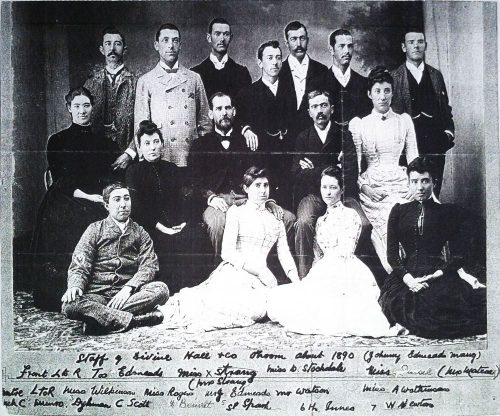
From various sources, perhaps because it is a good story, I was told, or read about him being told never to set foot in the firm again. And so the next day he came in walking on his hands. Rev Beddy [1976] said he was brilliant at figures, though inclined to be moody and very eccentric.
Tossie’s sister, George’s daughter Edith, of whom there is a photo in the Oudtshoorn museum, was a beautiful woman and the first matron of the new Oudtshoorn hospital. She was born in 1868, so would have been around 30 when remembered by a very young member of the family. This was Henry Charles Edmeades [born 1896, a son of John R B Edmeades by his 2nd wife]. It was the opening of the Oudtshoorn hospital. ‘The Hospital came into being at the height of the Boer War and feelings were running high – pro-british and pro-boer and …… the Town council, the Divisional Council and or the hospital board changed’ whilst it was being built and ‘the name was changed at the last moment from ‘Public Hospital to Royal South Western Hospital. Cousin Edith was the first Matron and I have an idea that she lived in from the start. I well remember being dressed in a sailor suit with a big white starched collar which choked me to the point of suffocation and marched to the Hospital with the rest of the family to pay respects to Cousin Edith. We were taken to the Matron’s parlour’.
He had another memory, of Uncle Edwin and Cousin Edith on the terrace in front of where Pinehurst now stands. [when would this have been?] ‘Cousin Edith was most distressed and weepified and Uncle tried to calm her and kept telling her that he did not like to see her so sad. He also gave her a bunch of grapes. I did not get any and was very ‘vies’. I suppose I was not very welcome there but as Uncle later gave me Pat’s airgun and paid me a penny for every muisvoel that I shot in his garden I forgave him. My mother who died on 16th July 1905 made several trips to the hospital round about this time. I suppose this episode was the commencement of cousin Edith’s illness. I would guess the termination of her term of office as 1903-4’. So it would seem that Edith was not the matron of the hospital for long.
Baz said that she developed mental illness and was institutionalised. Rev Beddy to Ian in 1976 said that one of WMs sons was also committed to a ‘similar institution’. And said Tossie also had ‘the mental streak’, all of them from their mother’s side, not their fathers!
Of George, Baz said that in the family he was always mentioned in connection with something not nice. He thinks Edwin, who was much younger, opposed George.
So George the great entrepreneur who brought affluence to the large family left fatherless when he, the eldest child was only 21 had a sad ending, and it seems a sad domestic life.
MP March 2012
William Knipe our direct ancestor and my great grandfather, was the person I was originally most interested in amongst that first Edmeades generation. He was after all the first South African born Edmeades. But he paled in significance the more I learned about George Mason his older brother. So it has been difficult to build up a picture of the man and his life. The key to the gaps in the tale of his life may well rest with his wife’s [the du Preez family] with whom he spent periods, and who may have taken him under their wing [perhaps to help him escape his brother GM?].
Some of the difficulties of summarising his life, or to get a picture of him as a man are because there are to date no personal reminiscences of him, no snippets of encounters or reactions, and apart from the one photo of all the Edmeades men, no photos. And we don’t know how he met his wife Maria Jacoba du Preez who reportedly came from a long way away, and who was Dutch or Afrikaans speaking.
And his business life is obscure for various reasons. For much of the time he was part of the family business dominated by his brother George Mason. At others he seems to have been trying to establish himself independently through or with his wife Maria Johanna’s du Preez relatives. In neither case was he successful, being declared bankrupt twice. These bankruptcies are not perhaps as indicative of lack of business acumen or poor judgement as we might assume today. South Africa at that time was a place where people [perhaps only or mainly white men] with few resources saw or grabbed opportunities, some of which paid off, and many others which did not. And perhaps he did not have the drive and determination of his brother George.
Because so little of him as a person emerges to help us get a picture of him as a person I will simply chronicle his life year by year, or decade by decade as I currently know it.
[See Appendix 8 for a summary chronology]
In 1841 William Knipe [WK] was born in Mossel Bay, the second child, but the first South African born child of WP and MAM.
As a child he spent some time with the family in or near Mossel Bay, on a farm Zuurvlakte. But by 1853 when he was 12 the family were on a farm Zeekoeigat on the Olifants river near Oudtshoorn.
In 1859 when he was 17 his father died. He perhaps stayed on the farm, running it with his mother and younger brother Charles, because his older brother George had already left to start work in Oudtshoorn as a painter. But by 1863, aged 22, he was in Oudtshoorn as a painter, possibly joining GM.
The following year, in June1864 he married Maria Jacoba du Preez. Her family are not known to have lived near Oudtshoorn. Murie said she came from Goudini, quite a long way away near Worcester. But the couple spent much of the time near Humansdorp, in the opposite direction. This is where there are still du Preez today. It seems that when he married he moved away from Oudtshoorn to his wife’s family, perhaps leaving Charles to run the family farm. We know that he moved away because in this year, 1864 he was declared insolvent in Humansdorp, an insolvency which ‘ended’ in 1872 whatever that might mean. So maybe Murie was wrong about Goudini, or perhaps it was that simply that part of the du Preez family had moved to Humansdorp, near Port Elizabeth, a long way from Worcester, and from Oudtshoorn.
From information collected by Jane in the CT archives we know that at the end of 1866 WK had ‘no immovable property’ and his moveable property sounds pathetic, totally just over £100, which was attached on the 19th January 1867. His most valuable items were 8 donkeys valued at £40, a horse, valued at £18, 2 guns [£16] and a bed and bedstead £10. He had in addition 3 cows, 1 musical box, 6 chairs, 2 tables and one crop, value £5. All of this is in the Cape of Good Hope Govt Gazette dated 9th July 1872. Creditors had to lay claim within the next 14 days. There is somewhat confusing information on creditors, as he was found ‘not blameable, ‘and no creditors appeared. But then two creditors, names of Edmeades, and Metelerkamp were mentioned. And the attorney [who might have been an in law relative], was named John Daniel du Preez. There was reportedly a drought in 1866 which may have caused him the problems. Humansdorp may have been one of those areas the British government was encouraging whites to go to. David Met has said there were Metelerkamps there, as also Ian Edmeades mother’s family, the Gerbers.
From 1865 on, almost every year the couple had a new baby, so that by 1872 the couple had four surviving children, and by October 1877 they had six surviving children. It seems that the first five children, including our grandmother Lizzie could have been born there, in Humansdorp. [Although baz I think said the first two were. If this is so then they would have left Humansdorp by 1868, which seems incorrect as in 1872 WK was described as a farmer on Langehoogte in the District of Humansdorp.]
Ian locates the du Preez families property as being named Andrieskraal, with Ian’s father Laurie’s property being 10 km beyond.
It seems possible that the family[or perhaps WK on his own] were back in Oudtshoorn in 1873, because much later [in 1884] WK was having to buy back land in Oudtshoorn which it appears he thought he had acquired in both1873 and 1877.
Certainly between 1877 and 1886 he was in Oudtshoorn described as a storekeeper. So having been unsuccessful on his own he presumably returned and joined GM who by 1877 had a thriving and diverse business.
When his mother MAM died in 1882 she was living with WK and his wife Maria Jacoba [ MJ] in Oudtshoorn, where although MJ was Afrikaans speaking the home language was English, perhaps because MAM did not understand Afrikaans, having come from St Helena. But Baz suggests this was because MJ ‘probably adopted English as her language.’ Bazette’s Edmeades grandmother [born Schoeman] ‘did become an English lady and all their children had English names.’ [Was this the time when there was an attempt to make English the only language? – Margie Szecsei’s first mother in law in Memel, Mrs de Jager had perfect English because she said they had been forced to only use English for a time when she was young]
In this period of the late 1870’s until 1883 WK was presumably one of the brothers in the family business GM Edmeades and brothers.
In 1883 [15th May] Jane found in the CT records WK had a mortgage for £5,000 on 9 erven – nos 423-427, 433 and 434, and 483, and Lot K in Oudtshoorn. They were mortgaged to Camille Frederick Tiran. This was before the brothers’ partnership finished formally in November. So perhaps he was buying some of the properties from George, or from the business. As he had to borrow to buy them this suggests that although the business was described as GM and Brothers, perhaps GM in fact owned it all, and it wasn’t really a partnership in the accepted sense of the word now. Or was it that with the youngest three wanting to get out, money had to be found to pay them off?
Again in 1884 another mortgage bond was recorded. This one was for £1,800 for pieces of land. These are
– piece of ground no 4 with buildings there… being one of the two erven nos 4 and 5 portion of the divided erf no 101 measuring 50 sq roods
– certain remaining portion of a piece of ground …being section no 3 of the divided erf no 101 measuring as per remaining extent 20 sq roods
– certain lot of ground with the building[?]
– certain other lots as per deed of transfer in my name of 30/5/1873 and 6/8/1877.
This last is a mystery. Why, if WK acquired these in 1873, and 1877, [or thought he had acquired] does he have to borrow to re acquire them? Did George mislead him? And could he not prove that he had originally been given them?
Baz suggested that ‘George was William’s downfall because their assets were so tied up’… that William ‘had no choice’. But William’s attempts to be independent earlier did not seem to suggest that he was a very successful business man or bread winner on his own, and highly dependent on GM for the affluence of the family in the late 1870s and early 1880s when he presumably rejoined GM.
So GMs business acumen could explain how it was that our grandmother Elizabeth [Lizzie], WKs eldest daughter was brought up as a lady of great substance, until that is in the 1880’s. She was born in 1866 and sent to CT to school. After she had taken matric and the family no longer had money she could not go to Oxford [in around 1883 or 4?] as apparently was planned. So only then did she seem to be a victim of a fall in the families fortunes, which coincided with the end of her schooling. GM was reputed to be a bully. But as long as he, and the business thrived the other members of the family also apparently thrived. And when he went down, so did they, except perhaps the three younger men who got out of the business in 1883.
As with so much of WKs life, we can only speculate.
Perhaps WK had to creep back into GMs business after failing at Humansdorp. And perhaps the terms on which he entered or reentered the business were dictated by GM leaving WK with no right to any assets when the business was broken up. Or having decided or been persuaded to stay in the business when the youngest three got out, perhaps he had to buy property in order for the three leaving to be paid out? And there was therefore no more money available for Lizzie or the younger one’s expensive education?
In 1885, after the breakup of the partnership he took over erfs 433, 434 and 175 where GMs ‘wamakery en smidswinkel’ were [Courant and Waenmakers]
WK, or the family may have thought or hoped that after that the future was secure, but in 1887 he was once again insolvent, following GMs bankruptcy in 1886. [Baz said his creditors were Edmeades and a Metelerkamp, and thinks that the Edmeades can only have been GM. But was he in fact muddling the earlier bankruptcy with this one? One needs to return to the CT records to check.]
With ten living children of which at least seven must still have been at home, life must have been hard for the WK and MJ family after 1887. Elizabeth Catherine, by then aged 20 and probably already teaching may have been called on to help the family, as also WK and MJs first child William Penville, known as Secundus, and possibly John du Preez then aged 17.
Wks second bankruptcy in 1887 may have followed unsuccessful attempts he seemed to be making to make a success of commercial life on his own. On 26th May 1887 the Courant reported that the Divisional Council had refused to accept tenders for valuation for £125 by WK and others for various properties including Roodeheuvel and Gamka. And another report of a Town Council meeting on 15th August of that year suggested some on going dispute ‘…streets were still closed on the west side of the river by the following persons WK Edmeades and others’.
From the Courant we have other small insights into WKs life in Oudtshoorn. In November 1883 [as the partnership is being broken up] he and brother John were amongst many signatories requesting that GM be nominated as a member of the legislative council for SW province, a request which was agreed.
On 31st December 1885 he was a member of a cricket team which also included our other great grandfather Edward Mortimer. Brother John was in the opposing side.
Hard times, and the death of their son John [a possible bread winner for this large family] did not stop WK and MJ having children and in July 1888 their last child Irene was born when MJ was 44 and WK 47.
All we know of him after this is that in 1889 he was described as ‘an agent for produce’, and on the 6th August 1894 he died [aged 53] in Johannesburg at his daughter Lizzie’s house, leaving MJ with six dependent children under the age of 16, the youngest Irene being 6. Perhaps he was up there looking for work?
The Courant reported ‘from a correspondent’ that ‘It appears he had been complaining of feeling ill a few days before his death having caught a chill. On Sun 5th inst he was out and about – on that day he went to Mortimers’ house [his son in law] and stayed there until the evening and was quite bright and cheerful. He retired about 10 that evening and on Monday morning when Mr Mortimer went to his bedroom, he found the deceased lying on his face upon the floor having it seems died in a fit. The funeral took place today at 11.30 a.m. and was well attended by a number of Oudtshoorners, other friends, acquaintances and his relative resident there, among whom that I noticed were Dr J van Niekerk, ….. and Allan Edmeades and the two sons William and John’
NB Not clear who is being referred to. Allan is presumably his younger brother aged 36. William is presumably Secundus, then aged 29. But who was the John? John, WKs brother would then have been 41 and would surely have been referred to as a brother. WKs son John had already died in 1890. His son Leach would only have been 13, and presumably still back at home in Oudtshoorn with his mother? Or perhaps not? as Leach fought in the boer war on the side of the boers not that much later, unlike Laurie his slightly younger brother who fought on the British side. So perhaps Leach was already in Jhb?
So another widow was left with a big young family, with four of their offspring Secundus, Elizabeth, Mary and Edith [Edie] old enough to possibly help support the family, but at least six of whom were still dependents. There were 23 years between the oldest and the youngest of WK and MJs children, the youngest Rene being 6.
It is no wonder that the Edmeades women learned early on that they should get out and earn a living. Family history certainly did not suggest that women could be at home and always have a man or men to rely on as the breadwinners.
WKs widow MJ lived another 17 years, long enough for all the children to reach adulthood, and for her to be remembered by her older grandchildren including my mother Murie.
The story of the next generation is very different because of different sources of material There are far more reminiscences, and more about the women in the family.
MP March 2012
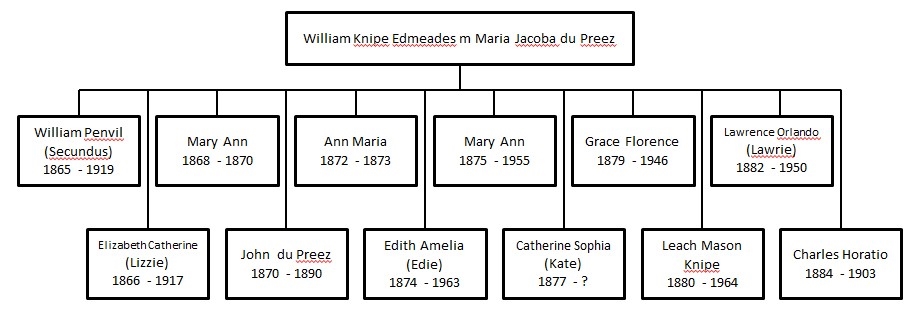
[Details including marriages in Appendix 10]
Lizzie [Elizabeth Catherine] Edmeades, my grandmother, grew up in the period of her family’s affluence. The loss of the family’s money and her father’s bankruptcy was a major tragedy for her, which shaped her whole future life. If it hadn’t happened when it did she might not have married Eddie Mortimer, but actually become a leading woman academic in South Africa, or perhaps the UK.
By 1870 there were a vast number of offspring of the first founding family [William Penville and Mary Ann Margaret Edmeades had eight children]. There are many interesting tales to tell, particularly of the lives of the WP and MAMs youngest sons and their families. But this is not the place for them. This section concentrates on a small section of the second generation of Edmeades’ in South Africa, that of my grandmother Lizzie and her siblings, the offspring of William Knipe [the second son of WP and MAM] and his wife Maria Jacoba.
The luck of the draw! William Knipe and Maria Jacoba’s first two children William Penvil [Secundus] and Elizabeth Catherine [Lizzie] started life as the privileged children of a leading wealthy Oudtshoorn family. Their nine surviving younger siblings lived only with the legacy of riches lost, and presumably hopes dashed, or perhaps never even kindled. What is striking as how they all [with the possible exception of Ethel] simply ‘got on with it’. Perhaps this was because their father and mother had had a roller coaster sort of economic existence, and so instilled in their offspring the assumption that what can come can also go. But also possibly because they knew that the privileged moneyed life which Lizzie and presumably Secundus [and possibly John, the third child] lived until in their teens was a result not of their father’s wealth, but of funds from the family businesses.
Lizzie [born 12th December 1866] was the second child and oldest daughter of WK and MJ Edmeades.
She seems to have been a serious child, who grew into a good looking but strong minded and determined young woman.
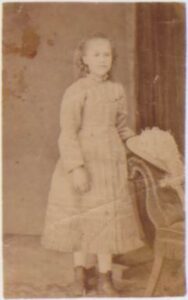
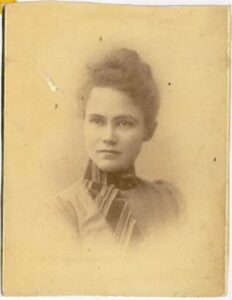
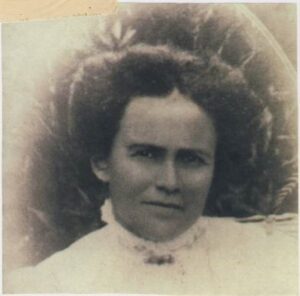
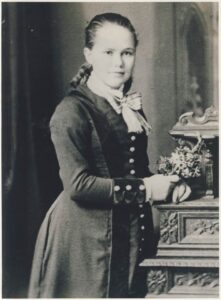
This photograph was labelled as being of a young Irene [Lizzies youngest sister, born 22 years after Lizzie]. But looking at the clothing, and at the photos of Lizzie it seems to me to be much more likely to be that of Lizzie. Perhaps others can settle this?
With education being so prized in the family and education facilities in English for girls in Oudtshoorn probably very limited, she was sent to Cape Town to school.
Muriel’s recollection is that ‘The Edmeades boys went to South African College…my mother [Lizzie] went to a place called ‘Mrs Percivals’ [the Good Hope Seminary]…Girls from the country where there were no schools attended these two Cape Town schools as boarders [the other being St Cyprians which was the English Church School]. She was at the Good Hope Seminary and she had the best of everything.’
Gardie recalls being told ‘that she grew up with endless pocket money. I don’t think I am exaggerating that she had a dress allowance, a hat allowance, a glove allowance, a shoe allowance, an ordinary petty cash allowance and what else and she wanted for nothing. And she and two other girls at the GHS were so brilliant that they wrote matriculation, the first women in SA….. I understood that they had to go to SACS college to join the men in order to write the examination. The three of them were booked to go to Oxford, it was all arranged when grandfather went completely bankrupt.’
Ian corroborated this move to SACS [where presumably Lizzie’s brothers Secundus and John were or had been] where he says they were coached privately in the library. So perhaps it was not possible for girls to do the matriculation exam from the Good Hope Seminary.
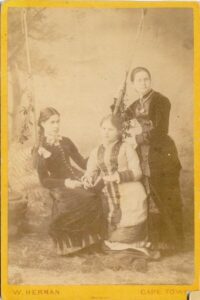
Lizzie [centre] with the two other matriculants – the first women in South Africa to achieve this.
But the family fortunes were changing. When she was 16, in 1883, the Edmeades family businesses were broken up with the youngest brothers leaving it. And three years later her uncle George who ran the business was declared bankrupt, followed a year later by the bankruptcy of her father William Knipe.
So the three eldest children, Secundus, Lizzie and John had presumably to go out into the world and make a living. This John did by going to Rhodesia, where he died of fever aged 20. And Secundus? [see later – Lizzies brothers]
Lizzie took the only step possible for an educated woman at that stage [apart from nursing] and became a teacher, in Bloemfontein at the Oranje High School. There she seems to have stayed until she was 27 [in 1894] when she went to Johannesburg by train and coach, reportedly a rough and uncomfortable journey although the Cape to Johannesburg railway had been completed in 1894 [Packenham]. This was because Edward Mortimer, who she was to marry, was in Johannesburg then a boom town, gold having been discovered in 1886. In Johannesburg she stayed with a former teacher from the Good Hope Seminary who had married a mining magnate. It was from their home that Lizzie married Edward Mortimer who she had known in Oudtshoorn.
It is thought that she was probably sending money home during this part of her working life to help pay for the education of her younger sisters [and brothers?], who were educated mainly or entirely in Oudtshoorn. The eldest Edie was 20 in 1894 when Lizzie married and presumably already had finished her nursing training at this time.
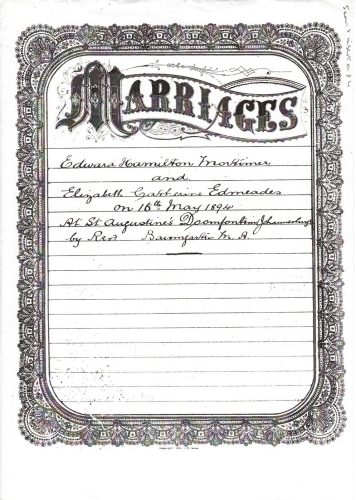
Lizzie and Edward were Johannesburg pioneers, being the first couple recorded as being married at St Augustine’s Church in Doornfontein, on 16th May 1894.
Edward had presumably gone to Johannesburg, then a boom town, to make his fortune, or at least to make a living. And this seems to set the pattern of their married life, a life of constant movement, and probably uncertainty with both Eddie and Lizzie moving round the country in order to earn a living. Already in 1895 Lizzie was back in Oudtshoorn where their first child Leslie died and was buried in December 1895 aged 9 months.
Presumably by early in 1896 Lizzie was back in Johannesburg because Milly, their next child was born there in September, her birth commemorated as a Johannesburg pioneer with a plaque at the Market Theatre.
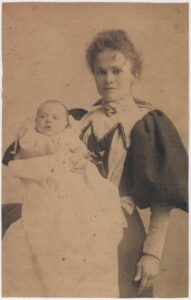 Lizzie with Milly?
Lizzie with Milly?
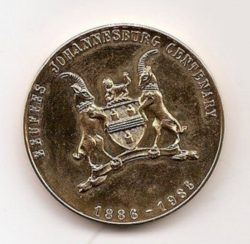
Milly provides stories about what seemed very temporarily a comparatively stable period for the family. She was told that her father Edward built a house in Braamfontein, a place considered at that time to be way out in the country, but which was on the site now occupied by the Civic Theatre. Whilst Lizzie was pregnant with Milly there was a huge dynamite explosion the vibrations of which broke the hanging lamp into a thousand pieces in front of her as she walked down the passage. And whilst in Jhb Lizzies sister Mary visited, long enough for her to acquire a suitor [see story later]
But this stability was illusory because at the end of August 1897 only eleven months later their third child Muriel was born in East London. Lizzie was joined there by her younger sister Kate. Why East London where there seems to be no family connection? They left possibly because of instability on the Rand which resulted in many people leaving in 1899, and perhaps before. There was a great deal of railway construction at the time, [a link to Lourenco Marques was opened in 1895], so the rail link to East London may been built by then. But this on its own does not seem to be sufficient for them to go to a town with which they had no known connection. Did Lizzie follow Edward on yet another of his quests? This seems likely because they were there long enough for Murie to have learned to walk on the beach there. Murie was told that ‘my father, who must have joined my mother there, suddenly realized that my birth was imminent and rushed off for the doctor and nurse. When he got back with them I was already born’- presumably with Kate’s help.
Then came the Boer War when Edward enlisted on the British side. Murie says he was a captain in the Cape Corps. Lizzie and her two children Milly and Murie went to live with Edward’s parents, Rev Benjamin Clapham and Ellen Mortimer at the rectory in Knysna. Another Mortimer daughter in law refugee from the war in the Transvaal was Bessie [b Susanna Elizabeth Jeppe] wife of Arthur and her child or children. Life in the rectory played a large part in the life of Lizzie’s children as they were often there, possibly on occasions without their parents, and a close life long relationship developed between Lizzie’s daughters and Bessie’s daughter Esme. Murie’s earliest recollections were of life in the rectory at Knysna, where she remembers her mother having a bedroom downstairs.
Edward then got work [presumably temporarily?] in Oudtshoorn, [perhaps after the war?], and there in April 1902 their fourth child Marjorie was born. Murie remembers being taught along with Milly by their mother around this time.
The domestic instability, the constant movement continued. Edward was soon off again probably to Lydenburg, with Lizzie and her children probably in Oudtshoorn. Murie went to kindergarten there and she and Milly were in the same class there for Standard One. She recalls being at school there until Standard 4 where she was taught by her Aunt Mary. It seems that perhaps for eight or ten years until 1910 Lizzie lived an extraordinary life moving between her husband in Lydenburg, and her children and her teaching work in Oudtshoorn. This seems daunting considering the difficulties of traveling at the time. It was only in 1910 that the railway reached Lydenburg. But finances were perhaps pretty desperate.
Murie said that Edward’s youngest brother Clarence Mortimer was an attorney in Lydenburg, and it was he who suggested to Eddie that he come up because there was plenty of employment there. So Eddie set off prospecting for gold in Vaalhoek. [Winslows mine. Is this Lydenburg?]. Murie thinks this was even before the end of the war.
In spite of all the toing and froing Lizzie and Eddie must have been together enough times during this period for her to conceive both their fifth and sixth children, and for both of these children to be born in Lydenburg.
It was in May 1904 that Lizzie gave birth to their fifth child Edward Knipe [Ted], and June 1907 their sixth child Edith Gwen [Gwenda]. But Lizzie did not stay in Lydenburg, possibly because there was a desperate need once again for money.
Murie recalls Lizzie teaching in Oudtshoorn, taking Marjorie and Ted to school with her, and passing Gwenda, about two at the time, through the fence to get her to her Grannys [Maria Jacobas] house where she spent each day. Murie says that Lizzies salary was £5 per month. From after Standard 4 until after Standard 7 Murie said she and Milly were back in Knysna with their Mortimer grandparents.
In 1910, for whatever reason, Lizzie [or Lizzie and Eddie] decided to move the family to Lydenburg, the town where she died only seven years later. Perhaps Eddie had found a more stable source of income? Or perhaps there were now opportunities for the younger children to have an English language education. Whatever, this move initially did not include all her children, only her youngest three.
En route to Lydenburg [from Knysna?] in 1910 Murie said that Lizzie had gone to see her mother in Oudtshoorn. Maria Jacoba was probably not well, as her grandchildren recall, and she died in May 1911.
Milly and Murie were left in Knysna with their grandparents, presumably because of their education. And perhaps especially in order to allow Milly to finish her education without being moved yet again, Murie and Milly being then aged 14 and 15. These two eldest then joined the family in Lydenburg in 1911, Murie once again going to school repeating Standard 7 because there was no education in Lydenburg beyond that.
Life in Lydenburg cannot have been easy. Lizzie’s husband Eddie was drinking [perhaps more than he had in the past?]. Murie recalls him drinking whisky at the Lydenburg Club.
But there were other members of the Mortimer family there [Wilford and Daphne’s parents – Clarence and Anne Christine [Chrissie?] so perhaps there was some sort of support system.
Eddie was described as an accountant, one of the first in the Transvaal, but seems to have turned his hand to many occupations, perhaps because he never held down a job for long. Eddie did the books of a grocer and butcher and ‘our supplies came off his account’, said Murie But there was also a report of him delivering the post at some stage.
Lydenburg seems to have been a boom town then, attracting many new comers, so there were opportunities for men. It is not clear whether around the turn of the century there were also opportunities for women to teach which there were by 1917, as Murie got her first post there then. But for Lizzie earlier there was probably more than enough for her to cope with in Lydenburg without once again becoming the breadwinner. From then on it seems she became economically dependent on what seems to have been an increasingly undependable unpleasant and possibly violent husband. There may already have been worries about Milly’s mental health. There were certainly worries about money. And Lizzie herself had bad asthma.
On top of all of this there was the need to keep up standards. It was seen as essential that the family maintained what were perceived as middle class standards. For Lizzie this meant, amongst other things, that her children should only play with certain children. There are different views amongst the family as to whether the choice of ‘suitable’ playmates was on grounds of class based on their fathers‘ occupation, or whether on the behaviour of the children themselves.
Whatever, all her children had memories of violating their mother’s standards. Murie remembered ‘playing secretly with children from the mineral water factory across the street and Mother, to her horror, heard one of us say ‘Hush, we must play quietly because we arent allowed to play with the riff raff.’ She made one of her life long friends there, Bryna Davis, a very erudite woman whose husband became a professor at Wits. But Bryna seemed not quite to have passed Lizzies ‘acceptable’ test, possibly either because of her father’s occupation or because of being Jewish, or both.
Gwenda talked about her deep embarrassment when she brought friends home from school. Her mother would draw herself up to her full height and say ‘And who, pray, is this little girl?’ while Gwenda cringed. She thought approval did not appear to be based on social standing so much as on good manners. She was not allowed to play with the doctor’s children because they were regarded as ill-mannered, but she was allowed to play with the blacksmith’s children who were regarded as well brought up.
The question of ‘middle class standards’ which Lizzie’s grandchildren remember being brought up with, seem very likely to have come from Lizzie herself who imbued her children with them. They can provoke great laughter and exchanges amongst her grandchildren when key words are mentioned…
‘Butterknives’ is one. Many of us still feel guilty when we put an ordinary knife into the butter. ‘Tins of jam on the table’ is now an outdated problem, but its equivalent ‘bottles’ can still raise a reaction. Jam was to be decanted into a jam jar. ‘Salt on the side of the plate, not straight on to the food, and similarly ‘butter on the side of the plate’ can result in admissions of feelings of guilt when we transgress. And bottles, or worse cartons, of milk on the table have a significance probably not understood by many younger people, and all maybe our inheritance from the grandmother none of us knew.
Lizzie obviously regarded the upbringing of her children as very important. Children who didn’t conform were whipped. Milly advised Murie to scream loudly when this happened because their mother would then stop. Murie remembered a whipping because on hearing at school of the failure of a senior girl, she stood at the fence and yelled at a man on a bike ‘Mr Schenk, Hilda’s failed’ repeatedly. And children also had to be educated. Murie recalls their mother teaching the two year old Ted Latin ‘mensa, mensam, etc’
Lizzie got involved with the community in many ways. She was on the local school committee. Milly and Gardie recalled ‘at home days’. One would have one on say the first Monday of the month. There was much baking because you did not know whether two or many people would turn up. Gardie thought her mother loved those ‘at home days’ when she could chat to other women, and have some sort of outlet from the pressures of domestic life.
Milly also remembered her mother taking over the library, burning lots of rubbish and getting some good reading matter in including Blackwoods Magazine. And Gwenda recalls her mother running literacy classes for groups of [white?] adults.
Lizzie’s children remember a busy social life, with other members of the family popping in. But also a very simple if not primitive life. Gardie remembers the water for a bath having been pumped from a well, heated in paraffin tins on the coal stove and then carried to the bath where they all bathed in turn. But she thinks Lizzie didn’t bath in the bathroom, but in a hip bath in her bedroom. Murie remembered her father’s shower bath in a small yard off the dining room, made of sacking. Buckets of water were poured into a receptacle to drip over him.
Hanging over the family all the time were the problems caused by Eddie’s drinking and temper. The drink must have been the cause of some if not all of the money problems, and possibly his peripatetic lifestyle from town to town and from job to job. Money must have been very short. For example Murie recalls that whilst at Teacher Training College and in need of money she was sent a postal order for one shilling.
Eddies behaviour was obvious to all his children. Murie said that Lizzie was ‘ridiculously subservient to Dad and never criticized him. I once attended an important public meeting with Mother who had decided views on the matter under discussion. I urged her to speak but she insisted I must do so and I realized that she had been forbidden by Dad to speak at public meetings’.
Lizzie developed a well justified jaundiced view of men. When Murie, returning from a stay with her great friends the Metelerkamps whilst at Training College told her mother of a different sort of life, and that Mr Metelerkamp did not drink, her mother Lizzies reaction was ‘it is wine or women with all men’. Perhaps with Eddie it was only wine?
Early in 1913 Lizzie had to deal with yet another crisis. Milly had gone to Training College in Grahamstown, where she had a major mental breakdown of some kind. Murie says that she Murie had to be ‘at home’ for the first half of this year, presumably not at school because Lizzie went off to take Milly to an uncle’s farm to recover.
In August Murie was able to leave for Oudtshoorn to finish her education and pass matric at the Oudtshoorn High School in record time, with Lizzie and Milly presumably back home.
But in July 1917 two weeks after Murie returning from Teachers Training College started her first teaching post in Lydenburg, Lizzie died. This was traumatic for the whole family and resulted in them being split up once again and forever. Murie was convinced that her mother’s death could have been avoided had the doctor done his job properly. In telling me the tragic story she left out none of the emotion, but lied about the cause of Lizzies death [perhaps because I also had asthma]. I always believed Lizzie died of peritonitis, but much later Barbara and Gwenda confirmed that she had died of an asthma attack. My memory of the event as told to me by Murie was that Lizzie had been out helping a sick aunt [Chrissie?], that the weather was bad, that she came home in a bad way, and that the doctor either failed to come, or misdiagnosed. Whatever, on the 27th of July 1917 Lizzie Mortimer [nee Edmeades] died, leaving five children, two adult and the youngest Gwenda aged 10.
Her husband Edward Hamilton Mortimer lived another eight years before he died also in Lydenburg.
Whilst this account concentrates mainly on my immediate forebears, some other members of the family played such an important part in the life of Lizzie’s children, and in the folk lore passed down to subsequent generations that their stories are well worth telling.
The main Edmeades actors of this generation in our family history are the women especially the four known collectively as THE AUNTS [Edie, Mary, Ethel and Rene]. They merit capitals because this was how they were always referred to. They lived together in Oudtshoorn [some of them for their whole life] and Oudtshoorn to me and many others was ‘The Aunts’, although I never visited it in their life time, and only remember seeing them once or twice. However their individual stories are interesting in their own right, and it is a pity that more about these women is not known.
We have three pictures of the five of them altogether. One is with their niece Marjorie [Gardie].
THE AUNTS 1958
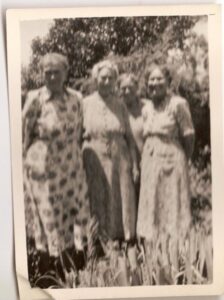
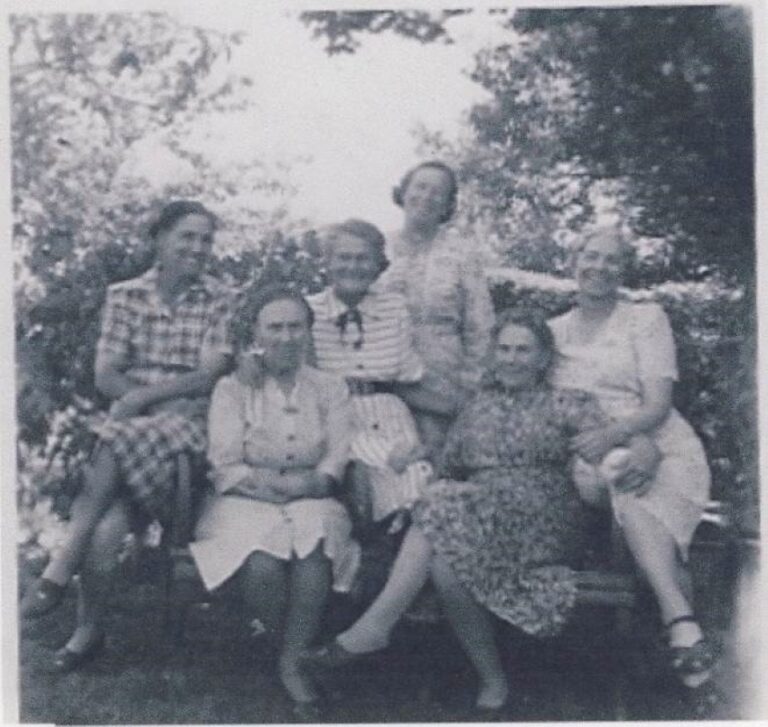
THE AUNTS WITH GARDIE
THE AUNTS
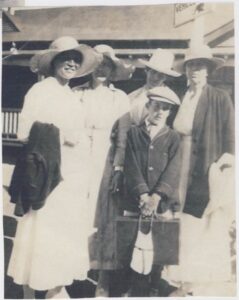
The Aunts who, as far as I know always lived together were Mary, Ethel and Irene [Rene]. Of the others, Catherine [Kate] married aged 28, Grace married later in life, and Edie traveled. Only Edie, of these three, returned to live in ‘the family fold’. This return was not to ‘the family home’ because her sisters apparently moved house a lot in Oudtshoorn from rented accommodation to rented accommodation. Of the four who ended up living together Mary and Rene became teachers in Oudtshoorn having gone as Milly had, to the Training College in Grahamstown. Edith [Edie] became a hospital matron, and travelled and worked all over southern and East Africa. And Ethel, said to be the most intelligent, stayed at home and kept house.
Edith [Edie], aged 13 at the time of their father’s bankruptcy became a nurse, and eventually matron of a large Bloemfontein hospital. ‘I don’t think you were paid anything. You just endured all sorts of horrors cleaning floors and what have you. It was really very grim’ said Gardie. ‘She nursed all round Rhodesia in the early days, in Rhodesia, Nyasaland, and I believe in Kenya as well.’ And Murie remembered her working in Northern Rhodesia [Zambia] at Sinoia ‘ She had holidays and she travelled to England and was seen as a more worldly person than the sisters who were seen as simply stuck in Oudtshoorn for the rest of their lives.’
Ian recalled that when she retired on 31st October 1929 [aged 55] the Bloemfontein Hospital Board presented her with a desk. ‘My father [Laurie] went to Oudtshoorn in April 1946 to attend his sister Grace’s funeral. While there he saw the desk and he said to Aunt Edith, who was 8 years his senior “You are next for the chop and when you go I would like your desk.” He predeceased her by 13 years and a few days before Auntie Edith died she told Auntie Rene ‘Laurie wanted this desk, so when I die it must go to Ian.’
And it was duly sent to Ian in Bulawayo, and moved with him to Port Elizabeth.
Edie returned home to live in Oudtshoorn with her sisters only late in life. This created problems and tension. She had money, a pension, or savings, which she did not share happily with the others, who lived on very little. The picture Murie painted was of someone who saw herself as somewhat superior to the others, and entitled to her luxuries. As she was the only one of the unmarried sisters who moved away from Oudtshoorn it is not surprising if she perhaps had a more worldly view.
Gardie says that both Eddie and Lizzie must have helped finance her training, as also that of Mary’s training in Grahamstown and Rene’s too to go there to Teachers Training College.
When one speculates as to why so many of these Edmeades sisters did not marry, clues come from stories handed down of the behaviour and attitudes of the family. Gwenda, who spent much of her childhood with the aunts, said Edie was very attractive to men. She was very appearance conscious, and whenever a suitor seemed to become serious she would reportedly take him to her room, fling open her wardrobe to reveal her vast collection of expensive shoes, and enquire of the young man whether he would be able to afford to keep her in the style to which she had become accustomed. At which, the young man would understandably make himself scarce.
Jennifer [a great niece] talked of a very telling episode, of conflict between Edie and Ethel who had kept house for all of The Aunts. ‘Aunt Edie liked a brandy and Ethel never drank at all. We were staying at Great Brak when Susan was about 18 months. We went over to Oudtshoorn to get the four of them for a break. Edie and Ethel never got on, they couldn’t stand each other, both very strong characters. I told Malcolm I couldn’t go with him as we wouldn’t fit them and all their luggage in. So he went on his own. He never laughed so much. Edie came out and put a bottle of brandy in the car, and Ethel came out and took the brandy out, and Edie came out and put it back in the car. And eventually the brandy was put under the seat and you couldn’t see them it was so loaded with luggage. I knew from a previous time when I went with Gardie to get them for a break Edie stood on one side. We were trying to pack the car and we said … please auntie Edie, and she sighed and it went on. She was bolshie. She stood in the door, and sighed as though ‘look what you are doing to me.’
Edie died aged 89 in 1963.
Mary Ann, a year younger than Edie, born in November 1875, trained as a teacher, taught Grade 4 in Oudtshoorn, and became The Miss Edmeades as the eldest at home.
Mary was the second child of Maria and William Knipe to be christened Mary Ann. She was born 5 years after the first Mary Ann who had died aged 19 months. Gardie says the Mary was ‘tall and beautiful, blond and very beautiful’.
She had been engaged to be married, and there are two versions of why she did not marry. Gardie said this was ‘because she had to stay at home and look after her mother and all the rest of the sisters.’ The man concerned was ‘subsequently one of the big noises in Johannesburg in mining’. Murie however had a more specific story, which was that Mary had come up to Johannesburg with Lizzie and her husband [this would have been some time after she had turned19], and ‘had a love affair but my father [Mary’s brother-in-law Eddie Mortimer] reckoned the man was a rotter, and Auntie Mary never really forgave Dad for breaking up her romance with this young man.’
She taught for 30 years at the Oudtshoorn Girls School, presumably until the 1930s. Whether she had a pension is not known. Married women teachers were regarded as temporary workers and did not have pension rights, but perhaps single women did. But by the time she died in 1955 any pension may not have been worth much.
Mason, her nephew, Leach’s son recalled that when Mary had long leave in 1922 his parents took her down to Warner Beach for a month’s holiday.
She was one of the first women to be given an obituary in the Oudtshoorn Coerant when she died suddenly in March 1955 aged 78. The tribute to her in the edition of the 19th March talked of ‘a gracious courteous lady’ who mothered younger members of the family and kept the home together and that later she took up sport and was a member of the Oudtshoorn Golf Club. In 1918 as part of the peace celebrations she played Lady Anne Barnard in the Garden party scene. ‘What a beautiful dignified Lady Anne she made…. ever peace loving and patient….’. The golf suggests that at some stage there must have been a little money to pay for membership of the Golf Club.
Ethel Maude was the third of ‘The Aunts’, born in 1886, at the time of financial crisis in the family, and twenty years younger than Lizzie. She sounds a most interesting character and for an extraordinary [in our view today] reason. Said by Gardie to be the most intelligent of the sisters apart from Lizzie, her sister, she apparently never worked, hid her one hand, and suffered deprivation because of it, simply because she had some kind of congenital deformity of one hand. That this could be such a handicap to the life of an otherwise capable woman seems today extraordinary. But disabilities were and are in many cultures seen as negative signs from the deity, a curse on the family, and perhaps this was what handicapped her.
No mention exists of her education. Perhaps school records would record if she ever was a pupil. One wonders, if there was such shame attached to her disability [by her, if no one else] whether she even went to school. Perhaps her older sisters Mary, Kate and Grace educated her [Lizzie already having left home around the time she was born or soon after].
What this terrible disability was for a long time not completely clear. I understood that it was that she had a finger missing from her left hand. But as she refused to go and sign on for the old age pension [money sorely needed by the household] once she was eligible Gwenda and Audrey Met’s description seems more likely. Gwenda spent much of her childhood with the Aunts and says that Ethel had a club hand, something Patricia once caught sight of. Audrey Met also caught sight of it once and described it has looking like a round lump on the end of her arm, no fingers at all.
It would seem more likely that it was the right [writing] hand rather than the left. She seems always to have managed to hide it from those not in the household, hence the doubt about what the affliction was. The only photo of her I have where you can see her arms, is at the Empire Exhibition [see p19 with Peggy and Peter] with her holding a handbag in her left hand and the right one not in view behind a closed umbrella. But perhaps its physical shape didn’t really matter, as it was the symbolisms attached to it which caused the handicap.
Gardie says that ‘it was always reckoned poor Ethel who could do nothing which was ridiculous’. Gwenda describes her as ‘a bit of a virago’, and that with a club hand she was not seen as marriageable material. This latter seems rather strange as the marriage chances of most of the Edmeades girls seemed slim. Stripped of any wealth and presumably some status in the community, but still full of pretensions, they and others around seemed to have the attitude that no one was quite good enough for them. Bazette said his mother thought that the reason the Aunts did not marry was that when a potential husband appeared for one of the sisters the others said he was a gold digger.
One can only wonder where this gold was, and who would find it!! None of the Oudtshoorn Aunts had experienced wealth when young.
Gardie had great regard for Ethel, saying ‘they just managed because A Ethel was such a good housekeeper. But she was one of those housekeepers who if one said ‘Effly [as I called her] please how do you make this’ would say ‘you just take a little bit of this and a bit of that and then its made.’ Gardie also remembered her being a keen gardener, who had to get up in the middle of the night to deal with the water lead. This was a supply of water which would be fed through to you from a stream, possibly as seldom as once a month, and so which could not be missed.
She obviously made the housekeeping and the house her domain, hence her attempt to curb Edie’s drinking as in Malcolm’s story above. One cant help but wonder how Edie managed to sneak alcohol into the house, and enjoy a quiet drink with Ethel breathing disapproval over her.
David had a slightly different slant on their alcohol drinking or non drinking when The Aunts came over to George to stay with his mother.
‘Regarding liquor, I just remember quite clearly that we all had a glass of sherry before we went to bed so that we would sleep better! I thought this was a magic arrangement. You could buy sherry by the demi-john from one of the shops nearby and it was cheap. We still have one of these demi-johns with wicker protection on the outside. When we visited Oudtshoorn from the Beach it was always an important function to take the two bottles, which we had made sure we had emptied before we left. Whether the Aunts did the same I’m not too sure, but they definitely drank sherry when I was there. As far as I recall they all had a sip or two but perhaps I’m romancing!’
In 2004 I met Mr Bowles who lived in the next street [St Saviours] to their last house in Rudds Lane, who had fond memories particularly of Ethel. As a child he would go through a hole in the fence, and Ethel always offered him home made cold drink and cakes or goodies. He didn’t remember ever going in to the house. And asked about Ethel’s hand, he said he didn’t remember anything except her maybe wearing a sort of mitten at times.
When Lizzie died in 1917 in Lydenburg it was Ethel who went up to Lydenburg for months to look after the Mortimer family, before returning to Oudtshoorn with Gwenda.
Ethel was the second last of the family to die, the day after her 81st birthday, in 1967. It was after this that Rene, left on her own moved from Oudtshoorn.
Rene, Irene Annie Eleanor, the youngest [born in 1888] also became a teacher. Gardie said she ‘retired early because she had some dispute with the department about closing her own department which was a baby school, and pushing her into just being among the other teaching staff. So she retired early and simply sat at home ever after.’
The Oudtshoorn Courant of May 29 1942 carried a long letter from a ‘Past Grateful Parent’. From this we learn that she taught for 28 years, first in the Kindergarten Department of the Boys’ High School, and as Principal when a mixed preparatory school was started. This post she held for 17 years. ‘During her teaching career, hundreds of children, boys and girls have come under her influence – and what a high ideal she has set them! What a good moral tone she has cultivated…She has literally slaved from morn till night, helping the backward ones, watching and caring for the physically weak ones, – a loving, patient guide …I am only one of many parents who are deeply grateful to her and who wish that circumstances [which are un-understandable to the lay-mind, but probably clear to those educationalists who control matters] had not made her find it necessary to resign before her retiring age.’
She was 54, so presumably did not have much of a pension.
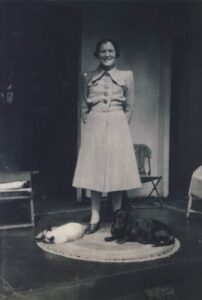
She did however maintain an interest in teaching. Mr Bowles who as a child so loved Ethel’s drinks and cakes found Rene more difficult to deal with. She would take over and ask him what he had learned at school, and had he remembered it? He was told he must study hard. But he was a more practical person, he now realises he was dyslexic. But he had very fond memories of them, sitting in the front of their house, two benches, a big pomegranate tree and geraniums. They were kind, and he used to do practical things for them, mending and so on.
Peggy remembers being told that because it was so hot Rene got up at
Peter Harrison remembers meeting up with the
Hollows [in the late 1960’s] who brought Rene and Gwenda to Standerton for a
family picnic. When he asked Rene what she would like to drink quick as a flash
she said she would like a beer. He remembers her as being bright and cheerful.
Rene was treated, in spite of her professional career, as the young one who needed looking after. Perhaps she had been ‘delicate’ in her childhood? She never seemed particularly deserving of such coddling and outlived all the others, having looked after each of them in turn. But this pattern of ‘babying’ the youngest was discernible also in the way Gwenda was treated, [and how I felt I was treated also].
Rene too lived to a good age, dying aged nearly 85 in 1973, somewhat ignominiously. She was found by Gwenda on her potty on the floor with her head on the bed. The sisters seemed to manage to live their genteel impoverished existence together reasonably amicably, perhaps because they knew they had no choice. The exception seemed to be Edie who, when she moved in [after retiring?] with, by their standards a very adequate pension, kept money for herself. Not for her, apparently, the sharing and scrimping and saving of the others.
All was not always sweetness and light. David recalls that when Rene was finally clearing out the house, ‘she threw all Ethel’s stamps into the fire in the garden. These had been a possible present for Audrey and she was very upset because Ethel probably had many very old stamps in this collection’
Gardie says, ‘There was the background in Oudtshoorn of complete poverty. Wages were at a complete minimum and the only way the aunts could make ends meet was to all live together. They couldn’t even go on holiday separately. When one moved they all moved, so they would all go to boarding houses, one in Port Elizabeth, another in Seapoint, when they could get away which was not very often’ This was not entirely true, as they did manage trips away, including to Johannesburg and Great Brak River.
And David too remembers then having holidays ‘quite frequently at an hotel in Mossel Bay-can’t remember the name-Marine perhaps. Rene showed it to me when we drove past and said they used to get a special rate out of season and loved it there because they knew so many people in the town. This hotel was just up from the old entrance to the harbour and close to the main shops. However the whole town is on that very steep slope, so it must have been quite hard for Ethel to do her shopping. The others were all quite keen walkers, so the slopes wouldn’t have worried them. At that time Mossel Bay was the popular holiday resort for all the people in the Little Karoo so they would have had many contacts there, some of whom had holiday homes in that area. ‘
I only met the aunts once or twice when they came to Johannesburg, and never saw the family home. I remember them as sallow slightly yellow leather skinned and Afrikaans sounding. Patricia says Ethel had the most marked accent, perhaps because of living a life largely confined to the house. English was the language spoken in the home, but their mother was of course Afrikaans, or Dutch. Their accent was important to me as we as English speakers thought we were superior to Afrikaners. The Aunts might have been horrified to know that what was probably a normal Cape accent was seen as second rate by one of their great nieces.
David Met too recalls their accents
‘About the Aunts strong Afrikaans accent, this is not surprising when much of their conversation in Oudtshoorn was in that language and their mother had been Afrikaans speaking. I as a child of 11 or 12, coming from Rhodesia, was particularly affected by this. On one occasion I remember clearly telling the Aunts that I could recognise that someone came from Oudtshoorn by their accent, anywhere in South Africa. This was not well received, because the Aunts obviously felt that they spoke faultless English and “they were not amused” by this pompous little pom from Rhodesia. Like my other cousins, I was also always a little ashamed of their accent in my earlier days.’
On their visit to Johannesburg in 1936 Peggy remembers Peter, aged 10, showing them around the Empire Exhibition with great authority.
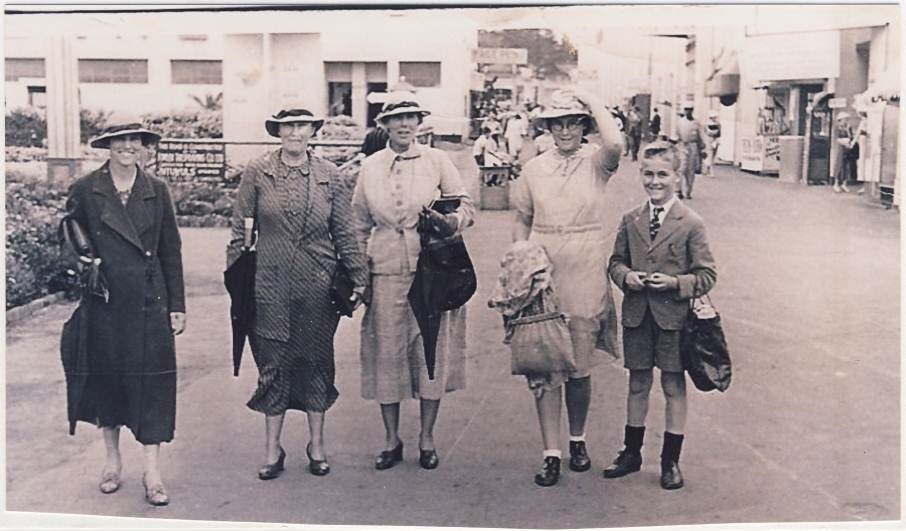
The Aunts with Peter and Peggy at the Empire Exhibition in 1936
Murie with two of her aunts in Jhb (1940’s?):
Mary and Rene?
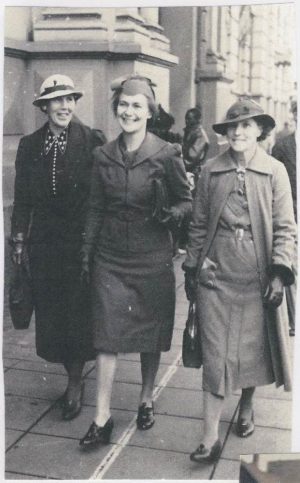
In our family are many tales of allergies. Lizzie with her asthma was not the only one. Peter Harrison says that when The Aunts came to visit they had to make sure the cat was locked up. [He also remembers Diana The Aunts great niece visiting and coming out with bumps. She said there must be a cat, although she hadn’t even seen the two cats]
There was always a strong ethos of keeping up standards. Stories of the family included [according to Hilda Boshoff in the Oudtshoorn Museum] that they were thought to be related to Napoleon [see the previous chapter on the Knipes of St Helena for possible reasons for this extraordinary sounding claim]. And according to Gwenda that their mother was French [presumably based on her French Huguenot ancestry]. Gwenda, brought up by The Aunts for much of her life was teased at school because of the way they dressed her. We don’t know whether they thought that high button up boots and old fashioned clothes were what was proper for her, or whether this was clothing they had handy and therefore saved them money from buying new. They were vehemently anti-German, perhaps not unusual after the memories of the first World War. And could not forgive Gwenda for marrying a German.
Their poverty became a big issue when, in the early 1950s with all of them alive but ageing the local authority were installing sanitation which had to be paid for. Until this time presumably the toilet was a hut with a hole in the garden. I remember a family collection being set up amongst all the nieces and nephews and their progeny to raise the needed funds. I think people were encouraged to ‘buy a brick’. This was for The Aunts final dwelling in Rudds Lane. Until then they had moved from one rented house to another. Their saviour was the man their sister Grace married quite late, Willy van der Riet. He was wealthy and bought a little double storied house for them for £400, reportedly saying they could pay off the money how and when they could, something that presumably they never did.
It seems strange to be devoting paragraphs or even pages to stories about a house. But anyone in the family who saw the place retained very vivid, if sometimes contradictory impressions. In some way the house in Rudds Lane and ‘The Aunts’ became an important part of the family history although we don’t know when they moved into it, saved by Willy van der Riet, their sister’s husband.
The legendary house no longer exists, reportedly having fallen down. In its place is an old age home. Jane found this slide taken by her father when the family visited her mother’s aunts.
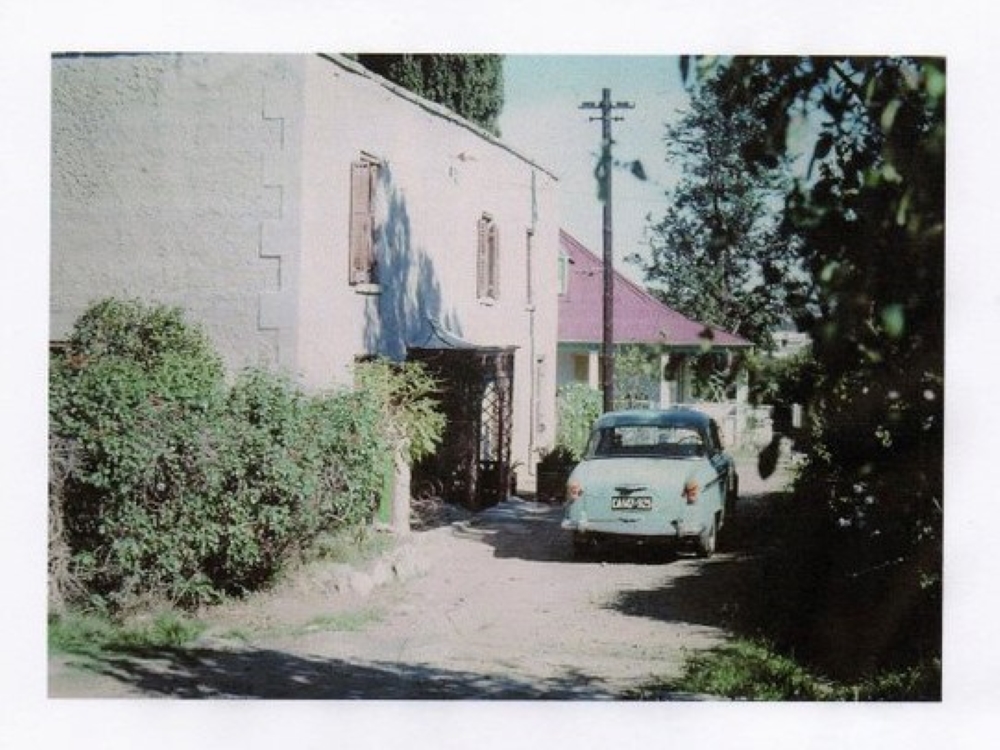
The impressions last. And the one aspect about which everyone agrees is how dark it was. So what follows are the [sometimes verbatim] reports of those that saw the house.
David Met wrote to add his reminiscences because he thinks he was probably the only one that spent quite some time with them during his school holidays in about 1940/41.
‘I do remember that the lounge was a special room on the left as you came in through the front door. It was always kept closed with the shutters also closed. I never was allowed in there other than to have a look. There were large sofas in there- dull green I think they were. The dining room had the large table, which Margie Ann had in later years. The other rooms were as described in your notes. Water was only laid on in the kitchen sometime during the War I think. It was not connected when I stayed in 1941 but was by 1946 when I lived in George with Gardie, after she moved down from Rhodesia.
[Around 1960]… Mason Edmeades and I fixed the flat roof of the house in Rudd’s Lane to try and reduce the leaks. By this time a toilet had already been installed upstairs. It had to be fitted on a concrete slab on the wooden floor, so you sort of climbed up “onto the throne” so to say. I think electric light was also fitted but this had probably been done quite a few years earlier. In the 1940’s I seem to remember they were still using oil lamps and candles—I loved it– romantic!
When I stayed there during the War I was always careful not to bump the walls too hard as it came away in great lumps of plaster and mud. The garden had wonderful fruit trees and in the season you could gorge yourself silly in the orchard. This garden opened up onto the Botha’s garden at the end. They also had plenty of fruit trees and an enormous old oak tree with a very old hammerkop nest in the middle. It was the biggest such nest I have ever seen and I was always keen to climb up to it but was always prevented for fear of my falling. Now-a-days I wonder whether it wasn’t to prevent my disturbing the birds! These are the same Botha family who also bought a Cottage on the Island at Great Brak River, which was subsequently rebuilt as a timber framed house. This lead us to do the same a year or two later. Their children Peter Botha and Mary Miller then had this Cottage for many years before Mary left for Australia and Peter sold out to part of his family.
The two paintings of Trafalgar and Waterloo always fascinated me. I well remember Ethel telling me, with much amusement, about the little Afrikaans boy who wanted to know “ wie is die Afrikaners en wie die Engelse”.
The Water Lead came straight down Rudds Lane from the Main Road and fed all the houses on both sides if I remember correctly. I used to get into trouble for playing in this furrow and damming it up on occasions, thus starving someone else of their lead water. It was great fun when it was our lead-time as I could then dam to my hearts content around our garden and flood everything without anyone minding.’
Mr Bowles [their neighbour who as a child used to climb through the fence to visit them] said that he said he could remember the house completely. It was unprepossessing, had a flat roof, probably brick painted a sort of off white greyish. It got into very bad repair after they left. It was below road level, and probably not maintained by the owner. Water used to run through it. The house was full of knickknacks, dark, shutters closed but for him full of very fond memories.
Gardie too remembered their house. It ‘was the quaintest double storey house which had once belonged to Miss Blant who was, I think, the sister of a local padre. The upstairs –it had a landing and three definite bedrooms, and a bathroom upstairs and a reed ceiling under a flat roof [which they] managed ultimately to replace. Miss Blant had run a little private school. I imagine the schoolroom must have been upstairs. Downstairs were a sitting room, and a large dining room and a breakfast room, and a big room at the back of the house, which A Ethel used for storage space. It had no light in it, and was perpetually kept in darkness, and closed and a kitchen, no water borne sanitation, a loo down the garden path. There was a tap in the grounds for water…
‘Oudtshoorn was built on a slope, and a portion could be fed from a stream which could be taken out of the river, and to which you had a water lead, [possibly] once a month. Your water lead could be at any time of the day or night, very often in the middle of the night. You had furrows all over your garden and you guided the water down the furrows. I have visions of A Ethel, who was the keen gardener getting up in the middle of the night to deal with the water lead…When the house was sold and was standing there empty, no one must have coped with the water leads, and it must have banked up, and the one wall of the house fell in entirely. You could go down the lane and see the top and the bottom storey with one wall completely missing at the end. It must have been one of those mud walls which had lasted 100 years, only to be swept away by a water lead that no one was there to deal with.’
‘There was no electricity, it was all lamps and candles. I remember when Ted Gwenda and I were sharing a bedroom at Oudtshoorn and the little lamp that had been left in our bedroom had smoked and the whole room was black and so were we…I learned that lamps were things you watched with care otherwise you suffered’
Patricia, Gwenda’s daughter says that their maid did the washing outside on a corrugated iron board and a stone. If she and Jennifer were naughty they were sent outside to sit next to it.
Peggy was told that it was built with ‘green’ in other words not baked bricks.
Penny remembers the house clearly ‘Double storey, square house, front door opened onto Rudds Lane. I think it was brown stucco [mud?]. Inside it was very dark always shuttered on the outside against the heat, with brown shutters. A large walled garden full of fruit trees. To enter as a child it was full of mystery. From Margie I gathered there was a large amount of antique furniture. She was given the dining room table with twelve chairs.’
Peggy also heard that there was a lot of antique furniture which Aunt Olga acquired, perhaps buying it.
Peter Harrison remembers a dark gloomy house, possibly greyish. It looked forbidding and he thought of Bleak House. You almost had to crouch a little to get inside where it was musty. Tiny little windows with huge thick walls. He remembers some agony about the toilet inside which wasn’t working and having to go to a toilet outside. Creaking stairs, a cavernous kitchen with an enormous coal stove in it. He didn’t feel that the sisters related much, living somewhat separate lives, with Rene being the most outgoing of the three at that stage.
Patricia recalls that there were two enormous pictures, The Battle of Waterloo and one of Nelson which The Aunts promised to give to her brother Michael. ‘But when The Aunts were very old Rhodesian relatives came and were told to take what they wanted, which is what they did. There was a little chest table which Gwenda had wanted because she had played at it. But she didn’t get it.’
We learn from this how different members of the family have different versions of events.
Ian says that at the end of 1968 they were visiting SA from Rhodesia, and that he was asked to go from Great Brak to Oudtshoorn to pick up Auntie Rene. ‘It transpired that several members of the family were after the bible my grandfather had given to his eldest son, William Penvil, and the Aunts had decided it should be given to me, hence the reason why I had to do the trip instead of Marjory. I was also given the English mahogany hand carved ‘lounge’ chair which was brought out by my great grandparents. Henry Edmeades subsequently told me that he had his eye on it.’ No mention however of the chest table!
When Rene, the last of The Aunts moved out my mother and others went down to clear out the home. The mass of old newspapers and rubbish resulted in my mother’s determination never to burden others, and she reduced her possessions over the years, sorting and throwing out as she grew old and moved from a flat to sheltered accommodation.
With all the attention from the nieces and nephews and their children being on The Aunts, far fewer stories have been told about the rest of Lizzies siblings.
Catherine Sophia [Kate] born in 1877 was in East London when she was twenty helping Lizzie with the birth of her third child Murie. And at 28 she married M J Whyte in Cape Town. They had one son, Kevin. The family tree gives no more information about her.
Grace Florence, born two years later in 1879 stayed and worked in Oudtshoorn, as a bookkeeper in a shop and also in the school board office for years, earning reportedly £5 per month. Late on in life [undated in the family tree] she married Willie van der Riet, the saviour of the unmarried sisters. He was a widower, a lawyer with according to Gardie enormous farming interests and also owning all the small cottages and houses in Oudtshoorn by the time he died. He bought The Aunts house in Rudds Lane for £400 on the understanding that they would pay him when they could.
Gardie remembers Willy van der Riet. ‘He always kept little baby ostriches to go down to the river bank and he had land down there. He lived in van der Riet Street. He’d go down to the bottom of the river on his lands and he would collect these babies and he’d say ‘coolly coolly coolly’ all the way up. And they would follow him all the way up Van der Riet Street after him. And they would be locked up for the night in a room he kept for them.’
On my visit to Oudtshoorn I walked down the street trying to visualize it as a lane up which baby ostriches would have run daily. It wasn’t easy to do so. I also went round the cemeteries and found a big grave for W v d Riet [who I assume was the famous Willy with his first wife and children round but no sign of Grace]. Did she not die in Oudtshoorn? Or was there no room for her in the family graves? The family tree simply says she died in 1946, aged 67.
Lizzie had three brothers who survived beyond youth: Leach, Lawrie and William Penvil the second [known as Secundus]
LEACH AND LAWRIE [This is how his son Ian spells his name]
There was only two years between Leach and Lawrie but sadly their relationship was severed because of the Boer War because they fought on opposite sides.
Leach Mason Knipe was born in 1880, and his brother Laurence Orlando in 1882. Neither of them had the privilege of the education at an exclusive Cape Town school which their older brothers had.
It was said that they were both told to get out and make their lives.
This Leach did by going up to the Transvaal, where he married Aunt Emmy, Emmerentia Johanna Christina Warden an Afrikaans speaker, in 1906. But by this time he had fought on the Boer side in the Boer War, something which reportedly resulted in a life time break with his brother Lawrie who had fought on the British side.
Mason his son said his father ‘fought for the Boers because he was a citizen and they lived in that part of the world… and when he got enough of the war he came home again and then the British Military authorities looked him up and sent him to Ceylon ..where he spent a long time, he worked in the Post Office…he said that’s the best holiday he’d had in his life…One day on the boat when he was going over, he wasn’t a good sailor and one of the old Oom’s came down from the top and he said something to the effect that the captain or somebody on the deck told him that there was only a quarter of an inch between his cabin and the sea. Dad who was sick as a dog said ‘well I wish the sea would come and just finish me up’ and the old one said ‘nieffie jy kan nie so ongeskrag praat nie’ you cant talk so recklessly. But they had a very good time, dad played rugby and cricket and when they got home they each had a canister of Ceylon tea. ..but it was very sad because …people were getting letters that they’d burned the farm down, and so and so’s in the Concentration Camp, so and so’s died in the Camp and..it was very sad for him in spite of the fact that he was having a jolly good holiday at the Queen’s expense.’
Mason recalled that there was an old gaol that was used during the war in Krugersdorp.
Mason also remembered that in the 1922 strike ‘I remember our woodwork master was shot going to Jhb through the Fordsburg dip, he was killed.’
Meanwhile Em who Leach married in 1906 was said to have taken goodies to the hospital.
Leach’s branch of the family was the one we had most contact with, possibly because they lived in the Transvaal. They seem to have been very supportive of the family. It was through them that my Uncle Ted met his wife Olga. She had been a lodger of theirs when she was a young teacher. They were involved in providing [and possibly financing] accommodation for my mother and three young children in 1931 when she left my father for some months. Peggy says that they also looked after Barbara [aged not quite four] when I was born in 1934.
Mason recalled that in 1922 Aunt Mary [of The Aunts] had long leave and his parents took her to Warner Beach for a month.
Aunt Em seems to have been another strong capable woman. She was religious being a Christian Scientist, and introducing Olga to Christian Science. She had a wonderful garden, and gave lessons in cake icing. But she was also a tailor, making most of her children’s clothes including a man’s suit. And she was a carpenter. Her son Mason still had a little table she made in 1922. Her children were brought up to live frugally. Milly said that when Pat, Em’s daughter was a little thing she was only allowed three dresses a week so she had to look after them and keep them clean. Mason remembered that his mother did not have a washing machine. Milly said that Aunt Em had told her that from the day she married every month she put aside a half sovereign from her housekeeping. When one day years later when Leach said that if only they had a deposit of about £300 they could buy a house, Aunt Em produced the money and they bought their first house.
Living in Krugersdorp he travelled to work in Jeppe by an old steam train initially, with a long walk to the station. Later, on in 1932 or 3 he acquired a car. He worked for EK Green Mason a large seller of alcohol [how did this sit with Christian Science which forbade alcohol?]. He first managed their Braamfontein bottle store, and the Krugersdorp bottle store opposite the town hall. Then he was their auditor, involving travel to Pretoria, Springs, Randfontein and Kimberley.
Pat Cole their daughter lived near us in Jhb, and provided flowers from her wonderful garden for our exhibits for the school flower show. And we kept in touch with their son Mason into his old age.
Lawrence Orlando [Lawrie] Leach’s younger brother married Elizabeth Maud Gerber who either owned or was left a farm, where they were married. They had six children one of whom, Ian was very involved in creating the Edmeades family tree.
Lawrie was Marjorie [Gardie’s] godfather.
His son Ian said that his father had been invited to run one of his uncle Edwin Edmeades’ farms, only one of whose four sons was interested in farming. The idea was, so he was told that in due course he Lawrie could become one of his uncle’s heirs. Lawrie said he did not want to cause trouble with his cousins so declined.
WILLIAM PENVIL [SECUNDUS] [1865-1919]
I was finishing off the editing of this part of the Edmeades family history, heaving a sigh of relief that perhaps at last I could at last move on to another section, when I came on a handwritten note from Ian Edmeades which talked of the death of his uncle William Penvil in 1919.
I looked at the family tree once again and was astounded to see that I had completely overlooked William Knipe and Maria Jacoba’s eldest son William Penvil the second [referred to as Secundus].
What an extraordinary oversight. This man, only 18 months older than our grandmother had not died when young. And yet he never appeared in family anecdotes, until that is this one reference to his death. He did not cause friction, scandals or happy memories. He simply disappeared off the family radar. Was he the person who took over the funding of the family and the younger children’s education when his father died when Secundus was 29? If he did why did no one mention this fact? If he failed to do so, why did no one mention that they had had to get by in spite of him? Why did none of his nieces mention him?
We knew we had one William Penvil mystery in the family, our English forebear whose origins we have not been able to trace. Now we have a second William Penvil mystery, his grandson, known for clarity presumably as Secundus which is how I will refer to him.
So we start this man’s life with his death at the age of 54 near Humansdorp. About this event Ian said that Secundus had ‘decided to visit his newly married young brother [Lawrie] in 1919 and when he reached his du Preez cousins at Andries Kraal he went down with the flu. My parents’ farms were about 10ks beyond the du Preez so they sent my Dad an urgent message and he was able to see big brother before he died.’ In another communication he said that Secundus had come from the Transvaal. So this was perhaps where he caught the Spanish flu which is presumably what killed him, and one cant help wondering how many of his du Preez relatives and their servants as well.
So we know that in 1919 he was in the Transvaal. And Jane has found an application for ‘a pegging licence for 40 claims at Driefontein 148’, an application for a mining concession in the name of WP Edmeades. [date?].
But what about the period in between? Once he had finished his exclusive education in Cape Town at SACS did he initially join the family business in Oudtshoorn, which would have seemed an obvious career choice? Or perhaps his du Preez relatives near Humansdorp? And then when gold was discovered in Johannesburg in 1886, did he like so many others take off for the Transvaal in the hopes of making his fortune? And failed to do so? And why was he visiting Laurie in 1919? They would hardly have known each other when young, with 17 years difference in age. So did Secundus maintain contact with his du Preez relatives [who lived near the farm or farms near Humansdorp which Lawrie acquired through his marriage to Elizabeth Gerber], losing contact with his Edmeades ones? If so why? This seems another question which the du Preez descendents might have answers to.
MP March 2012
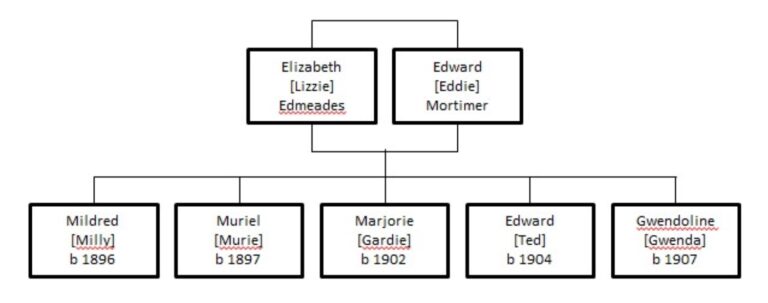
Milly and Murie
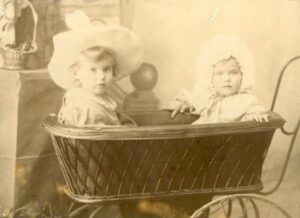
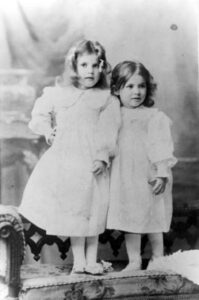
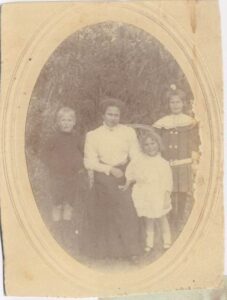
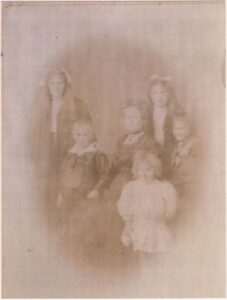
This chapter covers some of the same period as the last i.e. the first twenty years of the twentieth century, but from a different perspective, that of childhood. It is fortunate that all four of Lizzie’s daughters talked about their childhood. They were aware of how much life had changed since then, as were some of their children and grandchildren. And they and we felt they had a worthwhile tale to tell, which they certainly did. Now too late we can wish we had even more, and also their brother Ted’s story.
So this section does not focus on one person, my mother Murie, but on all of Lizzie’s daughters. It covers mainly the anecdotes they either recorded or told to their children. There is an inevitable duplication of some material with the previous section [the second Generation 2.2]. But the previous section focused on the family’s life from the point of view more of the adults, Lizzie, Eddie and their generation. Here I am trying to give more a child’s eye view of the family’s life in Oudtshoorn, Knysna and Lydenburg, as also the experiences of the children as they grew up. Apart from a few later anecdotes it ends by 1920 which was when the family was split up after their mother Lizzie had died. Milly and Murie were adults, and the remaining three children in their teens.
I have structured the anecdotes, into themes. But I have not edited any of the material we have so there is some duplication. The sections which follow start with education and problems of getting it [problems which strongly influenced family life]. Related to this were stories of travel, because getting education frequently involved moving residence. Then there are evocative pictures of the reality of daily life, and the excitement of excursions.
Stability and settled family life were not a feature of the Mortimer children’s childhoods. Their mother’s death in 1917 brought about the final division of the family but traumatic as it was for many of them, it was just one more parting, separation, move, and change for the children.
What is striking in the anecdotes is that although Lydenburg was the one town which the family might have called home because it was there that both parents and all five children lived together for some years, the sisters’ anecdotes feature Oudtshoorn and Knysna as much as they do Lydenburg. And Johannesburg where Milly was born, and East London where Murie was born hardly feature. The childhood stays there were apparently too brief.
In Oudtshoorn lived the children’s Aunts [their mother’s sisters] and until her death in 1911 their grandmother. Much of all five of their early childhoods were spent there, in spite of both Ted and Gwenda being born in Lydenburg to where their father [and on and off their mother] had gone. It was in Oudtshoorn that all of them lived for much of the time until 1910. And it was to Oudtshoorn that after their mother died in 1917 Gwenda aged 10 went to be brought up by her mother’s four sisters. For Gwenda Oudtshoorn became home, after the previous seven years spent mainly in Lydenburg.
In Knysna, in the Rectory lived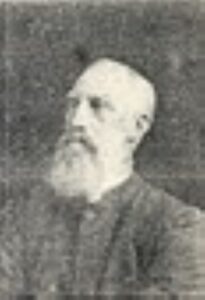 their paternal grandparents, Benjamin Clapham and Ellen Mortimer where he was the minister.
their paternal grandparents, Benjamin Clapham and Ellen Mortimer where he was the minister.
Although Knysna did not become ‘home’ for any of them except Ted, they all spent a lot of time there. Milly and Murie when very young were there when they and their mother left the Transvaal for safety during the Boer War. Later they were there for their education. But from the many anecdotes it seems that there were other periods when they lived with or visited their grandparents in the Rectory. And for Ted it became home when he went to live with his paternal grandparents after his mother died when he was 13.
What emerges from the reminiscences of their education are the difficulties that had to be overcome to get an education beyond the basics on offer. Parallels come to mind of the situation of so many black people even today in South Africa who have been offered only basic, and often low standards of education, and whose families have to be determined and be prepared to make sacrifices in order to overcome the barriers. For these people today as for the Mortimer/Edmeades family in the early part of the 20th century, one must pay and/or travel and move to get reasonable education.
Without further research it is not clear how much harder it was for girls than boys to get a good education. But from these accounts it seems likely that boys too may have had problems. In South Africa at the beginning of the twentieth century, there was not only a shortage of schools providing education beyond Standard Seven, education presumably only available to white pupils. There was an added problem, that of language. Schools do not seem to have been bilingual, so whether there was education available in English or in Afrikaans seems to have depended on the location in which one lived.
Many families would not however have regarded girls’ education as important as that of boys. It is striking that in the Edmeades family right from the arrival of the family in South Africa in the early eighteen hundreds girls were educated. And this may be equally true in the Mortimer family, because Ellen, the children’s grandmother had been a teacher in Yorkshire before she came to South Africa to marry their grandfather.
Milly and Murie [and Marjorie, and Ted?] started their schooling in Oudtshoorn. Both Murie [and probably Milly] stayed there until Standard 4 when they continued at Knysna until Standard 7. Murie said that village schools went up to Standard 7 so perhaps their transfer to Knysna from Oudtshoorn was because their mother Lizzie was moving temporarily or permanently to Lydenburg from Oudtshoorn.
Murie’s earliest memory of school in Oudtshoorn was sitting on the floor singing as they rowed an imaginary boat. ‘Here we float in a golden boat, far away far away’ sung repeatedly.
Then another memory of being in Standard 4 with Aunty Mary Edmeades [her mother’s sister] as teacher and she Murie leading the class into the Hall for morning prayers because she was the smallest or shortest and so was the leader. When she put a rusty garden fork through her foot and developed blood poisoning, the foot swelling up, she was dragged to school in a little wooden toy wagon, something her sister Marjorie envied.
At the Knysna school after completing Standard 7 she [or she and Milly] stayed on with 3 boys for another year, with studies being taken by the principal in the library, and called ‘ex 7’.
But then came the move in 1912 for the two of them to join the rest of the family in Lydenburg, and she was once again put into Standard 7. As she said ‘I suffered from the clever child syndrome’. It seems probable that there must have been major family pressures for her and Milly to have been sent to Lydenburg with such consequent disruption to her education. Possibly Lizzie was determined to try and establish a settled family life in Lydenburg where she had taken the three youngest children in 1910 to join their father. A few years later Murie returned to Oudtshoorn to complete her matric. Perhaps it was not possible in 1912 for a girl to take matric in Oudtshoorn whereas it was in 1914? As there were only 5 people in her matric class in 1914 perhaps education for girls in English beyond Standard 7 was only in its infancy in Oudtshoorn at this time? Her mother, all those years earlier had been able to matriculate in Cape Town and would have known of the advantages, and presumably the aspirations of her daughter. But finances did not permit such a move, so off to Lydenburg to repeat Std 7 she went.
Murie’s memories of the low standard of education in Lydenburg in her one year there are vivid and telling.
‘This principal took his job lightly and spent most of the day in his office. So Milly and I occupied ourselves teaching our companions what little we had learned at Knysna of Algebra and geometry. They in turn educated us in the story of the Boer War and concentration camps etc. The principal had one love – English poetry – so each day we were given 20 lines of poetry to memorise and next day we would be lined round the room and each pupil uttered the lines. Those poor Afrikaans pupils, promoted from farm school, struggled badly. I remember learning ‘Young Lochinvar.’’
Another teacher was ‘Meester’ who ‘taught us the new printed language called Afrikaans. He had been trained in Holland in the Dutch language, and he had to learn this new language in order to teach it to us. We were naughty pupils and played during his lessons’.
In 1913 after a year in Lydenburg Murie left the school, and for six months stayed at home to run the house whilst their mother went away to look after Milly who had had a mental breakdown in Grahamstown. Then in August she was sent back to Oudtshoorn High School where she passed matric in 18 months, in December 1914. This was in spite of never having learnt botany or Latin, and having ‘to swot up.’ This is remarkable as she was also the only one of the five pupils there who passed.
From there she went, in 1915 to the Pretoria Normal College for what she described as a three year teacher training course, but which she left in the middle of 1917 after only two and a half years. ‘Here I was rather bored with the lecturers and lectures as I longed to go to University. However we couldn’t afford this.’ A bright spot seems to have been meeting someone she described as her dearest friend Frances Metelerkamp, with whose family she spent weekends.
Back in Lydenburg in July 1917 to take up her first teaching post, she had then to cope with her mother’s sudden death, her alcoholic father, her fragile sister Milly, and her younger siblings, until their aunt Ethel arrived to look after the family for the following six months.
We have no first-hand accounts from Milly of her education experiences. She and Murie who was 11 months younger, seem to have been educated side by side for much of the time, but she was able to leave school before Murie, and go to the Teachers Training College in Grahamstown [possibly in 1913]. If this is so then her reported breakdown must have happened very soon after she got there. On her return home she continued her education in Lydenburg, studying music at the Loreto convent. And from then on gave music lessons in Lydenburg until she married Jim Yates at the end of 1925.
Marjorie [Gardie] must have started school in Oudtshoorn, which she left for Lydenburg when she was eight. She recalled her Lydenburg school days, and teachers. ‘The headmaster was Mr Marrin? and when I reached Standard 6 my form master was Philip Moore who ultimately ended as the head of the stock exchange in Jhb strange to relate. He was an Englishman who had come out and this was where he had landed. And there was a dear old Scots lady Miss Imrie who was a great friend of my mother’s and who always talked about Churrrrch [with a long rolled r]. She was a petrifying old dame who took all of us.
When I was in Std 3 there was Std 2 combined with Std 1 and I think Ted was in Std 1. It was the days of pen and ink and he upset the ink and she was very apt to hit you over the knuckles with a ruler, and I remember when she was getting very irritated I rose in my wrath. I don’t know what happened afterwards, but I objected very strongly to Ted being chastised for what he did. But I always was agin the government! This is one of my earliest recollections of being against authority.’
When she was 12, in 1914, Gardie was sent to boarding school, to Pretoria Girls High. She says she had to leave because the Lydenburg school only went up to Standard 7. Her chance of a good education came about because she won a bursary, although she said ‘I didn’t actually win the bursary, a government one. I was second. A boy won, and his father said nonsense he didn’t have to do anything further in the way of education and so then the bursary was offered to me. It was a half bursary, £6 a term, and my dad had to pay the other £6. You went to boarding school for £12 a term’.
She, like Murie, had fond memories of the Metelerkamp household at the Premier Mine. ‘We had one long weekend a term when you were allowed out of this seclusion. But you had to have a written invitation from your hostess, you had to be collected from the front door and returned to the front door at the end. It was a whole performance. Anyway Murie asked Frances whether little sister couldn’t go out to the mine for her long weekends. So for a couple of years they took me out there periodically. So I met the Mets but not Aubrey’ [her future husband].
Gardie was in Pretoria until 1919, and remembered the victory celebrations in Pretoria, and having some sepia snap shots of these.
She seems to have been perhaps the first in the family to have really good teachers, possibly because of the War. She said ‘Now you have to remember that in those days they were desperately short of teachers in SA. When I went to school at Pretoria Girls High every single one of the mistresses was from England, from Oxford or Cambridge. The only South African one was our history teacher Miss le Roux from Graaf Reinet. Our principal Miss Aitkin, E [or EAS?] as she was known was a terrifying person and Miss Hamlock our maths teacher who ended up as head at Potch, and Miss ?clefin? our English teacher, all had terrific degrees and we really were given a very excellent education. And a much broader education than you get today. So much concern is spent on the scientific side of life that there is no time at all to diverge into world history. We were really well taught if sketchily, leaving us with a clear picture of the history of Canada, of the history of the USA, of India, and the men involved and even Australia. We certainly got into the British wars within Britain itself. But we were given a general education, not particular emphasis on subjects that you need to earn a living as people are today.
As far as women were concerned they were able to earn their living as long as they were single, but the moment you married, even when I was teaching you were out on your ear. You weren’t even kept to the end of the term if you chose to get married’.
After school she spent two years at the Pretoria Teachers Training [Normal] college. She then taught for 2 years in the Transvaal, Murie saying that this was in Florida, but Gardie mentioning Ermelo.
We know little of Ted’s education. His early education must have been in Lydenburg, as Gardie recalled. Later, according to Murie, he went to Pretoria Boys High.
We have Murie’s recollection of their mother attempting to get two year old Ted to memorize Latin rhymes which were so popular ‘mensa, mensam etc etc. Alas, she records, when Ted reached that stage in his schooling, Latin floored him completely and he had to drop it.
Gwenda had yet another pattern of education. Starting in Lydenburg, from the age of 10 on she was educated in the Cape. This was because her mother died when she was 10, and she was taken down to Oudtshoorn to live with and be brought up by The Aunts. After initial education in Oudtshoorn, she was sent to St Winifreds School in George. According to Gardie Gwenda was one of the first pupils at St Winifreds the year the Anglicans opened it as a church school. It is possible that the costs for her to do this were waived or minimal because of her Mortimer grandfather being a Canon in Knysna. As a postscript Gardie added that by chance she was living in George the year the school was closed, possibly 1944.
Gwenda was yet another victim of poor education standards, although she seems to have enjoyed some of her time there. She wrote and, along with all but one of her fellow pupils, failed matric, ending her formal education at the Diocesan School for Girls in Pretoria [possibly paid for by Murie and Gardie?] where she did finally gain her Matric. The only girl that passed at St Winifreds was the mother of Fanie le Roux. He and his wife Veronica and their family were great friends and supports for Gwenda throughout her life.
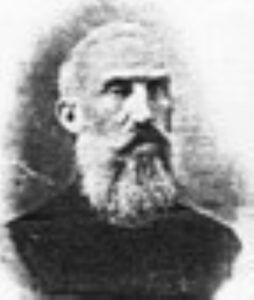 Gwenda’s positive memories included ‘rolling up their dresses at the beach, outraging the community’ according to her daughters. And she was occasionally visited by her grandfather Mortimer who she adored.
Gwenda’s positive memories included ‘rolling up their dresses at the beach, outraging the community’ according to her daughters. And she was occasionally visited by her grandfather Mortimer who she adored.
She remembered that he had a shock of red hair, and employed a housekeeper called Mrs Maggs. He used to come to visit her at school driving his pony trap and would take the girls out for picnics. He was also much loved for bringing Gwenda tuck boxes. These were not strictly allowed at school, but because it was an Anglican school, and Benjamin Mortimer (BCM) was an Anglican minister the teachers did not feel that they could refuse them.
The negative sides of her education were that the Aunts made Gwenda wear button-up shoes to school, which she hated because they were so unfashionable. She also hated the school’s insistence that the girls should inhale salt water every morning to prevent colds. And Gardie recalled hearing all sorts of horrors from Gwenda about having to go all alone on the endless train journey from Oudtshoorn, including waiting for hours at De Aar Junction.
Gwenda determinedly ended her formal education with a daring, rebellious act. Sent off by her aunts to Teachers Training College, and determined not to become a teacher like so many women in the family, she ‘got off the train and went to work in the bank instead’. Murie says this was in Rustenburg, hardly on the train line from her homes in Oudtshoorn or Lydenburg!
The family moved around an amazing amount when one considers the difficulties of travel in those days, the distances to be travelled, and the relative poverty of the family. Much of the travel resulted from necessity – the need for suitable education, the lack of stable family homes, major family or national events like the death of their mother or the Boer War, economic pressures on both their parents to earn money, and perhaps over all the state of development of the country where job opportunities came and went, and populations moved.
Very little mention is made of how the family managed the journeys from Oudtshoorn and Knysna to Lydenburg, although that seems to have been a relatively common happening. We only have Gardies memory of their father Eddie sailing from Knysna to Cape Town [en route she thought for Jhb]. And her report that Lizzie was said to have travelled by train and coach when she left Bloemfontein for Johannesburg in 1894. In 1910 the railway reached Lydenburg, so Lizzie’s journeys before then must have been partly by coach.
Some of the travels seem to have been very exciting for the young people. The journey between Oudtshoorn and Knysna, now a matter of 2? hours at times involved overnight stays and changes of methods of transport. We have both Gardie and Murie’s memories.
Murie recalled several Oudtshoorn-Knysna journeys, in a handwritten section of a memoir headed Happy Expeditions from Oudtshoorn.. ‘..in a donkey wagon. Uncle Laurie Edmeades, Dad and a Cape Coloured boy to herd the donkeys were our drivers and we took two of mother’s sisters with us. We camped at the North Station on the Outeniqua Mountains, and bathed in the mountain pools. It was delightful. When travelling, most of us walked for hours, picking blackberries which we stewed at night on the camp fire. The men slept under the wagon. We tied up little bags with treasured possessions inside the hood and must have been frightfully cramped sleeping under the hood. Between George and Knysna we trailed down curving roads to the sherry coloured rivers and then up the other side. There seemed to be endless rivers to cross in this manner and we enjoyed bathing in them’.
Another expedition involved ‘going over the Robinson Pass with Dad in a little one horse trap and sleeping with a family on the Pass. This was my first experience of a feather bed which enveloped us.’ [Is this from Lydenburg or Oudtshoorn or Knysna??]
On at least one occasion she and Milly travelled from Oudtshoorn to Knysna by post cart, ‘sleeping at a Hotel in George where the hotel keeper had been asked to see we caught the post cart early next morning for Knysna.’ There was a reverse journey ‘by wagonette driven by a Cape Coloured man. He was in charge of six of us children and we slept at Avontuur the first night and then went on to catch the train to Oudtshoorn at Uniondale Road to stay with various relatives’.
Gardies memories may recall the same journey as Murie. To her this was ‘an epic trip from Oudtshoorn to Knysna. There were no such things as trains at Knysna. I don’t know if the ordinary trains were running in Oudtshoorn, I think they were – we seemed to have left by train at some stage or another. Heaven knows which pass we used – Prince Albert I rather imagine. It was a donkey wagon and we camped out on route. I think I got kicked by a donkey. I was told by my elder sisters that I was quite impossible, that I didn’t have enough room, at night when we were all packed inside the wagon to sleep. There was a crowd of us. Whether we all fitted inside there heaven knows. But we must have. Where else would mother have been if not with all of us?. It was a really epic trip but I don’t remember much.’
She recalls also a boat voyage. ‘When dad was leaving presumably for Lydenburg and we were all in Knysna staying with grandfather. So that may be the time we all went over. And Dad sailed in a little sailing ship over the bar. I remember quite clearly, but where he sailed to I don’t know, think to Cape Town where there would have been a train. That is the only time I remember a ship going over the bar at Knysna, and we all stood waving goodbye’.
She also thought that when Milly and Murie were going to travel to the Transvaal [presumably to join the family in Lydenburg] there was no direct transport. ‘They went to George and they stayed at the hotel. It was called the Victoria. It had been the Drostdy. It was converted to a hotel and is now the museum’
She also recalled Ted being sent down holidaying sometime in his youth with the grandparents in Knysna.
The family seemed never to have lived in any one house for long enough for it to be called the family home. In Lydenburg Gardie recalls several moves of home.
The one dwelling which provided some stability and a sense of home for Lizzie’s children was the Rectory at Knysna in which always lived Grandfather and Grandmother Mortimer. It certainly evoked happy memories for some of the youngsters. Murie said they were the happiest years of her youth.
Although the town of Oudtshoorn itself was an important part of their lives there was no permanent family home there. Their aunts [and presumably their grandmother until she died in 1911] moved house from rented accommodation to rented accommodation until finally Oom Willie van der Riet bought the house in Rudds Lane for them, possibly only in the 1930s or 1940s. Gardie, for instance, recalls them living in a house in St Saviours Street, the road parallel to Rudds Lane. It seems likely that in Oudtshoorn Lizzie and her brood rented their own accommodation at times [hence the story of Gwenda as a baby being passed through the fence to her grandmother, when her mother was teaching].
What does seem to have been constant was that in each of these three towns there were other family members, as well as the opportunity to build up close friendships, many of which were life long.
Life outside the home seemed relatively simple and pleasant. The lack of money was not unusual. As Gardie said ‘ no one had a lot of money, and there was no vying for clothing as far as children were concerned, as long as you were clean and neat And if we had a little homemade frock as long as it looked quite pretty you were quite pleased with yourself. Its queer to see shops these days cater mainly for the young. Because in the early days children didn’t seem to matter. We didn’t have to paint our faces. We didn’t have to do funny things to our hair, we were just natural.’ And there was fun and entertainment and excursions, even if at home there were tensions, and an alcoholic father. Oudtshoorn was a place which Gardie had many fond memories of although she only lived there until she was eight, but visited later.
‘My clearest recollection of Oudtshoorn is of pepper trees and tortoises, which abounded. I spent many hours making mud walls to enclose my tortoises. And could never understand how they simply climbed over walls. Another recollection was of Murie and Milly playing in the garden and I think Milly put the garden fork through Murie’s foot and there was a little express wagon [to pull round]. Murie couldn’t walk so she was pulled to school in the wagon and of course I envied her greatly and wished somebody would put something through my foot so that I could ride to school in this wagon’
‘I know I had a doll which was a great treasure of mine and it disappeared and the children across the road [I think he was a shoemaker or something] had gone sneaking off with it. It was got back again but there was terrible upset’.
She also remembered another upset when Ted as a little child swallowed something large.
She remembered Granny Edmeades and the aunts all living in the same house up St Saviour street. ‘Granny was a very tiny little person and she had something radically the matter with her, and had to have the doctor come and tap something out of her She was very delicate and the doctor perpetually calling’
Also she remembered ‘Uncle Willy who married Auntie Grace at a late stage. He always kept little baby ostriches to go down to the riverbank and he had land down there. And he lived in van der Riet street. He’d go down to the bottom of the river on his lands and he would collect these babies and he’d say’coolly coolly coolly’ all the way up. And they would follow him all the way up van der Riet street after him. And they would be locked up for the night in a room he kept for them. I think that was a subsequent recollection probably when I was at boarding school and went down on holiday.’
‘Our granny Edmeades in the days of her youth had a great big preserving copper pan with a great black handle in which she made all her jams. You did your own jam making and preserving of fruit. You had to have a pantry because in the fruit season every housewife was very busy making jam and canning fruit to see the family through. It was extremely important.. it had a great black handle. I believe our granny Mortimer in Knysna used to use used four gallon paraffin tins and fill them.’
‘The year that we left [Oudtshoorn], I think it was all in that year, which was 1910 two things happened. I can remember standing out in the main road with a crowd around and some proclamation being read out from the magistrate’s office steps. I imagine that may have been the declaration of the union of SA but that I am not sure of. The other thing was enormous jollification where they had enormous games and sports down at the sports ground and we kids had to perform in a maypole much to my irritation and disgust. I was a difficult brat anyway. It didn’t please me at all. I don’t know whether that was when King Edward VII, Teddy finally came to the throne for such a short time. But there was enormous jollification.’
Another memory was ‘when Ted Gwenda and I were sharing a bedroom at Oudtshoorn and the little lamp that had been left in our bedroom had smoked and the whole room was black and so were we. We must have looked very funny. I learned that lamps were things were things you watched with care otherwise you suffered.’
‘I know people went to the Cango caves but I never went because in those days as far as I know they climbed down a ladder, and they took magnesium flares and then they were told to light their flares to see what they could see. I do know that people used to chip pieces off because I remember seeing whole 2” or 3” stalagtites or mites on peoples mantle pieces. And they were very proud of themselves without realising that what they had destroyed had taken thousands and thousands of years to make. It is quite incredible the destruction that man will do.’
But Murie did have an expedition by cart and horses to the Cango Caves which took from 4 am to 8 pm. ‘There was no electricity and the guide burnt magnesium flares to give brief views of the marvels. We children were left in the pitch dark at the top of a hanging ladder whilst the adults went on.’
Grandmother Edmeades died before Gwenda and possibly Ted, would have remembered her. But Gwenda was brought up on story that she was French in origin [which was actually true, but a long time back when her du Preez Huguenot ancestors came to SA]. The story seemed to help add status to the members of the family, which in the previous generation had ‘come down in the world.’ Being French was apparently more desirable than being Afrikaans.
In Knysna Grandfather [Benjamin Clapham] Mortimer was such a large character, that he seemed to have eclipsed Granny, of whom there are few stories.
Murie remembered her having one of the earliest sewing machines with which she made them several dresses
But Grandfather was the dominant force. Murie remembers them all hiding in the bushes in the Rectory when the calls came through the day of ‘anyone for church’. He was remembered with fondness by Gwenda and other youngsters. But he could also be an intimidating character. Gwenda remembered being with him one day when he stopped a parishioner in the street and boomed at her “Mrs Marais! I do not recall seeing you at church last Sunday’. Similar stories were recounted by others.
And Milly remembered the first car. It was when ‘the Bishop came to visit (I think Bishop Sidwell) and looked at my music and asked me which the most difficult piece was, one called Alice and he said I must play it for him’.
There was no electricity in the streets or homes, only lamps and candles
Milly and Murie were complicit in fabricating [or just possibly being told] stories of their Mortimer grandparents which added to their possibly mundane seeming existence. Some of Milly’s recollections may however have been based on fact. These were that ‘The Anglican church was mainly built of all the £200 my grandfather used to donate anonymously. … I heard that through the diocesan Magazine.’
Also that ‘he was paid a double salary – paid by the British Christian Bible Society and also by the South African clergy, paid to look after the mission schools, and kept books which he donated out to the schools from the London Missionary Society’
However, the next part of her story does not tie up with the facts later discovered. But according to her ‘he was ostracized from his family because they had cotton mills and wanted him to become head of the cotton mills and instead he became a clergyman, so they ostracised him and the Society took him over and often when he was hungry he would go into the chemist shop and buy a tablespoon of cod liver and this would help a little.’
Murie’s story was somewhat different, but has the mill owning aspect in common. She said that she and Milly created a scenario based on two occurrences.
1] every year grandfather sent out a large Christmas mailing, with which they helped him. They noticed that in this there was never any mail to family in England, or that anyone in the family was spoken of.
2] Granny Edmeades sister [known as Polly?] came to visit from England. Not only did she dress funnily, but she also spoke funnily in the eyes of the two little girls.
From these two they constructed the story [possibly aided by some exaggerations from grandfather?] that grandfather the mill owner’s son had fallen in love with grandmother, a mill girl and so had been cut off by his family.
The truth was that their great grandfather had indeed been involved in the wool trade in Yorkshire, but as someone who bought and sold offcuts from the mills [there is/was a name for this occupation]. And grandfather had siblings who were so much older than him that they had probably quite easily lost contact. And Grandmother, so Jane has discovered from the archives was an educated woman, and a teacher before she came out to South Africa to join Grandfather.
As to Grandmother’s sister’s oddities [seen by young class conscious minds as denoting inferiority], for her to have found the fare to travel at the beginning of the 20th century from England to the Cape, did not suggest humble origins. And her clothing may either have been the height of fashion in Britain, or simply clothing more suitable for Yorkshire than the Cape.
Milly commented on the snobbery that went on in Knysna. If you worked in a shop you were taboo, only clergy, bank people, auditors, accountants, lawyers and so forth were alright and on one occasion there was a big birthday party given for us kids and there was a great argument as to one of the lads to be invited or not and they decided against it because he was the butcher’s son. This boy ended up marrying the English Professor’s daughter from Stellenbosch and became a leading lawyer in Pretoria.
Murie recalled venturing into the Knysna forest which was possibly rather hazardous because there were elephants there. One looked out for signs of fresh droppings, and fled if one saw them. There were happy expeditions from Knysna. Murie recalled ‘short holidays at Uncle Ernest’s farm ‘Eastford’ on the coast probably where we learnt to swim’; visits to the Heads; ‘accompanying Grandfather in a little trap when he went to Belvedere and Plettenberg Bay to take services.’
Lydenburg was where the younger children moved in 1910 with their mother, presumably by train which that year reached Lydenburg. They were followed two years later by Milly and Murie.
Lydenburg stories were many, mainly from Gardie. Although she said she hated Lydenburg from the start she provides many positive vivid memories. Murie’s stories of her mother’s life in Lydenburg are in the previous chapter.
Gardie said ‘we three arrived in Lydenburg. Through the years we never owned our own home. We always seemed to be moving from pillar to post. I suppose it was as often as I say. I can remember at least 3 houses. My earliest recollection is of a house we arrived to which was on the outskirts, on the furthest streets. All the roads were dirt, there was no electricity. All the water was pumped from the garden. Lydenburg had rivers all round it – 3? And there was never a shortage of water, and underground water just a few feet down so you had wells. And lamps and candles and I never saw electricity until I went to boarding school in Pretoria at the beginning of World War I.
We lived in that little house for some time and then we moved into what I remember as Dick Hyatts/Hides? house, presumably he was the owner. It was a complete sin [?] and we climbed up into the loft and found it full of papers and we said to our dad what should we do with them. He said just burn them, and Bertram Cairncross [who throughout my life I have encountered here there and everywhere finally into George and an old age home]. He was always a collector and even as a schoolboy he looked through these papers and kept one or two of them. Some of them signed by Paul Kruger, letters of transfer and properties. So we must have destroyed a lot of history and my dad didn’t even look at them and just said get on with it.
And the well in the yard was I think only a few feet deep, and there was always this pumping of water. We all had to be bathed. By this time I think Milly and Murie were with us, and Murie was I think going to the normal college in Pretoria and so the whole family needed to bath. The water was heated in paraffin tins on the coal stove and then carried into the bath and we bathed in turn. I think our mother had a hip bath in her bedroom.
I don’t think she ever had a bath in the ordinary bathroom.
Dick Hyatt’s house was on the other side of Lydenburg and much nearer the swimming pool which was a great joy to me because in any of my spare time I went swimming.
We had a funny little horse and trap. Ultimately it was a mule, but at the stage I remember it was a horse, and we kids had no special riding equipment. We just put on our ordinary clothes and went riding. It must have been some sort of a spectacle really. I couldn’t bear our old moke of a horse, it was so slow and Connie Jennings had a spirited horse called Musep? And she was petrified of it so we swopped horses. He didn’t like anything behind him. He used to kick out madly with his hooves and I loved him. We used to go riding all over the countryside and I remember climbing a tree and getting all full of birds nests and all the creepy crawlies you find in birds nests. So we really enjoyed ourselves from that point of view.
Lydenburg had dirt roads but down every street ran these lovely furrows of water which were full of tadpoles and lovely things exciting for children to play with. We used to catch the tadpoles and play with them.
There was tennis amongst the young – Jan and Rolf Schurink and we used to play on their tennis courts.
Every Xmas holiday all the mothers would get together and hire a donkey wagon, and this would be the great thing. There would be on the back of the wagon a large box with the food for the picnic, and all the kids were crowded onto it. I doubt that it was six miles out to a spruit, and just puddles of water and stones, no water for swimming, but half the fun was the donkey wagon and you walked and played the fool and climbed on and off along a dusty road. I never remember any difficulties. I don’t know whether all or other of the mothers come, there must have been adults but I don’t remember.
Money may have been lacking, but social life and fun were still to be had especially those involving getting away from home. Excursions away were fondly remembered.
Murie recalled childhood and later excursions going ‘on horseback with Dad to Winslows mining at Vaalhoek: going to Pilgrims Rest to put on a play there. Also going for Allon to play in a cricket match; picnics up the Kloof behind the station; by train to Middelburg with Allon’s Cricket team; to Graskop to look down “the edge of the berg”; to Steenkampsberg [beautiful mountains] with Dad in a little one horse trap.
Milly recalled hunting excursions from Lydenburg. ‘ all night as soon as we got to the camp an enormous camp was made. A fire was built and two natives would stay awake all night because of the lions and to keep the wild animals away. The native beaters used to drive the buck into quarters so they could be shot.
I was away in the bushveld for 3 weeks and it was the most wonderful holiday of my life. They used to shoot the buck and cut it into biltong. We only ate venison and vetkoek. I suppose there were farmers and we had potatoes and carrots.’
Gardie remembered that ‘the men went out shooting periodically. Every household kept a pointer dog even the Mets on the mine. Even Pop Met in the early days went out periodically. In Lydenburg they must have gone out to the mountain towards the Kruger National Park, perhaps once a year great excitement about the shooting party and they would come back with perhaps one buck or some trophy, always buck of some sort’
She also remembered clearly ‘In Lydenburg in a very smart house up the rise a bit, a nice area, nice garden, real affluence, lived Mrs Macintyre with her daughter. There had been 3, 2 of whom were married. But Effie the youngest lived at home. She ultimately died of a tumour on the brain. My dad was responsible for collecting church sustentation fund from various people and of course he did nothing of the sort. He sent poor miserable brat which was me to do the collecting. And I was anything but brave when it came to asking money of people. The Sustentation fund consisted of 2/6. Time to collect from the Mcintyres along a dusty road. Half the time I would be told they weren’t at home, half that they didn’t have 2/6 at the moment. These were the wealthy people. She [Effie] was very friendly with Milly and Murie. She talked about ‘papure’ never papa. So we always talked about papure and manure, who was mother. That was our joke. They had a proper carriage, with a step. When Mrs Mc went calling she went in the carriage and 2 horses, very smart.
In those days everyone had an at home day on the first Monday of the month and you would move in droves from one tea party to the next.
We three children had lived at the Cape where a penny would buy you a little twist of sweets. So we arrive in Lydenburg and the first thing I remember was going to a funny little corner shop and asking for a pennyworth of sweets to be greeted with an absolute shriek of mirth from the proprietor who said obviously you come from the Cape. We don’t sell anything for pennies here. The least you can spend is a tickey. A tickey did such wonders for you.
I became very friendly with a girl called Connie Jennings who was younger than I and we instituted a signalling system from the roof of our outhouse, a white flag. And the one said ‘can you come and play with me’ ‘no I can’t’ This was a great game with us. Down below us was one of the rivers and as you know with most SA streams with no rain have little water if it is running at all. And this was one of those very innocuous ones which we used to run down to and play in the water. at some stage our grannies sister, I only remember her as aunt Polly arrived in SA and was doing the rounds everywhere and she arrived to stay with us. And we children said ‘come on down to the river with us’ and she came down and these terrifying stories of rivers flooding, she was watching this river all the time in case it came swooping down on us and we thought this extremely amusing as there had been no rain and no possibility of it coming down.
Then on the far side of Lydenburg where the river really ran swiftly they built a weir with a sluice gate for flood times, and made an effort to put a stone wall because the bottom was all mud, and steps and some sort of rough bathing changing place for everyone in Lydenburg and of course it became a great joy.
A nostalgic memory I have is of grinding and roasting the coffee.
In Lydenburg we got huge catalogues which came from England from stores which dealt with everything, from clothing to household linen to toys, to everything you can think of. We ordered, and we were part of the empire so there were no taxes or anything. And my shoes were 12/6 a pair. When a man is earning £25 or £27 a month and he has five children and a wife to feed and to clothe, you think of 12/6 being a tremendous amount of money. And if we had a little homemade frock as long as it looked quite pretty you were quite pleased with yourself
During their teenage years Milly and Murie with Bertram Cairncross were having really a good time. There were dances. I never experienced anything like that. In the whole of my time in Lydenburg I never went to a party or a dance or that sort. You went home to Lydenburg just to play some tennis or swim. That was that.
The town hall was a corrugated iron contraption and they had dances there and the flower shows and the bioscopes. Muriel played the piano and someone would sit next to her and tell her if they were dead yet or dying and she would have to play the most mournful song. It was really funny we used to have many a laugh about that and then it would liven up with cheerful music again. Pictures were just black and white, if you ever saw one, and there was no sound, just captions. But you always had someone playing the piano. Murie earned extra money by playing the piano once a week or once a month in some funny hall. So when Allon arrived on the scene he proceeded to add to the music, and between them they kept the music going the whole evening.’
But Gardie also recalls the dark side of life at home with their father, ‘Not that he drank all day but he certainly drank too much at night. And it was pretty grim sitting at night waiting for him to come home. It doesn’t bear relating so we won’t talk ‘
She recalls what happened when their mother died. ‘Into this came Aunt Ethel who arrived from Oudtshoorn, and spent six months with us and took over the running of the house. She was a most excellent housekeeper and looked after everyone. And she stayed until after that first Xmas without mother, and really was quite wonderful. When it was all over and Xmas was over, then I think, it was decided, we all went down to Oudtshoorn for a holiday. And then they kept Gwenda because it was quite impossible for her to be at home’
Gardie recalled other happenings in Lydenburg ‘Funny things that happened – being on the railway station waiting to go back to school. And at the far end were police guarding two terrible looking men who were gaol birds obviously being sent down to the central gaol in Pretoria. I don’t think Lydenburg boasted a gaol. And the background to this was that a young attorney had these 2 come to him offering a bar of gold. They induced him to buy this bar at some price, and of course it was just a lump of lead or something. He didn’t hold his tongue and admitted trying to buy gold which was illegal. But on the same railway station there was a man. Suddenly I saw them laughing and being most jovial and they were laughing at their friend who had the money because it was never returned. From Pilgrims Rest they used to send over their gold every now and then they would be hijacked and robbed and you would think they would put armed policemen with them, this was before I arrived in Lydenburg. On one occasion it was silver not gold and a few days afterwards an old man went round Pilgrims Rest with a bucket of silver and he paid off all his account with the bucket. The next thing there was a Garage that he bought and called it Highwayman’s Garage’
‘In the very early days I remember going up the street and seeing a Zeederburg coach draw up [from Pilgrims Rest]. It was taken off later. To go to Pilgrims Rest you went down a terrifically steep hill, so to come up no motor car could get up the hill, so at the foot of the hill they had a span of oxen. It was kept there permanently for pulling the motor cars up to the top of the hill. In Pilgrims Rest was a man called John Macintyre running the pub, not so young and always spoken of as honest John’
Lydenburg had developed after gold was discovered in 1873 and had attracted many newcomers. Murie recalled her younger cousins Wilford and Daphne who lived nearby, and who they saw a lot of, leading to a lifetime relationship. She told a little anecdote about Daphne, who invited to stay for dinner, anxiously enquired ‘None pumpkin?’ before accepting the invitation.
Other reminiscences of the late nineteen hundreds, and early twenties.
Gardie recalled her school days in Pretoria, including this account of the Spanish flu.. ‘…[I]n 1919 while she [Aunt Ethel] was with us, and I was finishing matric this terrible spanish flu broke out and people were dying like flies and the boarders were literally incarcerated. We were not allowed to see or hear from anyone. We were not allowed to read a newspaper, we were literally cut off from all the background of living because this was Pretoria. My uncle Abie my father’s brother who was a lawyer died, people were dying all over.
It was really terrible and our staff were out helping. Some didn’t live in. But those staff who lived in literally had a disinfectant bath before they were allowed in much less in contact with we girls. With the result that not a single girl either in North Lodge or School House went down with flu. But finally the Xmas holidays were approaching and so they said it was safe and we were put on the train. And on the train I picked up the bug so when I got to Lydenburg I went down with flu in no uncertain way. And Aunt Ethel was petrified. It was really quite funny. I couldn’t bear people coming through the door because my head was so bad. I remember Ethel standing in the doorway, she never came any nearer. If no one had been there to nurse me I think I would have been left to die because she really was frightened. I survived and no one else went down with it.’
So according to this account they lost one uncle on the Mortimer side to the Spanish flu. But the flu probably also claimed an uncle on their mother’s side, their eldest uncle Secundus.
Gardie also talked about her young adulthood. ‘I went teaching when I was 19 and with exactly 3 tobralco frocks – the one was pink the other mauve and the other blue. They were not floral, little checky things and the tobralco had cost 2/6 a yard. I didn’t even have a winter coat and I landed in Ermelo which has a bitter winter. But at least in Lydenburg there was no vying about clothing, or going on diet to get thin. You weren’t worried about figure, painting your face or anything else but having a bathing costume and cap and some clothing to put on.’
‘So I met the Metelerkamps and heard about this wonderful brother but I never met him’.
I also remember odd bits and pieces from those days. SA didn’t make any shoes. They made veldskoens. And that sort of thing. But I remember buying the very first pair of SA made ladies shoes, and by that time Aubrey and I had moved to the OFS and were in Brandfort, the large city of Brandfort and I bought a very pretty pair of pale blue shoes and I was very proud of. And I also remember they burned my feet off, the soles did.’
Gwenda was the youngest of the Mortimer children and as such was treated her whole life as the baby of the family. In fact, her nickname was Baby and this was used by her aunts and siblings until Gwenda was well into her 80s. But she was incredibly efficient and capable as she was widowed, with very little money when she had 4 young children, the youngest only a baby. But there was always anxiety about ‘poor Gwenda’ which conveyed to others the image of a pathetic youngster who had to be sheltered.
Gwenda had a different experience from the others, having grown up in Oudtshoorn with the Aunts, and being educated in the Cape. But when she started work she spent all her holidays with her sister Milly and her husband Jim Yates, who were presumably living in Pretoria. Gwenda loved Jim and was thought to have been upset years later when Jim walked out on Milly and their young children. At the time that Gwenda was staying with them, Jim seems to have been a very exciting person for a young woman to be around. He would take her for rides on his motorbike, apparently sometimes depositing her and her bags in the dust as he roared off, only discovering her absence miles later and needing to return to pick her up again. He bet her a gramophone player that she would not dare to cut her hair into the short bob which was fashionable (but very daring) at the time.
However, he underestimated Gwenda because she immediately cut her hair. He was so horrified at this that he promised her a set of gramophone records if she would grow it again. The short hair proved useful when Gwenda and a friend attended a fair. Demonstration flights on a light aeroplane were on offer, but only to men. So Gwenda and her friend put on trousers, stuffed their hair into caps and enjoyed the flight. (One presumes the operators were in fact charmed rather than fooled by this ploy)
This seems to have been a happy time for Gwenda, although she must have had a financial struggle because she remembered that she owned only two dresses, one mauve, which she had made herself. At this time, she was boarding with a Mrs Grimes and became engaged to his son. To the horror of the Aunts, Gwenda broke off the engagement when she met Heinrich who they disapproved of because he was German.
My father may not have had a horse much less a white one, but to my mother he probably seemed like the proverbial knight on a white charger. Into the small dusty Transvaal town of Lydenburg he rode with a head full of great thoughts of saving the world. They met through her moonlighting job playing the piano for the silent films. He must have been intriguing, this good looking man who was far from conventional.
There she was a junior schoolteacher who, like her mother, had been unable to go to university because of lack of money. And this man appeared from his farm on his Harley Davidson motorbike.
There he lived on his farm in a tent, with his piano, record player, and operatic records. His probably illiterate farmhand would wind up the gramophone, and find, as ordered ‘Celeste Aida’, or ‘Your tiny hand is frozen’. And Allon had dreams, or rather visions and a mission. As the only child of an elderly father, he had been told to fulfil the vision his father had had to save the world, and this at a young age when his father was on his deathbed. Allon, like his father also had visions.
For Murie he must have opened up many longed for views of the wider world. So on 27 June 1922 they married, and she moved out to the farm, now splendid with one mud [and possibly one dry stone walling] hut. But he was no farmer. Or perhaps the problem was simply lack of resources to make a living from the farm. Their existence must have been very similar to those of thousands of Africans trying to live off the land without even the basic resources to allow them to do so.
THEIR BACKGROUNDS
Muriel Mortimer had come to Lydenburg from the Cape in 1912, aged 15, with her sister Milly following her father’s, and then her mother and three younger siblings’ earlier arrivals in the town. Although the family had settled in Lydenburg, Murie was away elsewhere for most of the time between 1913 and 1917, first at school in Oudtshoorn where she passed matric, and then at Teachers Training College in Pretoria. Here she had completed a 2 year course in one and a half years.
She returned to Lydenburg in the second half of 1917 to take up her first teaching post.
Within weeks her mother died unexpectedly and the younger siblings were sent off to boarding school or to live with grandparents in the Cape. She was left at home with an alcoholic father and a mentally fragile sister. But with other members of the Mortimer family and young friends in the town, she had an active social life, if not culturally very exciting.
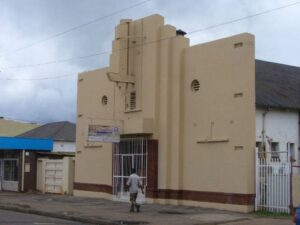 One of the happenings in the town was the showing of silent films in the cinema. For these Murie earned some extra money by playing the piano. This was how she and Allon met. Her sister Marjorie [Gardie] describes the scene. ’Muriel played the piano and someone would sit next to her and tell her if they were dead yet or dying and she would have to play the most mournful song. It was really funny we used to have many a laugh about that and then it would liven up with cheerful music again. Pictures were just black and white, if you ever saw one, and there was no sound, just captions. Murie earned extra money by playing the piano once a week or once a month in some funny hall. So when Allon arrived on the scene he proceeded to add to the music, and between them they kept the music going the whole evening.’
One of the happenings in the town was the showing of silent films in the cinema. For these Murie earned some extra money by playing the piano. This was how she and Allon met. Her sister Marjorie [Gardie] describes the scene. ’Muriel played the piano and someone would sit next to her and tell her if they were dead yet or dying and she would have to play the most mournful song. It was really funny we used to have many a laugh about that and then it would liven up with cheerful music again. Pictures were just black and white, if you ever saw one, and there was no sound, just captions. Murie earned extra money by playing the piano once a week or once a month in some funny hall. So when Allon arrived on the scene he proceeded to add to the music, and between them they kept the music going the whole evening.’
Was this ‘the hall’ Gardie described? Now in 2010 it is no longer a cinema.
Allon Leslie Povall’s background was different, but also not very settled. Born in Durban, an only child, his father died when he was 14. His mother seems to have been left reasonably comfortably off, and he attended and did well at Durban Boys High School. But for some unexplained reason, in 1913 in his matric year, he left. This may have been when he reportedly went to the Free State with the Natal Mounted Rifles to ‘deal with rebels’. He then had a short time on a sugar plantation, before joining the Royal Flying Corps. Training to be a pilot with this precursor of the RAF in Egypt, he landed in England after the 1914-18 war ended, in April 1919. There he had a wonderful exciting eight months being feted with visits to country houses, concerts, operas, Gilbert and Sullivan, and plays. He met his only known relatives, the Stuarts in Perth, and played cricket for Perthshire. [I have his small diary for this period]. Finally in December 1919 he was sent back to South Africa with a great taste for opera and Gilbert and Sullivan, and theatre programmes and sheet music for these, but not much to offer the world in the way of earning a living.
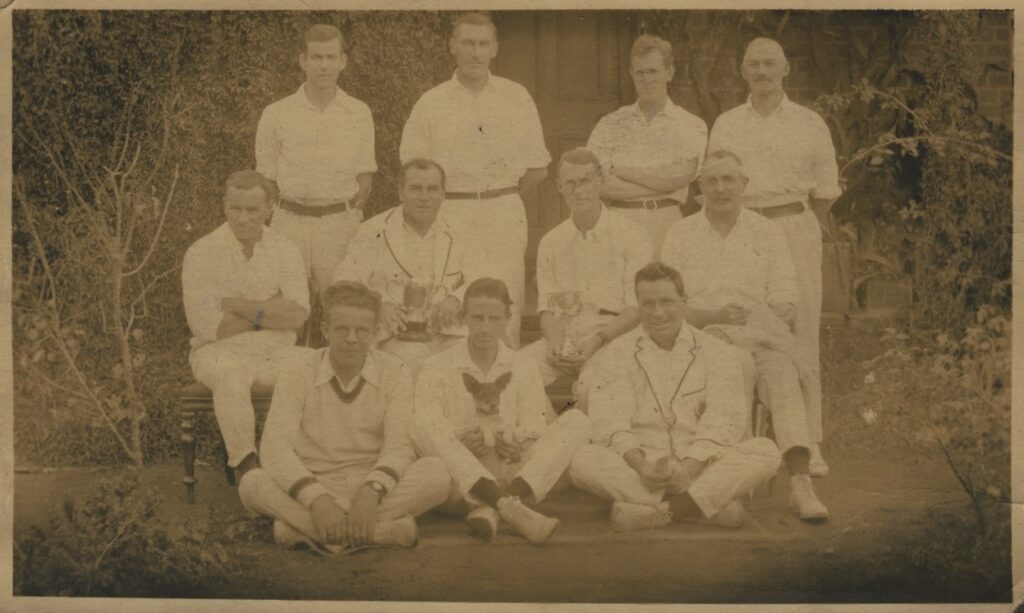
LYDENBURG CRICKET TEAM 1921
Back row:
S. du Toit, C. Mortimer, K. Burger, E. H. Mortimer
Middle row:
W. Goodman, B. J. McGee, A. L. Povall, Dwyer
Front row:
De Lange, C. Simmonds, Pat McGee
As Gardie says ‘The war had ended and these young men who had all gone off, they hadn’t matriculated, hadn’t trained for anything and no hope of training for anything. They were told they could have a farm. They had to show so much progress and pay off so much. So into this quiet little dorp of Lydenburg precipitated a very exciting young man who arrived with a motorbike with a sidecar and all he seemed to be loaded up with was a real old fashioned gramophone which needed winding up, and records. And he’d been allotted this farm outside Lydenburg . The excitement was intense, you can just imagine. This quiet village with this smashing young man who was a very good cricketer, who played beautiful music and so forth.’
So Murie was presumably bowled over and on 27th June 1922 married him, and went off to make her home in one [or possibly two?] huts at Mooiplaats on the Spekboom river.
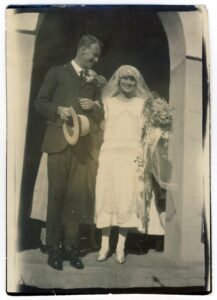
Allon Leslie Povall & Muriel Mortimer
27 June 1922 – Lydenburg
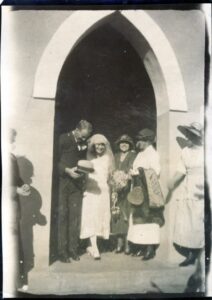
The Povall’s wedding day
27 June 1922
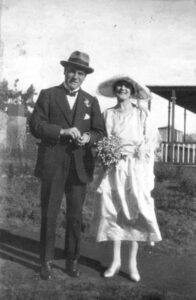
Barney McGee & Milly Mortimer
Best man & bridesmaid at ALP & MM’s wedding
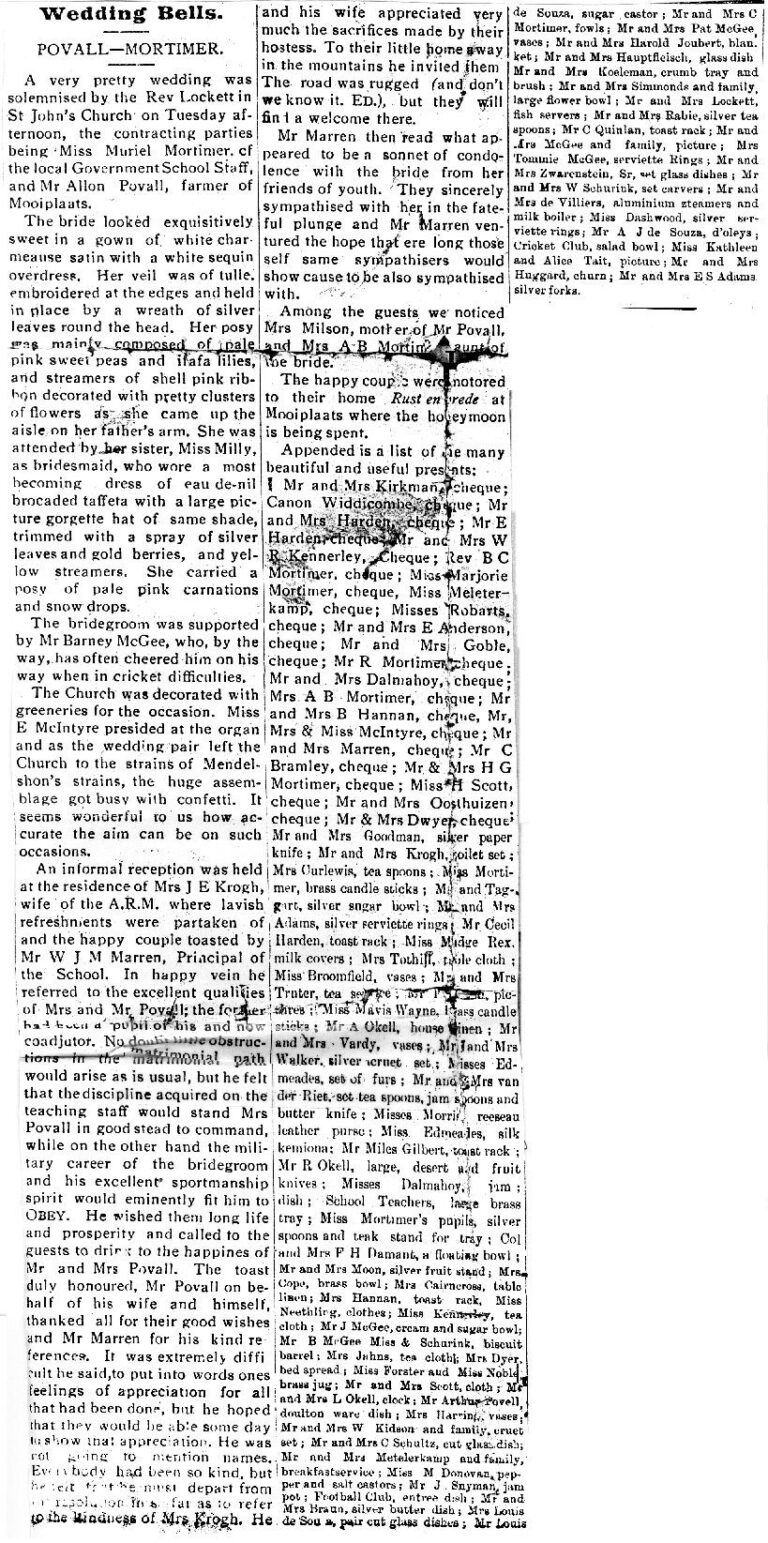
Their wedding must have been quite a social event in Lydenburg, being recorded in detail on the front page of the local paper. The list of all their presents bears analysis as a record of life and middle class aspirations in those days. For a couple going off to live in one [or two] huts some seem quite bizarre. The most practical seemed to be cheques, a churn, fowls and a blanket, also possibly ‘a set of furs’. The others, listed with their donors’ names included much silver and cut glass including 3 cruet sets and two sets of serviette rings. However these possessions were cherished, many survived and were remembered by all of us. Peggy recalls vases ‘2 tall brass ones, 2 Chinese ones, 2 little red the black decoration around’. I remember the brass candlesticks, and the horror of breaking the large cut glass precious pudding bowl used always for the family lemon pudding.
THE POVALL FAMILY’S LIFE ON MOOIPLAATS – 1922-1928
For the first two years, until Peggy their first child was born [exactly two years after their wedding] in June 1924, Muriel did a weekly commute to the farm, staying in Lydenburg to teach during the week. And this pattern of separations, of living apart, continued throughout their marriage. And also of Murie being often the main or only breadwinner. She taught almost all of her life, but as a married woman, never had security of tenure, and got no pension at all.
Her life had extraordinary parallels with much of her mother’s, neither of which fitted the stereotype of married life at the time. They both had ambitions of going to university thwarted by lack of money; they were both teachers; they both travelled around the country in order to teach and earn money, separated from some of their children; both their husbands failed to play the traditional male role of consistent breadwinner, although for different reasons [one the drinker, one the dreamer]; and so at times both mother and daughter were the sole or main breadwinner.
Allon, Mephies and helpers including Murie’s brother Ted had built one or possibly two huts before Murie arrived to live there in 1922.
For at least 18 months she did a weekly commute to Lydenburg to continue teaching. Exactly 2 years after their marriage Peggy was born in 1924, and 21 months later in March 1926 Peter arrived.
There were happy times at first.
Family visited including grandfather Mortimer, Murie’s father [who was presumably living in Lydenburg still], and great grandfather Mortimer, Murie’s grandfather. Peggy tells the story of problems about this visit. Rev Benjamin Clapham Mortimer wanted to baptise his first great grandchild Peggy. Allon, Murie’s husband refused point blank.
Photos show Murie’s siblings on the farm, and she relaxing in the river.
And Allons mother Ada Grace Milsom and her husband Mac moved there. There is a very happy picture of Ada Grace looking lovingly at her first grandchild.
For Peggy there were happy [and still vivid] childhood memories. Allon had built them a cart which the maid pulled them about on [see photo]. Peggy remembers the maid panicking and letting the cart go when they heard a distant noise of a car. She thinks the maid had probably never heard such a noise.
In 1926 two important things had happened. Their second child Peter was born in March. But Murie recalls another event as significant, or perhaps even more so because of how it shaped their lives. ‘Allon lost his right eye sight in 1926 from a blow at rugby. He went to an eye specialist in Johannesburg and was introduced to Christian Science. This transformed our lives. He lost interest in farming and we relied on Christian Science until he became very interested in British Israelite literature.’
There had been various problems with Allon’s attempts at farming. He cant have known much about farming, and Murie didn’t know anything – she had been a town girl. They had no money to pump water to the upper lands from the river [and seeing the current level of the river, one wonders how they even irrigated the lower field].
There was reportedly a drought. But surely the major factor was that Allon had lost interest. It had all got too hard, and his motivation to save the world became dominant. How this was to be achieved through Christian Science is unclear. But it is easier sometimes to think of higher things rather than face the unpleasantnesses of keeping a family housed, fed and educated, especially when you have a wife who is prepared and able to step in and provide for the mundane things of life.
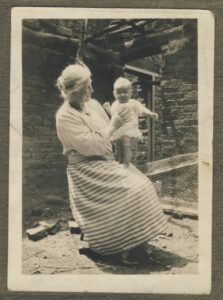
Peggy (4 Months) with her Grannie [Ada Grace Milsom [neeKidson] 1924
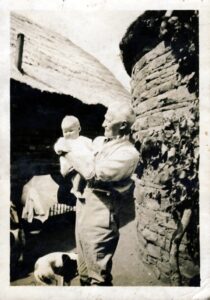
Peggy (4 Months) with her Mortimer Grandfather 1924
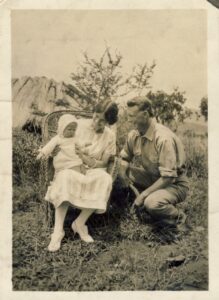
Peggy at 5 Months
‘The Family Complete’
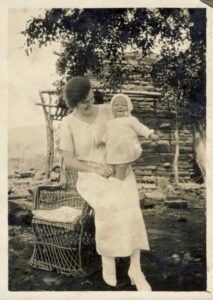
Peggy at 5 Months
With Auntie Milly
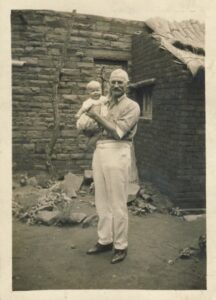
Peggy at 5 Months
With Grandfather Mortimer
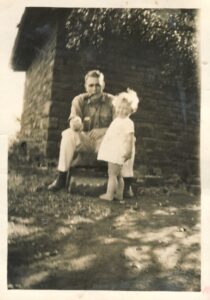
Peggy with Uncle Ted
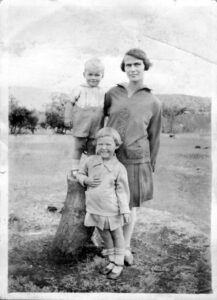
The last of Mooiplaats July 1928
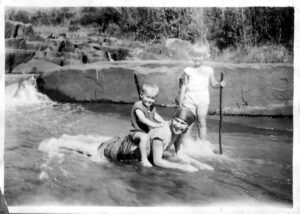
Picnic at Spekboom – May 1929
Whatever the original hopes the result was that in 1928 resourceful Murie returned to teaching in Lydenburg [ she said her old job was offered to her] whilst Granny Milsom probably cared for the children.
So in July 1928 , after Murie had been there 6 years, and Allon perhaps only about 8 years , they all left the farm and moved in to Lydenburg, for Murie to be the breadwinner by teaching, and for Allon to seek his fortune in Jhb.
But they went out with a bang, for a memorable holiday in Mozambique. Peggy remembers them going by train, and then camping on the beach with other people [Gwenda, Murie’s youngest sister, the Greenways, including Beulah, and Mr and Mrs Lotter.] They took their servant with them ‘and she got held up at the border or something.’ And on the train they had a theft of Murie’s jewellery, which Barbara and Peggy said consisted of a bracelet which had been her mother’s, and her engagement ring, and other rings.
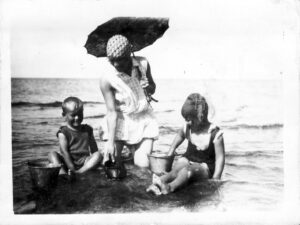
Murie, Peggy and Peter at Delagoa Bay
The farm Mooiplaats was an important part both of the start of two of her children’s lives, and because of its place in family history or mythology.
So in November 2010 Peggy, Peter Harrison and I went off to Lydenburg to find the farm.
Peggy’s interest was in once again visiting the place she had spent the first 4 years of her life and of which she had some memories. She had visited the farm some 30 years before with our mother, with Peggy driving down a precipitous track in her Volkswagen. They had been welcomed by the current farmers, the Smiths and had spent a night with them.
Margery’s interest was in seeing what had happened to the dry stone wall hut. This interest grew after her initial romantic concept that the family had lived in mud huts had been shown in photos to be false. There was indeed one mud hut which Peggy remembered, but there were also one or possibly two buildings with stone walls, and not just standard mortared stone walls but with beautiful dry stone walls. And these were said to have been built by a presumably untrained black man called Mephies. All this was really romantic. Did the buildings still exist after 90 years? The seven photos below suggested that they looked well enough built to do so.
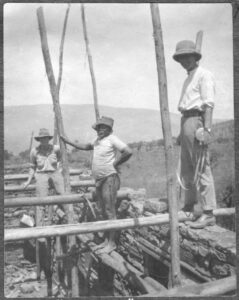
Mooiplaats 1921
House building: Ted, `Mephies´ & Allon
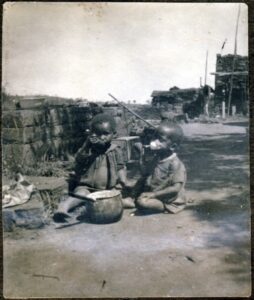
Mooiplaats (date unknown), but building in progress
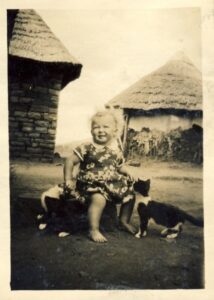
Mooiplaats 1926
Peggy – 18 months old
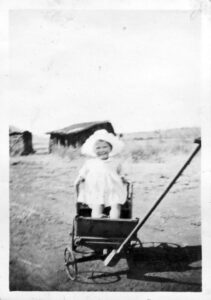
Peggy at 21 Months
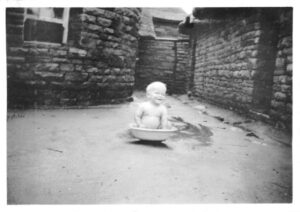
Mooiplaats 1926
Peter at 6 Months
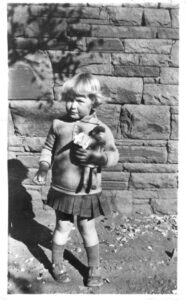
Peggy 3 Years old – 1927
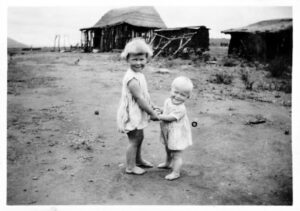
Mooiplaats Feb 1927
Peggy age 2½ – Peter age 11 Months
So off we set with these clues – the farm’s name was Mooiplaats, and Peggy remembered it being on the Spekboom River, possibly on the Ohrigstad road, with the Smith family farming it 30 or so years before. Not much to go on. Our quest in Lydenburg started with one surprise. Lydenburg no longer had a hotel, and its B&B’s were almost all full and we had to settle for some mediocre accommodation outside town. So it seemed to be having a new boom – based, we found out, on mining, as earlier.
Sherlock Holmes and two female Watsons [Peter, Peggy and Margery] started their quest in the Council Offices. We realised that in order to raise interest in an otherwise apathetic officialdom, we had to give them a good story, and this worked very well, culminating in being interviewed and photographed by the local paper, posing as their parents had, at the entrance to St John’s Church.
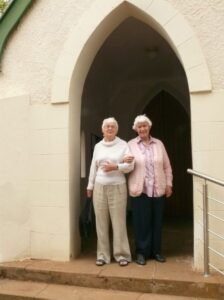
Peggy and Margery posing in Nov 2010 as their parents had on their wedding day in 1922
The story we told, in its various forms, was – Why have three old people travelled to Lydenburg all the way from KZN, Jhb and even London? Because we were searching for the childhood farm of the 86 year old. And on the farm we knew there had been beautifully constructed dry stone walls. And our parents had been married in the church, the wedding reported in the local paper in detail etc etc. With the help of this we got interest and leads, and even enthusiasm. But without the farm number no one could help. Returning to the council offices later after visiting the farm various women [black and white] greeted us with great interest. And then we could tell them that the number of Mooiplaats is 395. But they could not give us any information apart from the fact that it was registered in 1987 to Willem Petrus Smith [Pierre?].
So the initial information didn’t lead us very far. As we sat in the library looking at uninformative old books the trail seemed to have run dead. Without the farm number the council could not help, the knowledgeable policeman pointed us to some engineering works run by a Smith, but said the farm could not have been on the Spekboom etc. And then the male part of our trio had a brainwave – go to the Boere Coop. ‘Farmers know farmers’. And there we struck lucky. He was right. We got the phone number of Koos, the son of the current owner Pierre Smith. Doubtfully he gave us his father’s number, and Pierre agreed we could visit the farm the next day where his wife would be. But in subsequent phone calls with him there were questions and doubts – what car did we have? [a small Toyota], if it rained we would not be able to get there. But then he organised with his wife, Sunette, that we should wait at the upper farm where their daughter lived and she would come up and meet us in a four wheel drive.
Meanwhile our Coop informant encouraged us to go and visit Gareth McGee whose grandfather had been our parent’s best man. He now ran the large McGee Ford dealership – the oldest in the country. He was away, but we got his home phone number. In a phone call to him later he said that, unlike us, they were not much interested in family history. And he did not respond when I later sent him photos of his grandfather and the cricket team he had captained.
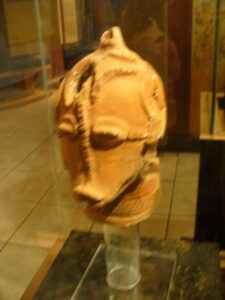 Not much at first at the museum either apart from the sight of Lydenburg’s well-kept secret – the astounding Lydenburg Heads [date 590 AD, originals in the CT museum]
Not much at first at the museum either apart from the sight of Lydenburg’s well-kept secret – the astounding Lydenburg Heads [date 590 AD, originals in the CT museum]
But then our male Sherlock once again sniffed out a possibility. He spotted a man in an office, who turned out to be the archivist, JP Celliers. And he produced a photograph of the staff and students of the Lydenburg School in the 1920s, and there was Muriel.
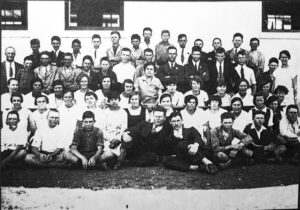
Dressed in a white straight dress, fashionable at that time, she could have been pregnant, which would have dated the photo as 1923.
Left: One of the Lydenburg Heads and on the Right: Staff and pupils of Lydenburg School – some time in the 1920s – possibly 1923. Murie on the right standing.
So next morning off to find the farm.
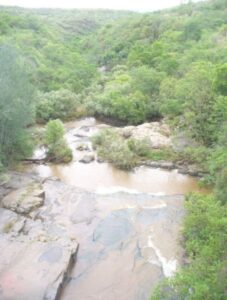
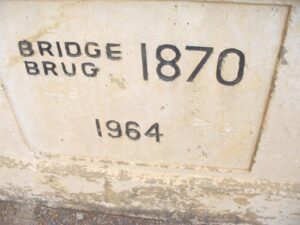
Spekboom river and the old bridge
Pierre’s instructions – turn left off the tarred Ohrigstad road after 16km onto a gravel one, and then a track, crossing a mining road. A green gate [which we didn’t find] would say Pierre Smith. But finally we got to a house. And this was the upper farm, the place which Peggy remembered. And there were the dry stone walls, but not quite as Peggy remembered. The original mud hut, and kitchen hut long disappeared, as also the tree and original dry stone wall rondavel which she remembered them living in. But incorporated into a larger house were the walls of the building she remembered being built and of which we have photos – beautiful dark rusty red, solid, perfectly built, in perfect condition, and still cherished. The house had been extended from the original which was to have been the Povall’s new home, but where they never lived because even before the roof was built the family left the farm forever in July 1928.
THE 2010 PHOTOS OF THE HOUSE
Mephies’ dry stone walling now incorporated into the current house
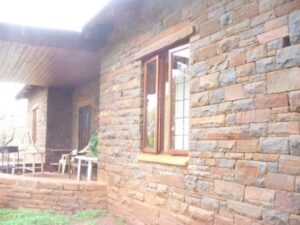

Sunette, Pierre’s wife, then drove us down to the Smith’s current home near the river. We had 1926 photos of ‘the move of the family down to the river lands’.
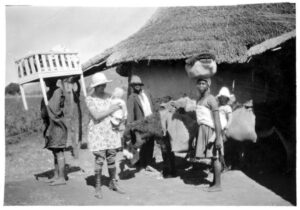
Enter Peter 4 Months
The Great Trek from – River House
July 1926
But this was no easy short stroll. How Peggy ever negotiated the track in her Volkswagen all those years ago is a mystery. In the 4×4 we bumped down, down, down through beautiful bushveld, stopping to admire flowering barberton daisies [gerbera] [which we were told should really be called Lydenburg daisies as that was where they originated from]. We were also shown the krantz with the [now defunct] leopard’s lair. And also an abandoned rusting old tractor which Pierre wants left for sentimental reasons [while Sunette senses possible commercial value for scrap metal].
At the bottom, nearly at river level, we reached the Smith’s house and various chalets and other buildings let to hunters because the farm is now a game farm.
And there, below us, was the flat field [but still well above river level] which we were told our parents had cultivated. On its borders, a few remaining mango trees grew, very likely planted by Allon as he had come from Natal.
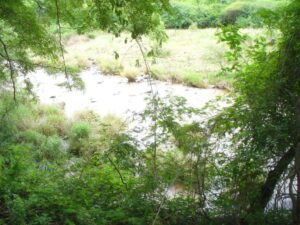
The Spekboom River in 2010 from the bottom field
Peggy could not remember anything more about how things had looked down there. But simply that the family had moved down to the river lands in the winter to avoid the worst cold.
She also knew that her grandmother [Allon’s mother] Ada Grace Milsom, and her second husband ‘Mac’ had lived down there when they joined Allon and Murie on the farm. According to Murie, ‘Mac’ had also been granted a farm as a returning soldier. It was in Standerton and he had failed as a farmer. So two families presumably living on the breadline were stuck together [probably unhappily] on the farm. Whether the idea was that they would farm together we do not know. We also couldn’t get any idea of where about Granny and Mac had lived, or in what sort of building, a building Peggy called ‘the River House’.
OBSERVATIONS AND QUESTIONS AFTER OUR 2010 VISIT
The visit to the farm was an emotional one for all of us. We all three knew the stories, and Peggy had real memories. Seeing the actual setting, and vestiges of the Povall family’s actual presence in the walls and the trees, changed all of our perspectives to some extent. And raised many questions also.
Mooiplaats [or Mooiplaas as it is now known] is indeed a beautiful, but even today very isolated spot.
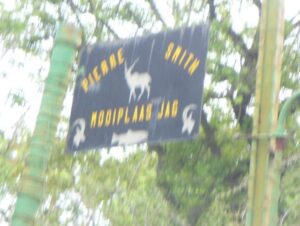
Entrance to Mooiplaas 2010

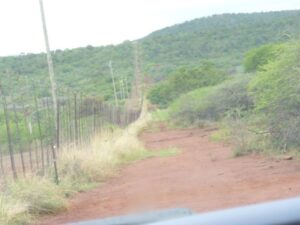
A boundary fence
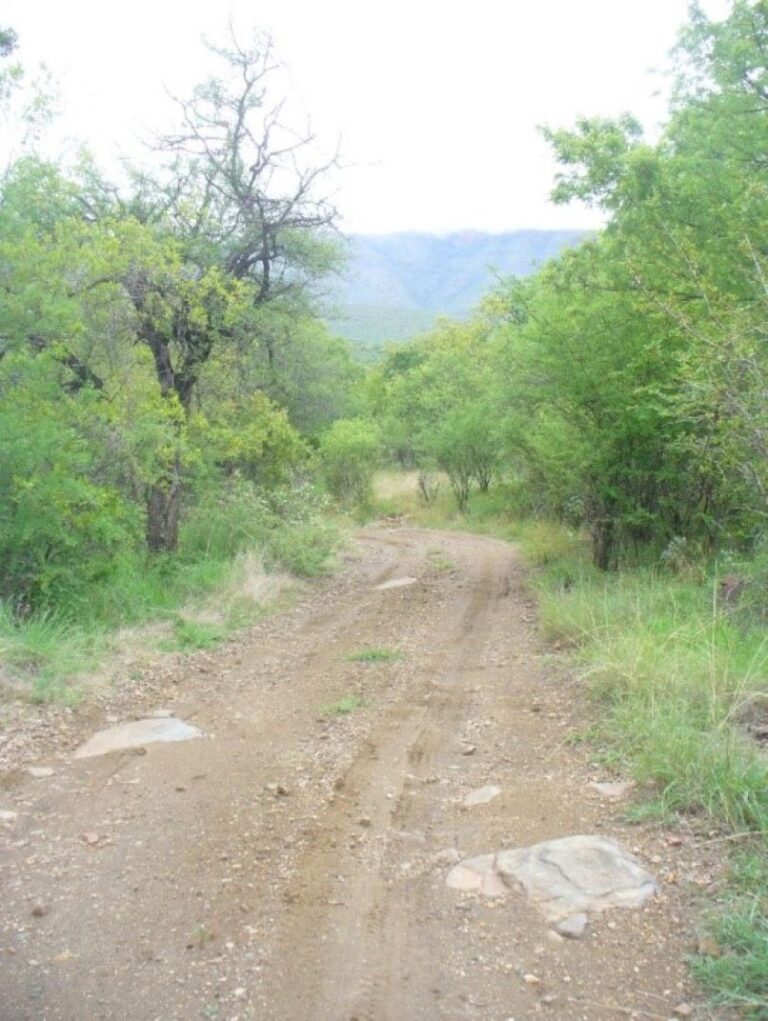
The track down
Meeting the Smiths and hearing something of their story gave some perspective on that of our parents. We felt that the Smiths may well be struggling to make a living. Their story was interesting because they too were there because of yet another romantic, Pierre’s father. He had hunted there, and longed to live there. Eventually Potgieter who owned it agreed to sell at a much lower price and the young Smiths moved in. This we got from Pierre’s mother whose dementia limited her conversation to a few clear memories of those early days.
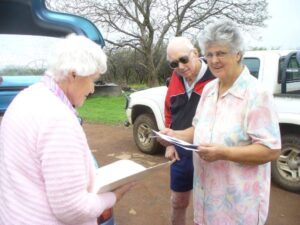
Peggy, Peter and Sunette Smith
And nowadays Sunette Smith [who generously gave us not only a tour, but lunch including their own warthog salami] seems to run the hunting activities whilst her husband Pierre [an only son who had wanted to be an engineer not a farmer] works with their son in his mechanical /metal repair business in Lydenburg. And they couldnt sell the farm even if they wanted to because some years ago an as yet unresolved land claim was made on the farm, effectively deterring any possible buyer. They have a butchery, chalets, and communal buildings for groups. They have tried various crops and raising of animals over the years, but in the end the most obvious way to make a living apparently was to leave the land and its flora and fauna as it was, and get some income from people shooting some of the game, but only on foot.
The roads have changed since our parents’ days, but even today the track even to the upper farm is rough. Because it is relatively flat to the upper farm it probably made sense for Allon to try and start farming there. And photos show that he tried.
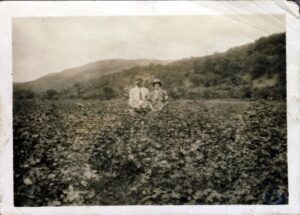
Mooiplaats: Jim Yates & Milly in a Cotton Field
But the winters can be severe, and rain problematic. So maybe this was when he tried further down near the river. But as we learned, the trek down to the river was not a simple steep 15 minute walk, but a long and difficult descent. But they chose to keep their home at the top of the kopje. Was this because it was less remote, rather than move near the perhaps more easily farmed lower lands?
One can’t help thinking about the extraordinary story that Sunette told us, which was that when Murie was still teaching and the motor bike had broken down, she walked into Lydenburg along the river in order to get back to school on time. This was something Murie must have told them when she visited. We could not even begin to visualise what this entailed. The roads may have been different then but the terrain is rough and wild, and even if she could join a road some way along there would not have been much in the way of passing traffic from which she could get a lift, on perhaps a Sunday afternoon. And it is possible that she was pregnant with Peggy at the time!
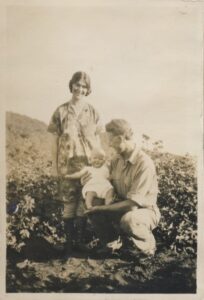
After our visit I felt a little more sympathy for my father. After the war what was he to do when he had little experience of earning a steady living? The thought of having his own farm could have sounded attractive. I could understand too a little about his decision, after a few years, to retreat into the higher purpose of saving the world, rather than the mundane one of feeding his family. The latter was very hard without equipment, and funds. The land is beautiful, but one cant help feeling that it is best left to itself and its deer and other wildlife.
The big question haunting me is who was on that land before Allon?. Who thought that land belonged to them, that it was their home, and who perhaps still thinks so? Who has lodged the land claim? Where did Allon get his black helpers from? We have pictures of them. And there is the famous builder Mephies. Were these people living on the land? Was Allon given/loaned/leased these people’s land by the white government? How did they feel about this? And what happened to them after the family moved out? Presumably he had managed to pay them something whilst they worked for the family.
With Peggy in a cotton field 1924
I tried some searching on the internet for information about land claims in the Lydenburg area but found nothing relevant. To prove a land claim some sort of hard evidence of ownership is needed. Who has made the land claim? I wondered whether our photos showing Allon’s workers, and the work of Mephiesfi, could be used as any sort of evidence if it was their family who were making the claim. And another somewhat bizarre thought was that perhaps the Smiths were worried that our interest in the land might have anything to do with us thinking we had some ownership rights on it. Were we more possible land claimants? This seems far fetched, but so many unanswered questions. Who was on the land before Allon was given it? What were the terms in which it came into his hands? A lease? At what stage did Potgieter buy it? Was he also a dreamer and hoped to make a go of it as a viable farm? It seemed that in the end he was glad to get rid of it to the Smiths at a much reduced price.
This question of governments in South Africa ‘giving’ lands to white people is a recurring one in my family’s history. Simon van der Stel ‘gave’ our Huguenot ancestors the du Preezs land at what became Paarl. The British government ‘gave’ land north of Durban to our Povall forebears. And both our father and his stepfather ‘Mac’ were ‘given’ land as returning soldiers. All of them knew little or nothing about farming. But the first two did make a go of it, against the odds, whilst the latter two did not. And in all the cases there were people already on the land, possibly/probably not cultivating it much, but regarding it as home.
MP Mar 2012
Descriptions of movements and life during that period of 1928 to 1930 are confused. Peggy made it sound less peripatetic than Murie’s recollections, so presumably Murie and others managed to create some sort of feelings of stability for the two children.
In Lydenburg after leaving the farm Murie says they took a little cottage and she engaged a white girl to look after Peggy and Peter. So it seems Allon’s mother Ada Grace and Mac were no longer with them. Perhaps Allon was there hoping to find employment in Lydenburg?
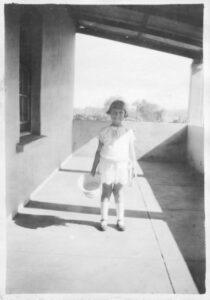
Lydenburg August 1929
At 44 Long St.
Peggy all ready for a party. Peggy remembers the party dress. It was white with mauve ‘sort of embroidery’ on the edges.
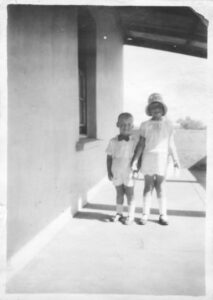
Lydenburg August 1929
At 44 Long St.
These photos suggest that a year after leaving the farm in 1928, both Peggy and Peter were in Lydenburg. And was Allon also? Was the job Murie had in Lydenburg only temporary? Why otherwise did she pack up again and go to Ermelo, having been offered a job there. This was not the time Allon went off to Jhb taking Peter with him because Peggy was sure that it was not in Ermelo that she was taken [under age] to school with her mother.
En route to Ermelo Murie went via Jhb, staying with friends of Allons ‘who engaged our white girl as they had three little boys’. In Ermelo she says they stayed in a boarding house ‘after putting furniture in Mc Gees Sale rooms’. McGees was presumably in Lydenburg – the business run by the family of Barney, their best man? The job in Ermelo was ‘a special class for backward children, not approved of by parents’. If Murie no longer had help from ‘the white girl’ she must have found child care help from elsewhere. When the job ended she and Peggy returned to Lydenburg where her old job was again offered to her, and Peggy attended school with her.
There was another time that Murie had left Lydenburg for another destination. Perhaps this was earlier? She had gone to stay [to teach?]with Esme, her cousin, probably taking the children. This may have been when Esme and Herold were in Barberton, and perhaps there was a teaching job there. Elizabeth, their daughter remembered the occasion, but because her father was moved around so much by the bank, was not sure where they were living at the time. It seems possible that this stay was before the family all left the farm permanently in 1928. As Allon had given up farming after 1926, money must have been very short. And Murie later wrote that she only remembered not teaching for two periods in her life – in 1924-26 when Peggy and Peter were born, and ‘for a period in WWII’.
And as a married woman she never got a pension! When WWII broke out she, as a married woman was retrenched. But apart from these gaps she taught until December 1962 when she was 65. [After this she worked part time for the Inland Revenue as ‘a Morning Glory’. They were put on reconciling impossible long standing tax queries. There were huge outstanding files. ‘We always hunted for them, sometimes finding that the shorthand typist was sitting on them.’ She felt she was valued and loved it, and was very upset when ‘the Morning Glories’ were got rid of.]
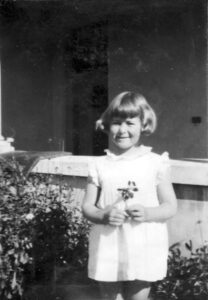
Lydenburg – Peggy April 1930
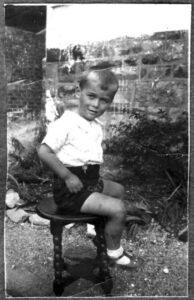
Johannesburg – Peter April 1930
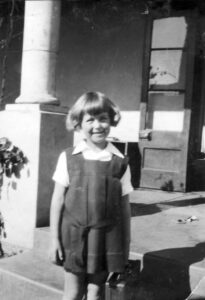
Lydenburg – Peggy April 1930
Back in Lydenburg Murie and Peggy boarded with Babs and Steve Lund, a vet, whilst Allon took Peter to Jhb.
It seems possible that Allon’s mother and Mac too were in Jhb and so could perhaps have looked after Peter.
Probably in 1930 Murie took the decision to move to Jhb to join Allon and Peter. Perhaps Allon had a job. And it seems that this was by April 1930 because this was when Barbara must have been conceived.
When she and Peggy moved to Jhb Murie says they put up initially at Daltons, found a house and recovered some furniture from McGees. Peggy went to school at Fairview Junior and Murie started teaching at a coloured school. Peggy remembers other temporary homes during this time – boarding with a family named Thora?, also initially living at The Summit boarding house a place in Hillbrow joining Allon and Peter. They had a Christmas there with snowman and crackers.
It is unclear at this stage what employment Allon had and when. Murie says Dollie Humphries found him a job. Was this the job he then had for years, ‘running the Star Billposting Company at £3.10s a week’? [later raised to £5 which Murie says made them feel quite rich]. ‘Allon found a house in Kimberley Road near his billposting yard. After a while we moved nearer to Peggy’s school and later to Kensington.’ Peggy’s memory was that they lived in Jacoba Street before Kimberley road, Jacoba being near her school, and where they were living when Barbara was born in January 1931. She remembered Murie and the new baby being collected at the Queen Vic hospital by Murie’s great friend Miss Brown, someone who helped Murie and the family for many years. [She was one of the loyal friends Murie had all her life, who helped both emotionally and practically. Helen Scott is another I remember well, and Granny Truter. Others like Dorothy Norton, Bryna Davis and Frances Metelerkamp were more shadowy figures to me, perhaps because they lived further away?]
At some stage they were affluent enough to have staff. The black couple were Steven and Minnie. He worked for Allon, Minnie for the rest of the family. Peggy understood that the couple were upset because they had no children, and had to save for their old age.
For years Peggy still had a baby pillow made by Mother for Barbara. A dramatic loss was when Allon’s week’s wage which he had left in trousers near a window was stolen. The trousers and the money were hitched through the window.
Murie’s written description of this period misses out the most important emotional event of this period, so it is perhaps understandable why her and Peggy’s memories of the period differ. Murie writes ‘ Dollie Humphries found Allon a job but I went to Krugersdorp to Ted for about four months. Marjorie and Ted assisted me financially for 6 months’. So it seems that although Allon had a job, she and the children did not live with him. This is presumably because she had left him. Years later[in 1957] when she had a breakdown when he was returning from England after years away, a psychiatrist got her to record what the worst moment in her life had been. She wrote that it was that whilst she was pregnant with Barbara, Allon had told her that he was in love with someone else.
On a visit to Olga, Ted’s widow in the 1980s or 90s Olga, looking fondly at Barbara said ‘I first saw you when you were three weeks old’. A likely scenario seems therefore to be that Murie perhaps stayed with Allon until Barbara’s birth in January 1931, when Ted found her a house in Krugersdorp, where she and the three children lived for long enough for Peggy aged 6 to remember going to school there.
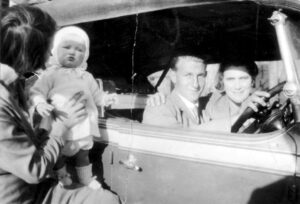
Enter Barbara – here aged 6 months
with Auntie Gwenda & Uncle Heinie on their wedding day [16 July 1931]
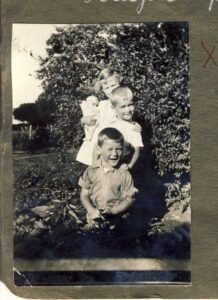
Krugersdorp Feb 1931-Peggy, Peter, David Metelerkamp
I have in mind that this love of Allon’s was Elsie Langton, the wife of his boss. But I cannot now remember how I deduced this, and it may be quite incorrect. Barbara remembered the family being out one day, and the possibility of a visit to the Langtons being mooted, and Murie getting in a state. Peggy also recalls a visit to them when Allon left his camera on the tram, and never got it back, but without her noting any reaction from Murie.
[An interesting observation about the Langton family, and of life in Jhb at that time is that both Peggy and Peter recalled that the family’s name had been Lazarus, changed according to Peggy to Langton in order that their younger child could go to St Johns school. Peggy says this was in spite of the fact that they had converted from Judaism earlier. I wonder if this son was Gerald who I think became a very senior manager in Anglo American]
But to return to the Povall family story, in spite of the fact that Murie had been the main or only breadwinner for most of the 11 years of her marriage, she went back to Allon after his affair, or admission of a hoped for affair. [And nearly four years later in November 1934, I their fourth child was born].
So Allon had a job, providing some economic stability. But emotionally things must have been difficult. Peggy recounts a couple of incidents concerning Barbara as a little child. In Kimberley Street, Barbara got onto a veranda with a drop down below, whilst Murie ‘had a fit’. And on another occasion Barbara got burned, falling or backing into something hot on the stove. Peggy recalled another upsetting episode when her mother found that Peggy had stolen a child’s brush and comb set from a friend.
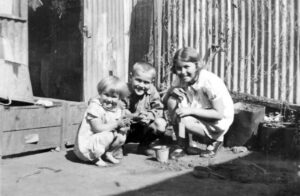
The Povall trio in their Troyeville back-yard
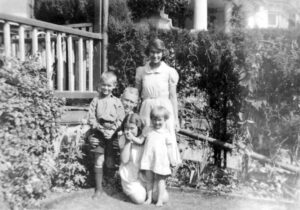
The Povall family Sep. ’33 in their Troyeville garden
Barbara remembered her early Johannesburg days. This was in the house in Hillier Street, Fairview which according to her was still there in 2001. ‘It’s semidetached and there was one room at the front, and two bedrooms, and a kitchen at the back.’ They fitted in to the two bedrooms – Peggy and Granny together, Peter in the lounge or kitchen, and she Barbara perhaps with her parents.
Peggy too clearly remembers their living arrangements, but perhaps in an earlier [or later] house. Her memories are of she and Barbara in a double bed and granny in a single. Peter was with their parents in the front room which was their bedroom.
Not surprisingly when I was born at the end of 1934 they decided that they had to move. But judging from photos of the time this was not until later in 1936. Then No 34 Good Hope Street became our home for a few years.
Barbara remembered me being brought home from wherever I was born. Once again Miss Brown, that invaluable friend with a car helped. She was also one of Murie’s friends who gave the family presents. I have a vague memory of a quite severe short haired woman. [Another life long family friend from Lydenburg was Grannie Truter who I remember well. Barbara thought she had more or less adopted the Mortimer girls after their mother died – showing them how to cook amongst other things. And Barbara felt she was like a grandmother to her. I remember her many years later showing me how to make apricot jam.]
Meanwhile Allon’s mother Ada Grace and her husband Mac were also living a very insecure existence. According to Murie Mac had found a job, the couple had taken a room [presumably in Jhb?], but Mac died so Ada Grace returned to live with her son and family after staying with her sister in Nigel. This may possibly be in 1935 because Murie records she and Allon going on holiday to Bonza Bay and Fort Cox to Dorothy Norton, [possibly taking baby Margery with them?], whilst AG presumably looked after the rest of the family.
‘Mac’ was always a mystery to Ada Grace’s grandchildren. He was never talked about. Who he was, where and when they met and married, and why Ada Grace who had apparently been left quite well off ended up with only a small old age state pension remains a mystery. It seems likely that he was younger than her if he was in the armed forces during WWI. [She was aged 51 in 1920]. We perhaps naturally made up possible stories about him being a gambler, conman, drinker or all of these. It was certainly obvious to us that Granny had ‘come down in the world’ and Barbara says she was a snob. It seems from Murie’s handwritten memoirs that Mac was alive in the 1930s, and Peggy vaguely remembers him. What I remember of him, bizarrely because none of my siblings do, are his slippers. I can still visualise them in the bedroom I shared with Granny – grey feltish finish with a sort of tartanish pattern on them. If this is a childhood fantasy it is a strange one. I was not a very imaginative child. But there seems no possible reason why, perhaps 10 years or more after his death his slippers should have been on display.
[IT WOULD PRESUMABLY BE POSSIBLE TO LOOK AT DEATH RECORDS IN THE 1930s, starting around 1934/5 in Jhb TO PERHAPS GET A LITTLE MORE INFORMATION ON THIS MAN, AND THE BACKGROUND TO HIS RELATIONSHIP WITH OUR GRANDMOTHER MILSOM . Also possibly info on the allocation of farms in or near Standerton to returning ex servicemen]
Peggy, in 2008 talked of some of the furniture she remembered them owning. In Hillyer Street there were 2 tables. A deal one had an oval top put on it to make it bigger. Peggy says this was the dining room table I remember.
Allon was handy with making things so presumably did this improvement. In Good Hope Street Peggy recalled the wardrobe and dressing table he built. And later a bookcase for her, which, she said Lynette now has.
Allon’s practical skills came to the fore when he built ‘The Caravan’.

Our caravan
It was built from plywood on to a 1926 Hudson car chassis. Peggy says that Allon started the building when they were living in Hillier Street, keeping the caravan in the grounds of a house in Norse Street. He had to build up the garage roof at no 34 in order for the caravan to be kept there.
In the caravan the family could escape from Johannesburg, even always taking their cat Bunchie with them. These trips included the legendary ‘Protea Valley’ not far from Jhb. [It is no doubt now an integral part of the Jhb suburbs – Barbara thinks it is now called Fairlands. Peter Harrison suggested Weltevreden Park]. Barbara recalled the caravan’s structure in detail. ‘The front seat was still in place. And the back seat was put just behind it, facing into the living area. And that was where you [Margie] slept. Peggy Peter and I slept in the sort of canvas stretcher things, which came out over the engine. They made 3 bunks – Peggy in the middle, Peter and I on each side. It was curved and the double bed was a rimpie bench to sit on during the day, and the table which was used to support the centre of the bed at night. You’d bring up the rimpie and bring it across.’ I don’t think I remember any trips in it. I was told [vividly] about Murie’s attempts to drive, swerving all over the road. And about Bunchie escaping [but being found] at some stage, but although this is vivid, it is probably not my personal memory.
My memories of the caravan was when it was holed up in the garage at No 34 Good Hope Street. When we moved to No 24 [where there was no garage] when I was 6 or 7 i.e in 1941 or 2, Barbara said it was sold.
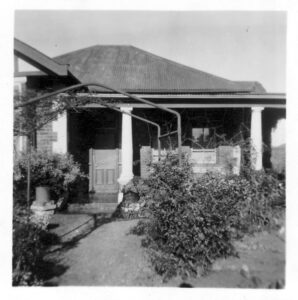
Our house
No.24 Good Hope St, Kensington
Murie had a remarkable ability ‘to get on with life’. Whatever her feelings about Allon’s behaviour, and his mother always living with them, she created a home full of life. At No 34 Good Hope Street there were musical evenings and dancing with the neighbours. I remember Spanky, the spaniel from across the road who howled whenever music started. Also sing songs round the piano from Francis and Days song books, also later at No 24. Peggy recalled other neighbours from those early days, the Ackroyd twins, Trixie and her brother. And Anne Setzer, who very exotically had travelled to china. During the war our house at no 24 became a home for many members of the armed forces. Some stayed the night, others visited when in Jhb.
Both Murie and Allon continued to play the piano. My memories of their piano playing are, rather bizarrely each playing the same Chopin Polonaise. The memory is particularly strong of Murie hammering out the emotional music. Now I wonder if it was perhaps a good way of her dealing with frustration and anger.
Murie was introduced to a wider range of music by Allon. ‘..he inspired me and instructed me in operatic music. When we moved to Jhb we used to queue up for cheap seats at the excellent operas brought out here before SA was boycotted. I remember standing in an opera queue holding a baby and handing her over to Allon to take home whilst I attended the opera.’
Her and Allon’s lives continued to consist of many absences from each other. Adding up how much time they actually lived together there seem to have been almost more absences than time together. But she always stuck by him.
Much much more can be written about their married life. It lasted 40 years. I have various people’s reminiscences, and my own memories. But even after all this time I find it upsetting to recall, and to read Murie’s notes about this period. Whilst I can now feel some compassion for Allon, the prophet whose words were spurned by the world, I also cannot bear to read his writings. There were many many books written by him [all unpublished]. We [his children and grandchildren] destroyed most but I kept one. Why? I find his white supremacist, anti-Semitic views intolerable. I no longer hate him as I did for a long time. But I still get emotional as I write this. So 1936 to 1960s in Murie and Allons life will not be written up for the moment. Others, more detached, may like to take the notes I leave and work through them because it is an interesting story, as was all their life.
So for now all I will say that is in summary Allon left home once again when he joined up in WWII [when he must have been above the compulsory age for enlisting]. And when he returned in 1946 he once again went off to live for a while [to a boarding house in Tongaat] having once again fallen in love with another woman. He refused to let them buy a house although Murie had saved a deposit for this during the war. How she must have longed for some stability. Then at the end of 1950 he withdrew his pension and took off for the UK ‘to save the world’. So Murie, Barbara and Margery [and our beloved dog Bimbo] moved in to a boarding house, and Ada Grace, Allon’s mother into an old age home.
Then later, after years of trying to pressure Murie to join him in the UK [what on earth would they have lived on? – at one stage he washed dishes to pay for his keep in his London boarding house on Seven Sisters Road!. At another he became the warden of a [still] remote youth hostel in Wales].
He returned to South Africa at the end of 1957, presumably penniless, clutching only a roll of [no doubt good quality Yorkshire] brown woollen suiting as presents for the family. Once again he pressured Murie to leave the life she had for the first time built up for herself in Jhb, and go with him to live in Natal in a guest house. She resisted the pressure once again, and in 1961 he died.
For this self centred man with a mission to save the world, a mission few [if any] were interested in, it must have been a sad end. And Murie was left to live a quite amazingly fulfilled intellectual and social life for many years, but one in which she was left, for years after he died, with no one to talk to about this man who she had shaped her life round. But a man who none of her friends and family had time for, regarding her as something of a martyr. Martyr she wasn’t. She had choices, and those she made never allowed her to reject him entirely. She presumably loved him in spite of everything, and thought he was remarkable. He certainly was unique.
MP Mar 2012
[not written]
St. Helena
10 June 1695
In the name of God Amen
This tenth day of June according to the Computation of the Church of England 1695 I John KNIPE of the Island of St Helena free planter being sick and weak of body but of good and perfect mind and memory praised by God, do make, constitute, appoint this my last will and testament in manner and for me following that is to say.
First and foremost I commit my soul into the hands of the Almighty God hoping and assuredly believing to receive free pardon and remission of all my sins past and for my body I commit to the ground from whence it came to be buried at the discretion of my Executors hereafter named and for those worldly possessions it has pleased God far above my deserts to give me I give and dispose as followeth vizt.
Imprimis I give and bequeath unto my well beloved mother Anne KNIPE (now in England) The sum of twenty pounds if she comes to this Island to receive it Together with the provision growing in a plantation adjoining to the land of Praise PLEDGER and the use of one black called George during her natural life or the time she dwells on this Island and no longer after her death or her departure from this Island (if she doth come as aforesaid) I give and bequeath the said slave to all my children.
Item I give unto my well beloved wife Mary KNIPE the third part of all and singular the rest of my Estate let the same consist in any specie whatsoever.
Item I give unto my beloved Mother Two head Cattle vizt. Two Heiffers.
Will and pleasure is that my Said beloved wife Mary KNIPE have and keep in possession what is given and bequeathed to my said children John and Anne Knipe they come of age or married.
Item I appoint and ordain my trusty and well beloved friends Praise PLEDGER and Richard LEACH to be my whole and Sole Executors of this my last will and Testament revoking all other will or wills here before by me made either by word or deed but thus to be taken for my last will and Testament In witness whereof I have hereunto sett myself and seale this 10th day of June 1695.
Sealed and dd in
The presence of us
Ripin WILS
Ones QVEENYO (his mark) John Knipe O (his mark)
John VERNON
St. Helena
3rd March 1817
The last will and testament of me Samuel Knipe Senior of the Island aforesaid Planter is as follows –
First – I recommend my soul to … Christ my redeemer and my body to be decently buried at the direction of my Executors hereafter named, as to my worldly effects wherewith it hath pleased God to bless me, I dispose of them as hereafter is named…
I bequeath unto my beloved Wife Emelia the sum of Two hundred pounds as a legacy to will or dispose of as she may think proper.
As to the whole of the remainder of my estate, I give and bequeath the same unto my Executors hereafter named, In trust nevertheless and to and for the several uses, …, intents and purposed hereinafter particularly mentioned.
First – I devise that my Wife Emelia may reside and continue in my dwelling house at Horse Pastures, for and during her life or widowhood and that under the same limitation and restriction, she be suffered to remain and continue in the full and quiet possession of my estate both real and personal (except my monies and securities for monies) but to and for this express purpose namely that she preserve the same to the best advantage and benefit of my children, and after deducting the maintenance of my family and other just expenses, I will and direct her to remit the surplus of the produce of my estates (if any) into the hands of my executors to be by them put and placed out at Interest on good and lawful (___) with my other monies for the benefit of the legacies hereinafter mentioned or otherwise applied to benefit my estate, as my executors may discreetly think fit – Now my will and intention is that they my executors or the survivor of them upon and immediately after my Wife’s demise or marriage, do cause an Inventory to be taken of all my real and personal estate and an appraisement thereof to be made and of the sum total together with my monies and securities for monies to cause an equal division to be made amongst the whole of my children, share and share alike, (except my Daughters Elisabeth and Martha) and except and apart from these legacies by me hereafter particularly specified not to be valued.
Next – Between my Sons John and Richard, and my Daughters Anne, Emelia, Caroline, Mary and Charlotte and my desire is that these divisions be arranged in the following manner and subject to those exceptions and restrictions hereinafter particularly mentioned and described requesting that if any of those allotments succeeds the legatees share or dividend the overplus is to be paid to my executors to make good any deficiency in the other child or children’s share, but that neither of my Sons or Daughters be distressed thereto, unless they are able to pay and obstinately refuse.
I give and bequeath unto my son William’s Children at valuation, a dwelling house and premised situate and being in James Valley, joining immediately to Major William Seale’s and which I purchased from Major William Seale but as part of that house encroached in front on my other house adjoining/hereinafter bequeathed to my Daughter Anne, I desire that an equal partition be made, so that the houses be of equal breadth, and as this house and premises have been let and leased for seven years from the 28th day of May 1807 at the clear yearly rent of eighty five pounds, which rent my Son William and his executors has received, I deduct the whole amount thereof at the time of my demise to be added to the valuation of said house and premises, and should the representative of my Son decline to accept the same, with the addition of the rent as aforesaid, then the house and premises are to be sold at auction and the produce of such sale divided equally amongst the whole of my Children (except as before excepted) in which case the sum he my son William, or his executors may have received as rent for said House and premises is to be deducted from his share of dividend of my Estate.
I give unto my Daughter Caroline the Wife of Mr. Charles Blake, twenty three acres of Free land commonly known by the name of Long’s wherein is a small dwelling house, erected in which I desire Billy Moore to live during his life, he being a Slave and belonging to my estates. Having already advanced unto my Son Samuel the sum of Eight Hundred pounds I give unto his Daughter Henrietta the sum of Fifty pounds, to his other Daughter Anna Maria, the sum of Fifty pounds, to his Son Samuel Hogan Knipe the sum of Fifty pounds, which sums are to be put and placed out at interest on goods and lawful security for their benefit until they attain the age of twenty one years or day of marriage when they are to paid the whole of the principal and interest, and in case of the death of either of them the sum due to such Child or Children to be divided equally amongst the survivors.
I bequeath unto my Daughter Emelia at the valuation of Six hundred pounds my dwelling house and premises in James’ Valley, situated between the shop late Mr. Solomon’s and the house late Capt. Hamilton’s which I formerly purchased from Mr. William Doveton and as I have already advanced on my said Daughter’s account to her Husband Mr. John Legg Senior the sum of Four hundred pounds, I desire the sum with interest thereon as (__ ____) may be deducted from her share of my estate – I also give unto her at valuation a man Slave named Francisco and a Slave Boy named Charles.
I give and bequeath unto my Daughter Anne at valuation my house and premises in James’ Valley situated between the admiral’s home and the house bequeathed to my Son William’s children, but having advanced to Capt. Broadway the sum of One hundred and Forty six pounds, this sum is to be deducted out of my Daughter Anne’s share – I give at valuation a Slave Man named Ben and a Slave Girl named Priscilla as part of her dividend.
I give unto my Son John Twenty one acres and half of Free land called Lemon Valley head and Eighteen acres of Lease land also at Lemon Valley Head known by the name of (Harper’s) and (___ ___) to be valued to him. I give unto my son John three Men Slaves named Frank, Sam, and Billy, also a Man named James, the whole lot at valuation. This is supposed to be my Son John’s share, however, should this exceed it, I hereby make it subject to the payment of the overplus if any to my Executors to be by them added and appropriated for the general distribution among all my Children, but having already advanced him the sum of One Hundred and Fifty pounds this sum is to be deducted from his share.
I give and bequeath unto my Son Richard my Dwelling house at Horse Pasture wherein my Wife is to reside, under the limitations before specified wit all the lands adjoining both Free and Lease to be valued to him in the general estimate by legal appraisers, I give him also the refusal of Four acres of Lease land at Lemon Valley to be valued to him – and also the (Guth) land at valuation.
To Mary Porteous, my Daughter I give a bequeath a piece of land called Lemon Valley Head near to (Catson’s) Gate, containing by estimation thirty one acres (more or less) of this twenty one and half is Free Land and nine and half acres is Lease Land to be valued.
To Elisabeth Knipe, my daughter the wife of John Lamb I give and bequeath the sum of One hundred pounds as a Legacy but she is not to share in any part of my estate with my other Children.
To my Daughter Martha Knipe I give the sum of One hundred pounds as a legacy but in the event of her marrying with my consent she is to share with my other children.
Should my wife prove pregnant at my demise then I direct that such Child or Children receive a dividend or equal share with the rest of my Children, and that Fifty pounds from my estate be put out at interest on goods and lawful security for such Child’s benefit until it attain the age of twenty one years or day of marriage.
My will and intention further is that in case any of my Children die before me, she or they are put in legal possession of the several bequests before specified then and in such case, his, her, or their share or shares shall revert to my estate to be by my executors added to the general estimate to make a part of and to be included in the general estimate and distribution of my then surviving Children’s shares.
I devise the sum of Two Hundred and Fifty pounds to be deducted out of my Daughter Anne’s share, in addition to the One Hundred and Forty six pounds advanced her husband Captain Broadway, which sum of Two hundred and fifty pounds so deducted I will and bequeath to her Daughter Miss Henrietta Broadway.
To my Grand daughter Maria Lamb, a child of my Daughter Elisabeth (who married against my consent) I give and bequeath the sum of One hundred pounds to be put and placed out at interest at my demise for her benefit.
I also will and direct that the sum of One hundred and fifty pounds be laid out and extended in forming a vault for my interment with and head and foot stone and iron railings with other decorations to that amount.
To my Son Richard I give a Slave Woman named Dolly – and at valuation I give him the following Slaves viszt – March, Michael Yon, Ben and Andrew, with a Slave Girl named Mary, and a Boy named George.
I give unto my Daughter Charlotte a Slave Woman named Martha, and a Slave Boy named Francis to be valued to her.
To my Daughter Caroline, I give at valuation, a Woman Slave named Lucy and a Boy named Phill and a Boy named Sammy.
To my Daughter Mary I give a Slave Woman named Christian; with three Children Ruth, Molly, and Jacob, and a boy named Harry/Harvy as part of her share of dividend to be valued.
To my Son Richard I give the Premium Cup, which I received from Governor Brooke with the writing desk decorated with brass furniture.
And I do hereby nominate, constitute, and appoint, Mr. Thomas Bagley, Mr. Henry Porteous, Mr. John Bagley, Mr. Wm. Carroll, and my Son Mr. Richard Knipe, executor of this my last will and testament, hereby revoking and making void all other wills by me heretofore made and declare this only to be my last will and testament.
It witness whereof I hereto set my hand and seal at St. Helena this day and year above written.
Island St. Helena 12th April 1818
Codicil to Mr. Samuel Knipe’s Will
I give and bequeath unto my Daughter Elisabeth, wife of Captain Lamb the sum of Three hundred pounds in addition to the sum already given her I my will.
I also give and bequeath to my Daughter Martha the sum of Four hundred pounds in addition to what is already given her in my will. I also give and bequeath unto her a Woman Slave known by the name of Jane, a Girl Slave by the name of Maria, likewise a Boy Slave by the name of Edy.
I nominate and appoint Richard (Barker) of this Island, executor to this my will and I give and bequeath each of my executors Twenty Five pounds.
My men servants given in my will to my Children at valuation, I request that each servant is not to be valued at more than Fifty pounds.
My servants not given away in my will I request each to be allowed the choice of his or her master or mistress.
In witness whereof I hereto set my hand and seal, the day and year above written-
1831 – I just came across a postscript in some papers that I’d forgotten about that comes from the St. Helena archive and is dated 24th May 1970, by one W.G. Tatham. It reads: “The name (Bazett), continued as a christian name among one branch of the Knipes. One, John Knipe, married Martha Knipe. In the register of the birth of their children the father’s name is given as John Bazette (once as John, once as John Bazett and once as John Bazzette) Knipe. He sprinkled his children with outlandish Christian names. “I suspect that John (as well as others) wanted to distinguish himself from the Knipes, described a labourer or illiterate or slave. (The word ‘illegitimate’ is not uncommon and the mother’s name as ‘Miss….’ occurs.) His mother may well have been a Bazett; but this does not explain the spelling. What is possible is that in 1818, when his first son was born, the name Bazett was no longer known on the island. If it was pronounced Bazett, a chaplain with a little knowledge of the French might easily have written it down as Bazette or Bazzette. Pure speculation, but a curious postscript to the name on St. Helena. The last name found is that of a Frederick Baxett Knipe, born in 1830 (the father of a farmer) and Thomas Bazett Knipe (Ensign and A.D.C.) was the father of a girl in 1831. The name now seems to have entirely disappeared.”
The above information was supplied by Mrs. Shirley Bazett from Vancouver Canada.
Notes from the author of this extract. Bazett Meyer
Mr. Tatham did shed some light on the identity of John Knipe, son of Richard Knipe who married Martha Knipe, daughter of Samuel Knipe (his cousin). The name Bazett was still used in 1944 on St. Helena.
The Westminster Abbey Knipes
There are 3 Knipes buried in Westminster Abbey, and plaques to two more. Whether these were ancestors or not, almost doesn’t matter if one was brought up as I was, to assume our family had a grander past through our famous ancestors. After all not many people can have been buried at Westminster Abbey.
Penny and I discovered the following:
There are 4 plaques on the wall near the refreshment stand. They are to Thomas and his second wife Alice, and two brothers who may or may not be his relatives – Capt. John and Capt. Robert. Thomas’ first wife Anne is buried, as are he and Alice in the north cloister. So it is Thomas who was the famous one. This summarises the information on the plaques and in the guidebook
Dr Thomas Knipe b 1639 d 1711 Prebendary of Westminster 1707-11 and Head Master of Westminster School
Captain of the Kings Scholars 1656, Usher 1661 then undermaster of Westminster 1663-1695
His wives
-Anne d 1685 daughter of Devereux Wolseley of Ravenstone, Staffs
-Alice d 1723
We could not find their tombs in the cloister as refreshment and postcard counters have been placed there and they are presumably under these.
The two brothers’ plaques were
Capt. John Knipe d1798 aged 21. Capt. in 90th Regiment of Foot, he was killed at Gibraltar where, at the garrison, his brother officers erected a memorial [at their own expense]
Capt. Robert Knipe d 1811 aged 32 of the 14th Light Dragoons. Mortally wounded at the Battle of Fuentes de Mora on 5th May 1811 in Portugal [notes in a guide say at Villa Formosa.
In Kitchings Handbook the houses between 1815-21 owned by Knipes are
Swanley Valley – J Knipe Farmer
Woodlands West Mr S and later Mr R Knipe [Also Horse Pasture Farm, which William names in his will of 1817 as his residence.
Wood Cot Mr Richard Leech Knipe? son of Mr Robert Storekeeper.
The only property name which relates to Williams will is Horse Pasture Farm.
The Knipes of St Helena
It IS not clear whether there are still Knipes on the island because in 1938 only one of the original 36 surnames were still found on the island [the Bagleys]. Glennis Snell, doing research on the Knipes says they are still there [baz]. The Times [April 2001]had an obituary of Sergeant Fred Isaac from St Helena who ‘worked on the Hugh Knipe estates as a teenager before’ the 1939-45 war.
Jane Scotts email of 6 march 2002 with an attachment of which I have a hard copy but no record on the computer. The original email says in part:
‘My latest LDS visit was somewhat frustrating in that WP remains elusive, but while searching the East India Co records for him, I came across some Knipes who obviously did apply to become cadets in the East India Co militia. I’ve passed the info on to Glennis Snell, although I don’t for a minute imagine that she doesn’t already have it.’
And the attachment lists applications for East India Company cadetships 1775-1860 from the India Office Records, with the names of 4 Knipes, about which they may well be more in the records. The only names I can relate to those we know of the Knipes are Samuel and William., the former being the latter’s son. But these may of course be nothing to do with those in the India Office Records.
John (Bazette) KNIPE (son of Richard KNIPE and Mary BAZETT) was born about 1783 on St Helena Island and baptised on 22 May 1783 (privately) and on 22 February 1784 (publicly).
Married Martha KNIPE (daughter of Samuel KNIPE and Emilia BAGLEY) 4 March 1818. Martha KNIPE was born about 1799, baptised 13 April 1799 (second baptism 25 October 1801 – she was one of a twin).
John (Bazette) KNIPE and Martha KNIPE had the following children (all born on St Helena):
We know that William Penville was not the first William Edmeades to visit South Africa as the older famous, or ‘flamboyant’ Captain William Edmeades, commander of the East Indiaman ‘William Pitt’ took part in the British defeat of the French [or the Dutch their allies], at the Battle of Blaauwberg, 10th January 1806.
Jan Scott’s researches also revealed far more about the exploits of Capt William Edmeades. A document held by the SA Library [Ref no MSB 182], written by Sir Herbert Baker in 1944, his great great nephew, reproduces part of the Captain’s diary about the Battle of Blaauwberg [kept at that time at Nurstead], and.other extracts. And an Edmeades descendant at Nurstead in Kent, now a conference centre, was doing more research on Captain William.
THE HUNT FOR WILLIAM PENVIL – JANE SCOTT
19 February 2002. Research in films of LDS family history centre.
I am determined to find WP.
Today I looked through the Bishop’s Transcripts for Nursted (as Nurstead was known in the past) 1720 – 1812, and the parish registers for Northfleet, which is the parish bordering Nurstead to the north. I was looking specifically for baptisms in 1810, WP’s year of birth. Imagine my frustration when I found that the parish registers in Northfleet were complete for the years 1799 to 1809 and 1811 to 1813, but there was NO record for 1810!!
Edmeades in Nurstead
The Nursted records are very sparse. It was a very tiny parish (I think the population was 32 in 1831, if memory serves me), so there weren’t a lot of hatches, matches and dispatches for the rector to deal with. In fact, I ended up copying down the whole record. May post it on the net for other searchers to use.
As far as Edmeades’ are concerned, from 1720 to 1730 the churchwarden was Robert Edmeades and the rector was William Taylor, while from 1808 to 1813 the churchwarden was Henry Edmeades.
The other Edmeades records are as follows (direct transcription)
Marriages 1736
Henry Edmeades of Nursted and Eliz. Staines of Higham were married December 2nd 1736.
James Staines of Higham and Mary Edmeades of the same were married December 6th 1736
(Brothers and sisters in almost a double wedding)
Burials 1795
Edmeades Anna Maria burd November 29th.
Burials in 1808
Edmeades Mary Daughter of William and Elizth Edmeades of Greenwich buried June 13th.
Burials in 1813
Rachel Edmeades Nursted Feb 15th
Edmeades in Northfleet
Marriages 1800
William Edmeades esq of the Parish of Nursted in the County of Kent, batchelor, and Elizabeth Allen of the Parish of Northfleet in the same County, spinster, were married in the Church by Licence this Sixteenth Day of September in the Year One Thousand Eight Hundred by me Wm Crakelt Minr.
Signed by W. Edmeades and Elizabeth Allen
In the Presence of John Allen
Mary Edmeades
Ellin Philips
Marriages 1803
James Edmeades of this Parish and Sarah Dunks of this Parish, Spinster, were married in this Church by Banns this Thirtieth Day of April in the Year One Thousand Eight Hundred and Three by me Wm Crakelt Minr.
Signed with the marks of James Edmeades and Sarah Dunks
In the Presence of George Hollands (signed with his mark)
Baptisms 1804
Edmeades, Ann Daughter of James and Sarah Edmeades was baptized April 22nd.
Burials 1805
Sarah Edmeades was buried May 5th
Baptisms 1807
James Son of James and Catherine Edmeades was baptized July 20th.
Baptisms 1809
William son of James and Sarah Edmeades was baptized December 31st.
Baptisms 1811
Elizabeth daughter of James and Catherine Edmeades was baptized June 23rd.
So no luck with WP then. But I have the following questions.
I have now ordered the film of the East India Company records to see whether WP might perhaps have been an employee of the company when he went out to St Helena. Not giving up yet!
[done in Oudtshoorn Museum in March 2004 in order to make sense of the newspaper and other data I was collecting, therefore not complete.]
12/4/1838 –born
1850 or thereabout to Zeekoegat to a farm
1855 at Zeekoegat kleinhandelaar
1858-9 begins as a verwer/painter. verf en plak at pastorie [vd Riets property] cor vd Riet and Baron van Reede..street Oudtshoorn
1859 his father died
1860 described as a painter
1860 5/11 married Susanna Aletta Loock
1862 begins his own business on erf 175
1863 he gives ground to the cricket club
1863 he is a commissioner of the dorpsraad and the afdelingsraad
1864 described as a storekeeper
By 1865 has a smidswinkel en wamakery
1866 Drought in which he helped people
1869 Jan a general dealer, wagon and car builder, looier, slagter, baker
1871 advertises finished wagons and carts
by 1880 Auctioneers [with Ford].
Also had properties
1879 dealers in many different things
1880 Edwin married with Allan as best man
1883 Sept Auction of wagons etc advertised
1883 13 Nov Advert for wagons and smidswinkel on 433,434,175
This was when the brothers partnership finished
1885 WK Edmeades took over erf 175
1886 Bankrupt. March properties sold off, July the moveables
1887 his late residence [cor Church and Queen st] being improved. Current owners planning a retail and wholesale store
1888 5th Jan Dies at Oudtshoorn.
George and WK served as chairmen of the Oudtshoorn village board in 1875,79,80,81
He had many people working for him.His voorman grofsmid until 1886 was George Looch [a relative of his wifes]?[photo in museum]
George Dicker born 1867 ‘ontvang sy opleiding as kar maker by GM. [group photo of the brothers in the courant 13/1/80, and 28/5/1879 [waenmakers]
George’s daughter Mary Ann Margaret [Marion] was possibly also known as Bobbie. She may be the MAM referred to as going on trips to England with her younger uncles.
Other items in the Courant which don’t throw much light on him as a person are –
In Aug 1879 it was reported that he lost a valuable horse at Steyles Drift when the Oliphant river was again in flood. – one wonders who was riding/ driving it at the time.
In 1879 [23 July] we find him objecting at a public meeting about plans for a railway to connect Oudtshoorn with Port Elizabeth and the Graaf Reinet line. He thought the plans for a line to Mossel Bay were not viable, but the line to other places was agreed at the meeting.
In 1881 [18/2] disputes about water were reported. Messrs Edmeades and Blant had posted … on the distribution of water on the western side of the river. There were long discussions on water issues with GM protesting about previous decisions because there was not a fair representation of erfholders.
1841 2/9 b Mosselbay
1844 Maria Jacoba his wife [du preez] born
1850? They move to Oudn
1859 June – his father dies on farm Zoekoegat Oudtshoorn [wk is 17]
1863 described as a painter in Oudtshoorn
1864 30/6 m Maria Jacoba [wk is 22, mj is 19]
1865 Child 1 born – William Penville [Secundus]
1866 12/12 Child 2 born – Elizabeth Catherine
1866-72???insolvency
1866 27/12 no immoveable possessions
1868 Child 3 born – Mary Anne and dies 24/1/1870
1870 child 4 born – John du Preez
1872 /4 child 5 born – Anne Maria and dies Jan 1873
1872 9/7 insolvent estate Langehoogte at Humansdorp
1874 Jan child 6 born – Edith
1875 Nov child 7 born – Mary
1877 oct child 8 born – Catherine Sophia
1877,79,82,86 described as a storekeeper
1879 mar child 9 born Grace Florence
1880 oct child 10 born – Leach Mason
1882 July child 11 born – Lawrence Orlando
1882 Sept his mother dies at her daughters home in Oudn
1883 15/5 mortgage £5000 9 erven
1884 mortgage 31800 4 erven [some transferred in 1873 and 1877]
1884 May –child 12 born Charles Horatio
1886 oct child 12 born – Ethel Maud
1887 insolvent
1888 July child 14 born –Irene
1889 agent of produce
1890 son John dies aged 20
1894 16/5 Elizabeth Catherine married
1894 16/8 dies [dependent children – Grace 15, Leach 14, Laurie 12, Charles 10, Ethel 7, Irene 6] [Edie is 20, Mary 19, Catherine 17]
1911 Maria Jacoba dies
Hilda Boshoff in the museum said there was a story that the Edmeades were related to Napoleon! – where would this have come from? People coming from St Helena and behaving in a superior manner?
GM and WK served as chairman of the Oudtshoorn village board in 1875,79,80,81. Edwin was mayor 1877/79
Charles P – described in1872,4,5,7,9 as a storekeeper
He was said by Bazette to have been the peacemaker, his obituary, whilst far shorter than that of his elder brother GM, was much warmer. ‘Charlie, as he was familiarly called, was comparatively a young man…Being one of a wealthy and influential family in this town and a general favourite …’ So once again a widow [but see below] was left with young children, the eldest of the only two surviving [Mary Charity {Girlie} – the mother of our Aunt Ethel Meintjes] being only seven, and her younger brother not yet two.
However Jane discovered an application for a decree of separation by his wife, Elizabeth in 1879, and Bazette said he was divorced by the time he died in 1881, aged 35. Divorce was seen as a very extreme action in those days, and his fifth child Ernest Allen was only born in April 1879, so one wonders what was behind this marriage breakdown. He was reported as having become ‘dangerously ill’ and dying very quickly. Jane wonders whether his death was in any way connected with his divorce, and even speculates that he might have committed suicide.
I cant help wondering about alcoholism which seemed so rife, but wives did not on the whole divorce alcoholic husbands, especially when they had very young children. How would they survive financially as even if they had money of their own it would have been regarded as the possession of their husband?. So had Elizabeth in fact formed another relationship? If so this must have been very discreet as no whiff of scandal about Charlie has reached our part of the family.
John – had a firm. 21/7/87 an Advert Colonial Mutual Life Assurance JRB Edmeades Agent for Oudtshoorn
Possibly in Jhb 1894 aged 41 for his brother’s funeral, but probably not as the picture of his staff in Oudtshoorn is dated around 1890.
Baz – legend is that John RB worked for the school board
Allan – 1894 Jhb auctioneer, 1901 Oudtshoorn clerk
– In sept 1882 aged 24 not mentioned as being at the funeral of his mother MAM
– in jhb 1894 aged 36 for his brothers funeral. And as an auctioneer.
And in 1901 in Oudtshoorn a clerk.
Said to have been an architect who lived most of his life in the Tramsaal
Edwin – 1906 welbedacht agriculturist
1910, and 1917 “ farmer
7/8/94 on the finance committee of the town council
Laurie, next generation Ian [letter to lyn7/02] said that Laurie his father was invited to run one of George Edmeades farms as only one of his sons was interested in farming. And that in due course he could become an heir. Laurie said he did not want to cause trouble with his cousins so declined.
He married a Young [in the DR Church, not the Anglican. Her family were wagon makers [Hilda museum]
Ian to Baz 1999/2000 Edwin’s houses Pinehurst and Greystones at Kommanasie are both national monuments. He was the prime mover for the dam. It took him from 1898 to 1919 to get it off the ground and was completed in 1924., built 1 mile upstream from his farm homestead. His civil engineer son designed and supervised its construction.
Ian’s older sister went to school in Oudtshoorn and often went to Pinehurst to play.
GRAVES IN OUDTSHOORN I found in 2004
I visited various cemeteries, and various things struck me
A disappointing search for graves. I found and took photos of Ethel’s, Edith’s, and George Mason’s daughter Mary Ann Margaret [Marion]s, in very good shape in spite of being nearly 70 years after her death.
Presumably I missed other cemeteries in which Edmeades are said to be buried i.e.
